Road Crashes in Work Zone Areas in Victoria, Australia
VerifiedAdded on 2022/12/16
|50
|14248
|452
AI Summary
This research analyzes road crashes in work zone areas in Victoria, Australia and provides recommendations for improving safety. It discusses the causes of accidents, the severity and frequency of crashes, and correlations between road accidents and various factors. The study also includes practical recommendations for improving safety in work zones.
Contribute Materials
Your contribution can guide someone’s learning journey. Share your
documents today.
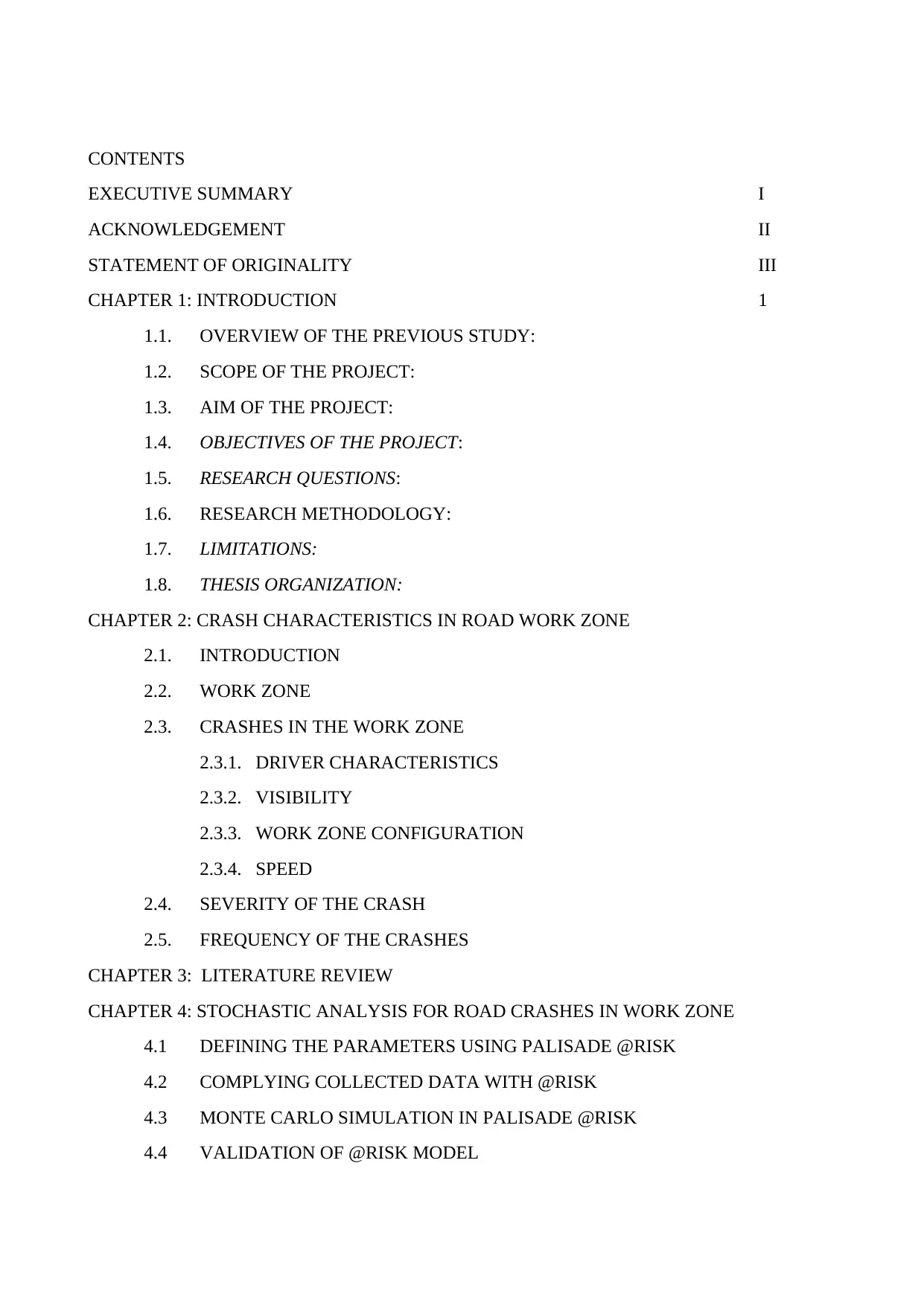
CONTENTS
EXECUTIVE SUMMARY I
ACKNOWLEDGEMENT II
STATEMENT OF ORIGINALITY III
CHAPTER 1: INTRODUCTION 1
1.1. OVERVIEW OF THE PREVIOUS STUDY:
1.2. SCOPE OF THE PROJECT:
1.3. AIM OF THE PROJECT:
1.4. OBJECTIVES OF THE PROJECT:
1.5. RESEARCH QUESTIONS:
1.6. RESEARCH METHODOLOGY:
1.7. LIMITATIONS:
1.8. THESIS ORGANIZATION:
CHAPTER 2: CRASH CHARACTERISTICS IN ROAD WORK ZONE
2.1. INTRODUCTION
2.2. WORK ZONE
2.3. CRASHES IN THE WORK ZONE
2.3.1. DRIVER CHARACTERISTICS
2.3.2. VISIBILITY
2.3.3. WORK ZONE CONFIGURATION
2.3.4. SPEED
2.4. SEVERITY OF THE CRASH
2.5. FREQUENCY OF THE CRASHES
CHAPTER 3: LITERATURE REVIEW
CHAPTER 4: STOCHASTIC ANALYSIS FOR ROAD CRASHES IN WORK ZONE
4.1 DEFINING THE PARAMETERS USING PALISADE @RISK
4.2 COMPLYING COLLECTED DATA WITH @RISK
4.3 MONTE CARLO SIMULATION IN PALISADE @RISK
4.4 VALIDATION OF @RISK MODEL
EXECUTIVE SUMMARY I
ACKNOWLEDGEMENT II
STATEMENT OF ORIGINALITY III
CHAPTER 1: INTRODUCTION 1
1.1. OVERVIEW OF THE PREVIOUS STUDY:
1.2. SCOPE OF THE PROJECT:
1.3. AIM OF THE PROJECT:
1.4. OBJECTIVES OF THE PROJECT:
1.5. RESEARCH QUESTIONS:
1.6. RESEARCH METHODOLOGY:
1.7. LIMITATIONS:
1.8. THESIS ORGANIZATION:
CHAPTER 2: CRASH CHARACTERISTICS IN ROAD WORK ZONE
2.1. INTRODUCTION
2.2. WORK ZONE
2.3. CRASHES IN THE WORK ZONE
2.3.1. DRIVER CHARACTERISTICS
2.3.2. VISIBILITY
2.3.3. WORK ZONE CONFIGURATION
2.3.4. SPEED
2.4. SEVERITY OF THE CRASH
2.5. FREQUENCY OF THE CRASHES
CHAPTER 3: LITERATURE REVIEW
CHAPTER 4: STOCHASTIC ANALYSIS FOR ROAD CRASHES IN WORK ZONE
4.1 DEFINING THE PARAMETERS USING PALISADE @RISK
4.2 COMPLYING COLLECTED DATA WITH @RISK
4.3 MONTE CARLO SIMULATION IN PALISADE @RISK
4.4 VALIDATION OF @RISK MODEL
Secure Best Marks with AI Grader
Need help grading? Try our AI Grader for instant feedback on your assignments.

4.5 RESULTS AND CONCLUSION FROM THE @RISK SIMULATION REPORT
CHAPTER 5. DEVELOPMENT OF CORRELATION BETWEEN ROAD
ACCIDENTS,THE VOLUME OF HEAVY VEHICLES,GEOMETRIC
DESIGNPARAMETERS ALONG WITH TRAFFIC OPERATING CONDITIONS
5.1. VOLUME OF HEAVY VEHICLES
5.2. TRAFFIC OPERTING CHARACTERISTICS
5.3. GEOMETRIC DESIGN PARAMETRS
CHAPTER 6. FUTURE WORKS AND RECOMMENDATIONS
IN THE WORK ZONE
CHAPTER 7. CONCLUSION
REFERENCES:
CHAPTER 5. DEVELOPMENT OF CORRELATION BETWEEN ROAD
ACCIDENTS,THE VOLUME OF HEAVY VEHICLES,GEOMETRIC
DESIGNPARAMETERS ALONG WITH TRAFFIC OPERATING CONDITIONS
5.1. VOLUME OF HEAVY VEHICLES
5.2. TRAFFIC OPERTING CHARACTERISTICS
5.3. GEOMETRIC DESIGN PARAMETRS
CHAPTER 6. FUTURE WORKS AND RECOMMENDATIONS
IN THE WORK ZONE
CHAPTER 7. CONCLUSION
REFERENCES:

EXECUTIVE SUMMARY
Work zone area and road crashes have been a common topic of research for the past few years. This
research will analyze the road crashes in work zone areas in Victoria, Australia. Work zone areas
are the designated lanes on a road that are allotted only for the work zone related vehicles to be used
in order to load or unload material and transportation of the workers. These lanes are not parking
lanes and regular traffic vehicles are not allowed to use these lanes until the work at the area is
complete. But due to various reasons, regular traffic may end up disrupting the rules and this can
lead to crashes that can range from a small dent in the car to fatal accidents. Reviewing articles
regarding the work zone related road crashes in different countries have been useful for reviewing
the reasons and understanding the different ways through which they can be avoided. They are,
1. Driver Characteristics
Different characteristics of drivers like stress, sleepiness, unsafe lane changes and using of
phones while driving have been identified as reasons for these accidents. The probabilry of this
happening is 0.28.
2. Visibility
When weather conditions are bad or the signage is placed improperly or the lightings during the
night work is not proper crashes can occur and have a probability of 0.33
3. Work Zone Configuration
Unsafe working conditions and improper planning and identification of work zone areas are also
reasons that lead to crashes with a probability of 0.46
4. Speed
While driving, if the speed limit is exceeded or the decisions regarding change of lanes or
braking are miscalculated, the probability of the crashes occurring is 0.40
Correlations between different aspects of road accidents have been developed like the volume of
heavy vehicles, highway geometric design parameters and the traffic operating characteristic.
The heavy vehicles that are mostly used for transportation of goods are trucks and use the
highways frequently. Therefore, they play an important role in the economy of Australia. Out of
the total crashes that are caused on these highways, 80% of them involve trucks and other heavy
vehicles. Traffic operations in the work zone area need to be maintained in order to avoid
accidents. Traffic signs, speed limits and educating the drivers about these signs has been
deemed important.
Different recommendations have been made regarding the improvements of safety in work
zones. They include:
1. Traffic and safety signs
2. Installation of safety measures
3. Line marking
4. Educating drivers and worker
5. Using crash barriers
6. Portable rumble strips
Work zone area and road crashes have been a common topic of research for the past few years. This
research will analyze the road crashes in work zone areas in Victoria, Australia. Work zone areas
are the designated lanes on a road that are allotted only for the work zone related vehicles to be used
in order to load or unload material and transportation of the workers. These lanes are not parking
lanes and regular traffic vehicles are not allowed to use these lanes until the work at the area is
complete. But due to various reasons, regular traffic may end up disrupting the rules and this can
lead to crashes that can range from a small dent in the car to fatal accidents. Reviewing articles
regarding the work zone related road crashes in different countries have been useful for reviewing
the reasons and understanding the different ways through which they can be avoided. They are,
1. Driver Characteristics
Different characteristics of drivers like stress, sleepiness, unsafe lane changes and using of
phones while driving have been identified as reasons for these accidents. The probabilry of this
happening is 0.28.
2. Visibility
When weather conditions are bad or the signage is placed improperly or the lightings during the
night work is not proper crashes can occur and have a probability of 0.33
3. Work Zone Configuration
Unsafe working conditions and improper planning and identification of work zone areas are also
reasons that lead to crashes with a probability of 0.46
4. Speed
While driving, if the speed limit is exceeded or the decisions regarding change of lanes or
braking are miscalculated, the probability of the crashes occurring is 0.40
Correlations between different aspects of road accidents have been developed like the volume of
heavy vehicles, highway geometric design parameters and the traffic operating characteristic.
The heavy vehicles that are mostly used for transportation of goods are trucks and use the
highways frequently. Therefore, they play an important role in the economy of Australia. Out of
the total crashes that are caused on these highways, 80% of them involve trucks and other heavy
vehicles. Traffic operations in the work zone area need to be maintained in order to avoid
accidents. Traffic signs, speed limits and educating the drivers about these signs has been
deemed important.
Different recommendations have been made regarding the improvements of safety in work
zones. They include:
1. Traffic and safety signs
2. Installation of safety measures
3. Line marking
4. Educating drivers and worker
5. Using crash barriers
6. Portable rumble strips
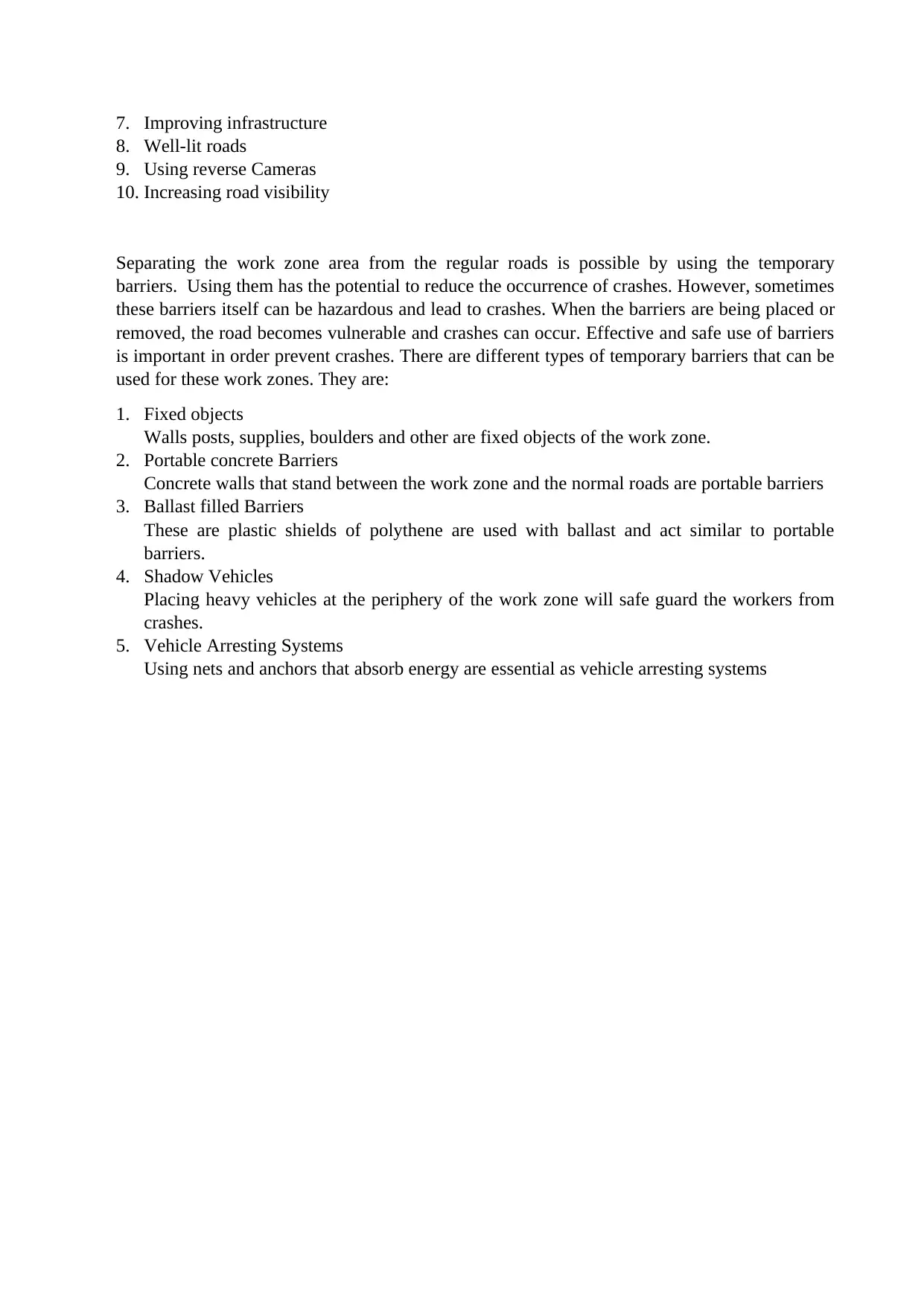
7. Improving infrastructure
8. Well-lit roads
9. Using reverse Cameras
10. Increasing road visibility
Separating the work zone area from the regular roads is possible by using the temporary
barriers. Using them has the potential to reduce the occurrence of crashes. However, sometimes
these barriers itself can be hazardous and lead to crashes. When the barriers are being placed or
removed, the road becomes vulnerable and crashes can occur. Effective and safe use of barriers
is important in order prevent crashes. There are different types of temporary barriers that can be
used for these work zones. They are:
1. Fixed objects
Walls posts, supplies, boulders and other are fixed objects of the work zone.
2. Portable concrete Barriers
Concrete walls that stand between the work zone and the normal roads are portable barriers
3. Ballast filled Barriers
These are plastic shields of polythene are used with ballast and act similar to portable
barriers.
4. Shadow Vehicles
Placing heavy vehicles at the periphery of the work zone will safe guard the workers from
crashes.
5. Vehicle Arresting Systems
Using nets and anchors that absorb energy are essential as vehicle arresting systems
8. Well-lit roads
9. Using reverse Cameras
10. Increasing road visibility
Separating the work zone area from the regular roads is possible by using the temporary
barriers. Using them has the potential to reduce the occurrence of crashes. However, sometimes
these barriers itself can be hazardous and lead to crashes. When the barriers are being placed or
removed, the road becomes vulnerable and crashes can occur. Effective and safe use of barriers
is important in order prevent crashes. There are different types of temporary barriers that can be
used for these work zones. They are:
1. Fixed objects
Walls posts, supplies, boulders and other are fixed objects of the work zone.
2. Portable concrete Barriers
Concrete walls that stand between the work zone and the normal roads are portable barriers
3. Ballast filled Barriers
These are plastic shields of polythene are used with ballast and act similar to portable
barriers.
4. Shadow Vehicles
Placing heavy vehicles at the periphery of the work zone will safe guard the workers from
crashes.
5. Vehicle Arresting Systems
Using nets and anchors that absorb energy are essential as vehicle arresting systems
Secure Best Marks with AI Grader
Need help grading? Try our AI Grader for instant feedback on your assignments.
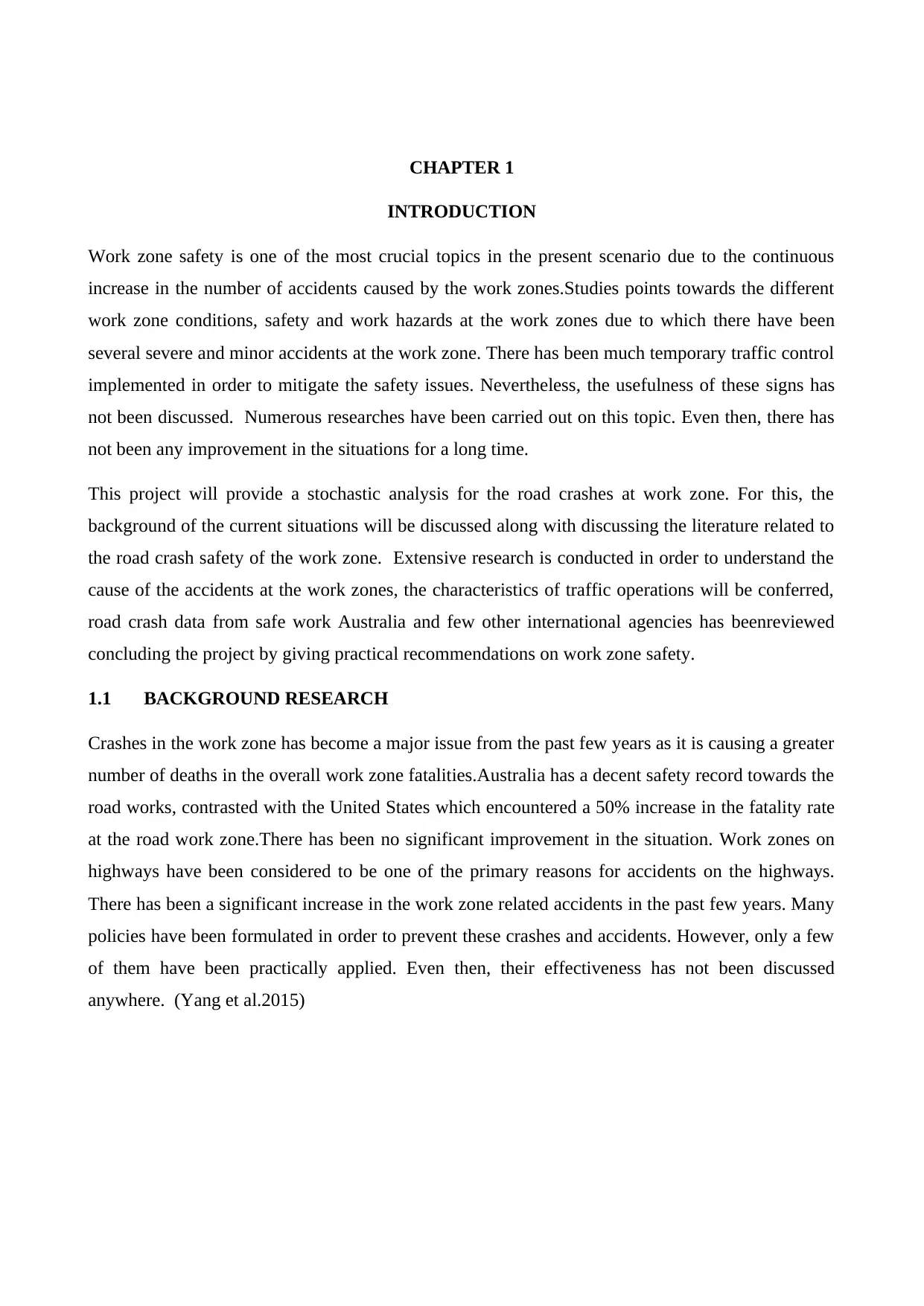
CHAPTER 1
INTRODUCTION
Work zone safety is one of the most crucial topics in the present scenario due to the continuous
increase in the number of accidents caused by the work zones.Studies points towards the different
work zone conditions, safety and work hazards at the work zones due to which there have been
several severe and minor accidents at the work zone. There has been much temporary traffic control
implemented in order to mitigate the safety issues. Nevertheless, the usefulness of these signs has
not been discussed. Numerous researches have been carried out on this topic. Even then, there has
not been any improvement in the situations for a long time.
This project will provide a stochastic analysis for the road crashes at work zone. For this, the
background of the current situations will be discussed along with discussing the literature related to
the road crash safety of the work zone. Extensive research is conducted in order to understand the
cause of the accidents at the work zones, the characteristics of traffic operations will be conferred,
road crash data from safe work Australia and few other international agencies has beenreviewed
concluding the project by giving practical recommendations on work zone safety.
1.1 BACKGROUND RESEARCH
Crashes in the work zone has become a major issue from the past few years as it is causing a greater
number of deaths in the overall work zone fatalities.Australia has a decent safety record towards the
road works, contrasted with the United States which encountered a 50% increase in the fatality rate
at the road work zone.There has been no significant improvement in the situation. Work zones on
highways have been considered to be one of the primary reasons for accidents on the highways.
There has been a significant increase in the work zone related accidents in the past few years. Many
policies have been formulated in order to prevent these crashes and accidents. However, only a few
of them have been practically applied. Even then, their effectiveness has not been discussed
anywhere. (Yang et al.2015)
INTRODUCTION
Work zone safety is one of the most crucial topics in the present scenario due to the continuous
increase in the number of accidents caused by the work zones.Studies points towards the different
work zone conditions, safety and work hazards at the work zones due to which there have been
several severe and minor accidents at the work zone. There has been much temporary traffic control
implemented in order to mitigate the safety issues. Nevertheless, the usefulness of these signs has
not been discussed. Numerous researches have been carried out on this topic. Even then, there has
not been any improvement in the situations for a long time.
This project will provide a stochastic analysis for the road crashes at work zone. For this, the
background of the current situations will be discussed along with discussing the literature related to
the road crash safety of the work zone. Extensive research is conducted in order to understand the
cause of the accidents at the work zones, the characteristics of traffic operations will be conferred,
road crash data from safe work Australia and few other international agencies has beenreviewed
concluding the project by giving practical recommendations on work zone safety.
1.1 BACKGROUND RESEARCH
Crashes in the work zone has become a major issue from the past few years as it is causing a greater
number of deaths in the overall work zone fatalities.Australia has a decent safety record towards the
road works, contrasted with the United States which encountered a 50% increase in the fatality rate
at the road work zone.There has been no significant improvement in the situation. Work zones on
highways have been considered to be one of the primary reasons for accidents on the highways.
There has been a significant increase in the work zone related accidents in the past few years. Many
policies have been formulated in order to prevent these crashes and accidents. However, only a few
of them have been practically applied. Even then, their effectiveness has not been discussed
anywhere. (Yang et al.2015)
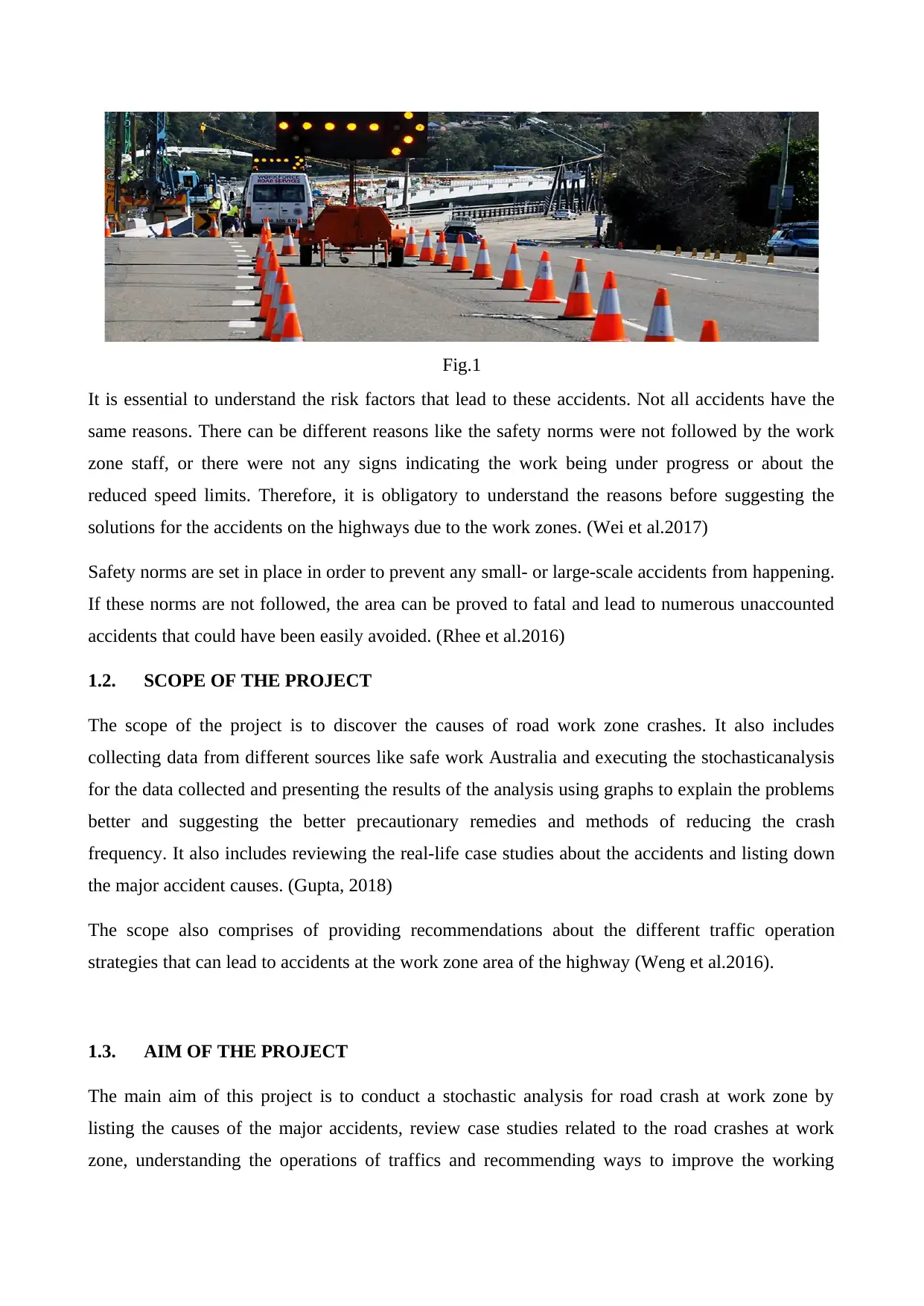
Fig.1
It is essential to understand the risk factors that lead to these accidents. Not all accidents have the
same reasons. There can be different reasons like the safety norms were not followed by the work
zone staff, or there were not any signs indicating the work being under progress or about the
reduced speed limits. Therefore, it is obligatory to understand the reasons before suggesting the
solutions for the accidents on the highways due to the work zones. (Wei et al.2017)
Safety norms are set in place in order to prevent any small- or large-scale accidents from happening.
If these norms are not followed, the area can be proved to fatal and lead to numerous unaccounted
accidents that could have been easily avoided. (Rhee et al.2016)
1.2. SCOPE OF THE PROJECT
The scope of the project is to discover the causes of road work zone crashes. It also includes
collecting data from different sources like safe work Australia and executing the stochasticanalysis
for the data collected and presenting the results of the analysis using graphs to explain the problems
better and suggesting the better precautionary remedies and methods of reducing the crash
frequency. It also includes reviewing the real-life case studies about the accidents and listing down
the major accident causes. (Gupta, 2018)
The scope also comprises of providing recommendations about the different traffic operation
strategies that can lead to accidents at the work zone area of the highway (Weng et al.2016).
1.3. AIM OF THE PROJECT
The main aim of this project is to conduct a stochastic analysis for road crash at work zone by
listing the causes of the major accidents, review case studies related to the road crashes at work
zone, understanding the operations of traffics and recommending ways to improve the working
It is essential to understand the risk factors that lead to these accidents. Not all accidents have the
same reasons. There can be different reasons like the safety norms were not followed by the work
zone staff, or there were not any signs indicating the work being under progress or about the
reduced speed limits. Therefore, it is obligatory to understand the reasons before suggesting the
solutions for the accidents on the highways due to the work zones. (Wei et al.2017)
Safety norms are set in place in order to prevent any small- or large-scale accidents from happening.
If these norms are not followed, the area can be proved to fatal and lead to numerous unaccounted
accidents that could have been easily avoided. (Rhee et al.2016)
1.2. SCOPE OF THE PROJECT
The scope of the project is to discover the causes of road work zone crashes. It also includes
collecting data from different sources like safe work Australia and executing the stochasticanalysis
for the data collected and presenting the results of the analysis using graphs to explain the problems
better and suggesting the better precautionary remedies and methods of reducing the crash
frequency. It also includes reviewing the real-life case studies about the accidents and listing down
the major accident causes. (Gupta, 2018)
The scope also comprises of providing recommendations about the different traffic operation
strategies that can lead to accidents at the work zone area of the highway (Weng et al.2016).
1.3. AIM OF THE PROJECT
The main aim of this project is to conduct a stochastic analysis for road crash at work zone by
listing the causes of the major accidents, review case studies related to the road crashes at work
zone, understanding the operations of traffics and recommending ways to improve the working

conditions around work zone area and collecting information about crashes and analysing it. (Sze
and Song, 2018)
1.4. THE OBJECTIVE OF THE PROJECT
Many objectives need to be fulfilled in order to complete the research on the road crash safety at
work zones (Osman et al.2016)
To review the frequent causes of crashes at the work zone.
To analyse crash fatality probability using Monte Carlo simulation with @risk software
Development of correlation between road accidents, the volume of heavy vehicles,
geometric design parameters of highway along with traffic operating characteristics.
To propose recommendations and methods for providing safety in the work zone.
and Song, 2018)
1.4. THE OBJECTIVE OF THE PROJECT
Many objectives need to be fulfilled in order to complete the research on the road crash safety at
work zones (Osman et al.2016)
To review the frequent causes of crashes at the work zone.
To analyse crash fatality probability using Monte Carlo simulation with @risk software
Development of correlation between road accidents, the volume of heavy vehicles,
geometric design parameters of highway along with traffic operating characteristics.
To propose recommendations and methods for providing safety in the work zone.
Paraphrase This Document
Need a fresh take? Get an instant paraphrase of this document with our AI Paraphraser

CHAPTER 2
CRASHES IN THE WORK ZONE
2.1 INTRODUCTION
This chapter explicates the meaning of a work zone, rules related to the work zone areas, accidents
occurring at the work zone areas in Victoria, Australia along with the causes of these accidents. The
accidents will be further be categorized according to the severity levels like fatal accidents, serious
injury accidents and minor injury accidents. This chapter will also calculate the frequency of
accidents. In order to articulate the solutions for preventing them in the future, the causes of these
accidents will be analysed thoroughly.
2.2 WORK ZONE
Victoria has been continuously working to improve and maintain the state by regularly constructing
new structures, like commercial and non-commercial buildings. While the construction is under
progress, a part of the main highway is specifically dedicated for the transport and construction
vehicles that carry the resources and manpower necessary for the construction. The work zones are
also used for loading unloading construction equipment that will be required at the site. These work
zone areas are approved by the City council of the specific city from the state of Victoria before the
construction work begins. The approval does not allow parking of vehicles in the dedicated work
zone areas. Failure of following the guidelines set by the city council will lead the owner of the
offending vehicle to be fined. (Perry et al.2018)
According to the Manual on Uniform Traffic Control Devices (MUTCD) the work zone area has
divided into four major parts which includes (FHWA 2003).
i) The advance warning area
ii) The transition area
iii) The activity area
iv) The termination area
When the vehicle entering the work zone area, drivers are cautioned about the hazardous upcoming
area in advanced warning area so that they can be careful and are directed into transition area from
the normal or usual road path. The transition area as often as possible structures a bottleneck which
could significantly reduce the traffic. The activity area is the place where the actual road work is
CRASHES IN THE WORK ZONE
2.1 INTRODUCTION
This chapter explicates the meaning of a work zone, rules related to the work zone areas, accidents
occurring at the work zone areas in Victoria, Australia along with the causes of these accidents. The
accidents will be further be categorized according to the severity levels like fatal accidents, serious
injury accidents and minor injury accidents. This chapter will also calculate the frequency of
accidents. In order to articulate the solutions for preventing them in the future, the causes of these
accidents will be analysed thoroughly.
2.2 WORK ZONE
Victoria has been continuously working to improve and maintain the state by regularly constructing
new structures, like commercial and non-commercial buildings. While the construction is under
progress, a part of the main highway is specifically dedicated for the transport and construction
vehicles that carry the resources and manpower necessary for the construction. The work zones are
also used for loading unloading construction equipment that will be required at the site. These work
zone areas are approved by the City council of the specific city from the state of Victoria before the
construction work begins. The approval does not allow parking of vehicles in the dedicated work
zone areas. Failure of following the guidelines set by the city council will lead the owner of the
offending vehicle to be fined. (Perry et al.2018)
According to the Manual on Uniform Traffic Control Devices (MUTCD) the work zone area has
divided into four major parts which includes (FHWA 2003).
i) The advance warning area
ii) The transition area
iii) The activity area
iv) The termination area
When the vehicle entering the work zone area, drivers are cautioned about the hazardous upcoming
area in advanced warning area so that they can be careful and are directed into transition area from
the normal or usual road path. The transition area as often as possible structures a bottleneck which
could significantly reduce the traffic. The activity area is the place where the actual road work is
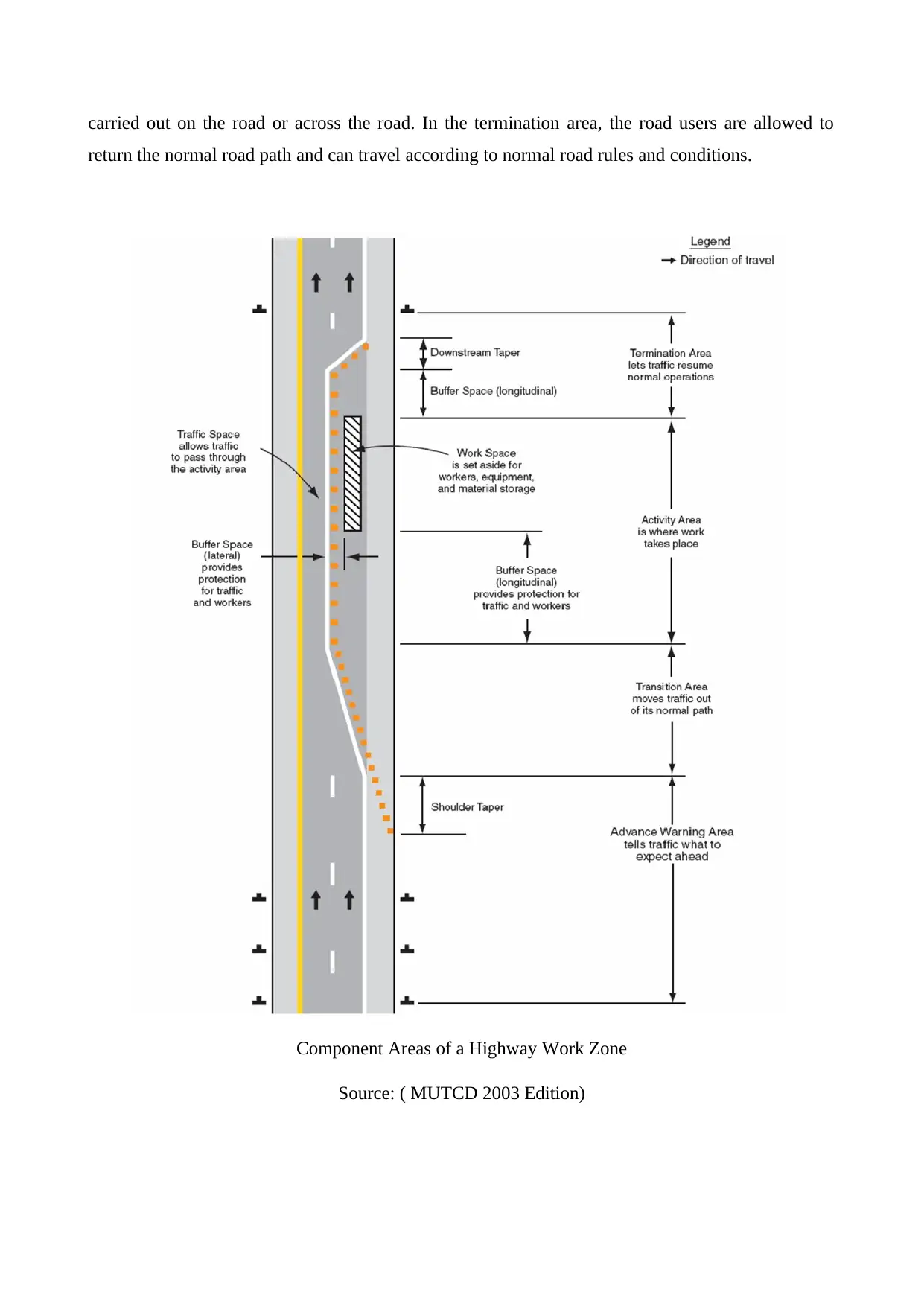
carried out on the road or across the road. In the termination area, the road users are allowed to
return the normal road path and can travel according to normal road rules and conditions.
Component Areas of a Highway Work Zone
Source: ( MUTCD 2003 Edition)
return the normal road path and can travel according to normal road rules and conditions.
Component Areas of a Highway Work Zone
Source: ( MUTCD 2003 Edition)
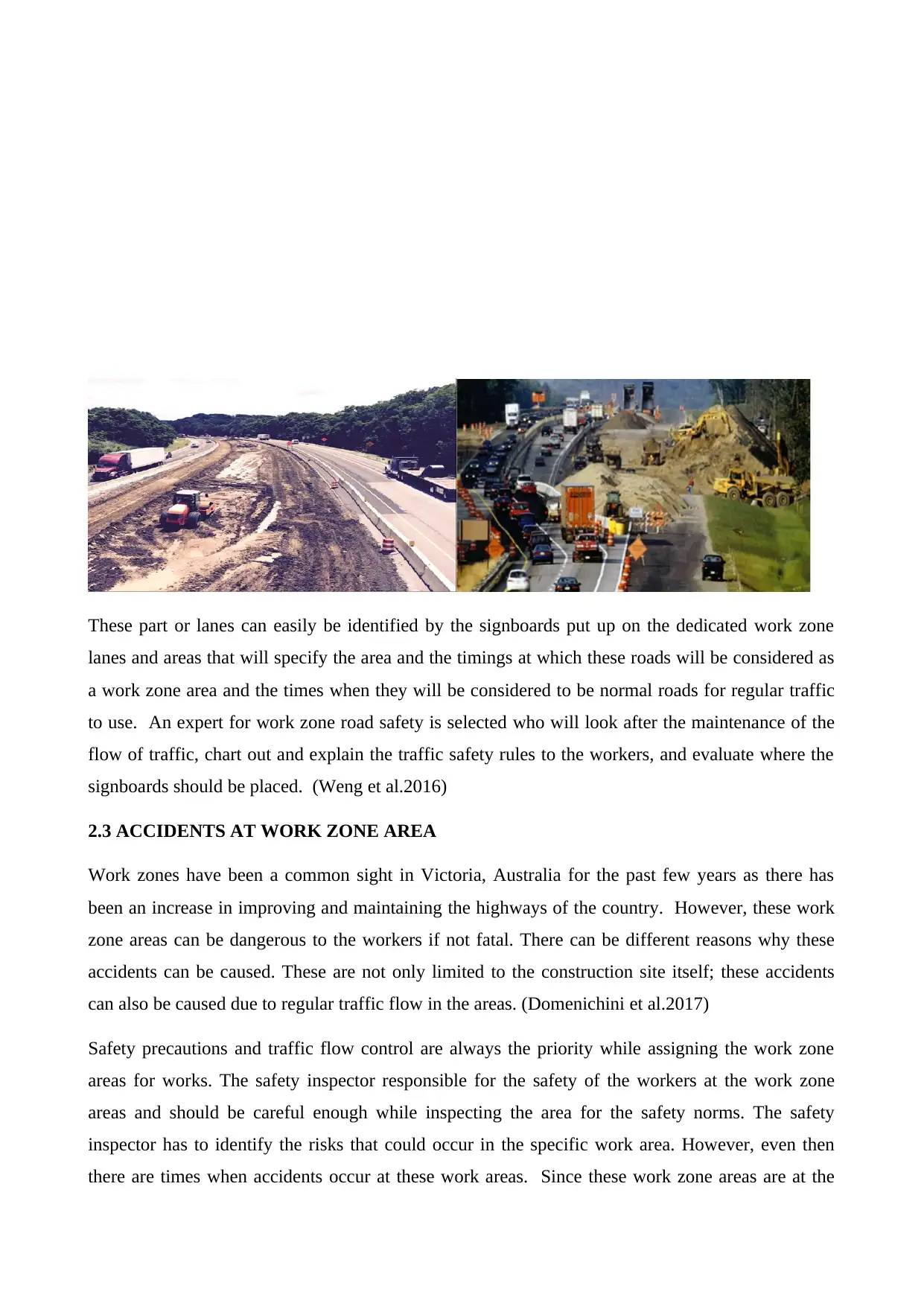
These part or lanes can easily be identified by the signboards put up on the dedicated work zone
lanes and areas that will specify the area and the timings at which these roads will be considered as
a work zone area and the times when they will be considered to be normal roads for regular traffic
to use. An expert for work zone road safety is selected who will look after the maintenance of the
flow of traffic, chart out and explain the traffic safety rules to the workers, and evaluate where the
signboards should be placed. (Weng et al.2016)
2.3 ACCIDENTS AT WORK ZONE AREA
Work zones have been a common sight in Victoria, Australia for the past few years as there has
been an increase in improving and maintaining the highways of the country. However, these work
zone areas can be dangerous to the workers if not fatal. There can be different reasons why these
accidents can be caused. These are not only limited to the construction site itself; these accidents
can also be caused due to regular traffic flow in the areas. (Domenichini et al.2017)
Safety precautions and traffic flow control are always the priority while assigning the work zone
areas for works. The safety inspector responsible for the safety of the workers at the work zone
areas and should be careful enough while inspecting the area for the safety norms. The safety
inspector has to identify the risks that could occur in the specific work area. However, even then
there are times when accidents occur at these work areas. Since these work zone areas are at the
lanes and areas that will specify the area and the timings at which these roads will be considered as
a work zone area and the times when they will be considered to be normal roads for regular traffic
to use. An expert for work zone road safety is selected who will look after the maintenance of the
flow of traffic, chart out and explain the traffic safety rules to the workers, and evaluate where the
signboards should be placed. (Weng et al.2016)
2.3 ACCIDENTS AT WORK ZONE AREA
Work zones have been a common sight in Victoria, Australia for the past few years as there has
been an increase in improving and maintaining the highways of the country. However, these work
zone areas can be dangerous to the workers if not fatal. There can be different reasons why these
accidents can be caused. These are not only limited to the construction site itself; these accidents
can also be caused due to regular traffic flow in the areas. (Domenichini et al.2017)
Safety precautions and traffic flow control are always the priority while assigning the work zone
areas for works. The safety inspector responsible for the safety of the workers at the work zone
areas and should be careful enough while inspecting the area for the safety norms. The safety
inspector has to identify the risks that could occur in the specific work area. However, even then
there are times when accidents occur at these work areas. Since these work zone areas are at the
Secure Best Marks with AI Grader
Need help grading? Try our AI Grader for instant feedback on your assignments.

main highways of the state, the workers at the work zone area are bound to come in contact with
high speeding vehicles. Accidents that can be caused at these areas may include: (Weng et al.2015)
The following tables explains the number of fatalities and the major causes of the fatalities in the
work zone from 2007 to 20017.
Source: (Work safe Australia)
Statistics from Work safe Australia between 2007 and 2017.
high speeding vehicles. Accidents that can be caused at these areas may include: (Weng et al.2015)
The following tables explains the number of fatalities and the major causes of the fatalities in the
work zone from 2007 to 20017.
Source: (Work safe Australia)
Statistics from Work safe Australia between 2007 and 2017.
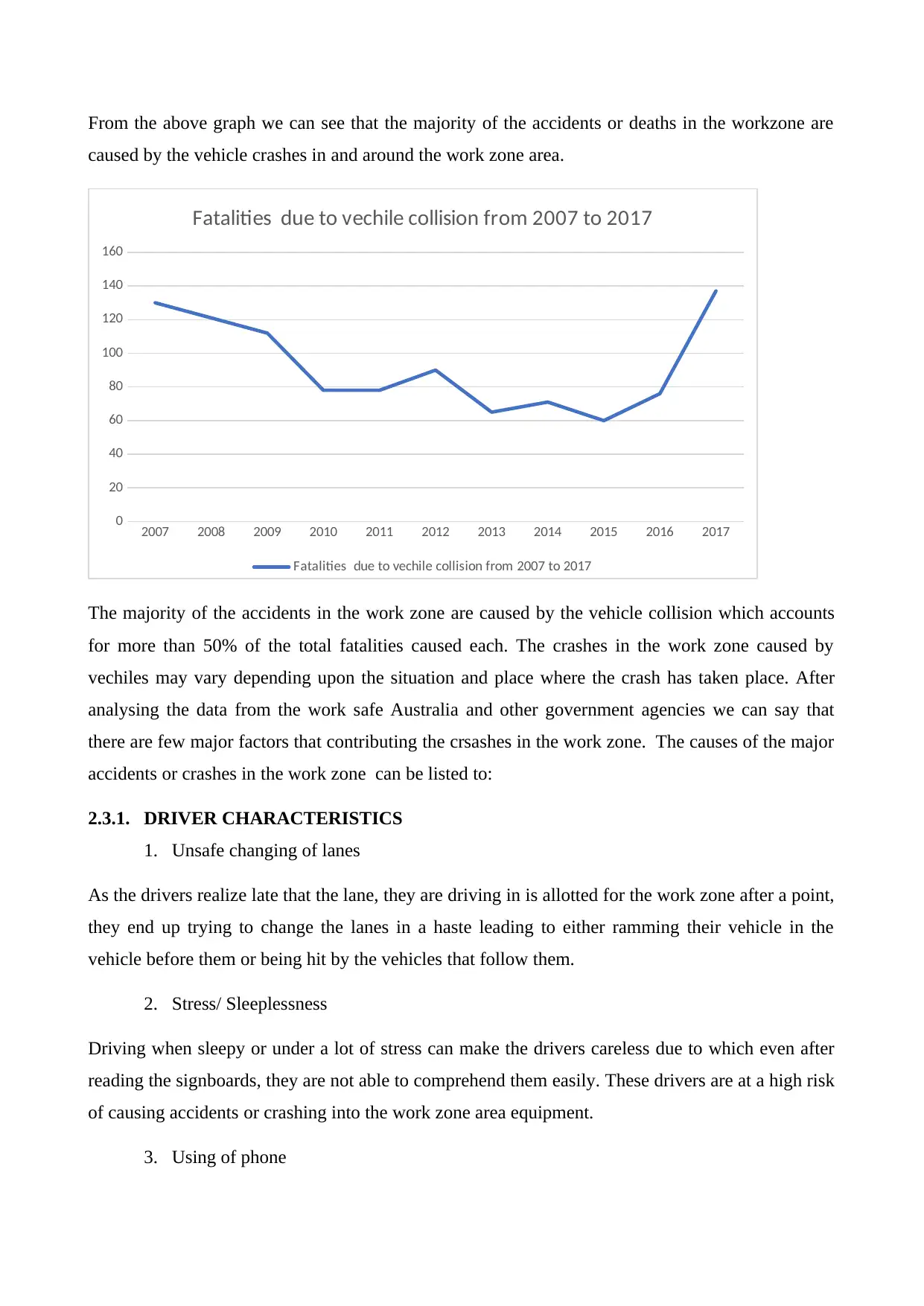
From the above graph we can see that the majority of the accidents or deaths in the workzone are
caused by the vehicle crashes in and around the work zone area.
2007 2008 2009 2010 2011 2012 2013 2014 2015 2016 2017
0
20
40
60
80
100
120
140
160
Fatalities due to vechile collision from 2007 to 2017
Fatalities due to vechile collision from 2007 to 2017
The majority of the accidents in the work zone are caused by the vehicle collision which accounts
for more than 50% of the total fatalities caused each. The crashes in the work zone caused by
vechiles may vary depending upon the situation and place where the crash has taken place. After
analysing the data from the work safe Australia and other government agencies we can say that
there are few major factors that contributing the crsashes in the work zone. The causes of the major
accidents or crashes in the work zone can be listed to:
2.3.1. DRIVER CHARACTERISTICS
1. Unsafe changing of lanes
As the drivers realize late that the lane, they are driving in is allotted for the work zone after a point,
they end up trying to change the lanes in a haste leading to either ramming their vehicle in the
vehicle before them or being hit by the vehicles that follow them.
2. Stress/ Sleeplessness
Driving when sleepy or under a lot of stress can make the drivers careless due to which even after
reading the signboards, they are not able to comprehend them easily. These drivers are at a high risk
of causing accidents or crashing into the work zone area equipment.
3. Using of phone
caused by the vehicle crashes in and around the work zone area.
2007 2008 2009 2010 2011 2012 2013 2014 2015 2016 2017
0
20
40
60
80
100
120
140
160
Fatalities due to vechile collision from 2007 to 2017
Fatalities due to vechile collision from 2007 to 2017
The majority of the accidents in the work zone are caused by the vehicle collision which accounts
for more than 50% of the total fatalities caused each. The crashes in the work zone caused by
vechiles may vary depending upon the situation and place where the crash has taken place. After
analysing the data from the work safe Australia and other government agencies we can say that
there are few major factors that contributing the crsashes in the work zone. The causes of the major
accidents or crashes in the work zone can be listed to:
2.3.1. DRIVER CHARACTERISTICS
1. Unsafe changing of lanes
As the drivers realize late that the lane, they are driving in is allotted for the work zone after a point,
they end up trying to change the lanes in a haste leading to either ramming their vehicle in the
vehicle before them or being hit by the vehicles that follow them.
2. Stress/ Sleeplessness
Driving when sleepy or under a lot of stress can make the drivers careless due to which even after
reading the signboards, they are not able to comprehend them easily. These drivers are at a high risk
of causing accidents or crashing into the work zone area equipment.
3. Using of phone

Using phone has been strictly prohibited while driving as it distracts the drivers from the roads that
can lead to accidents even on normal roads. Using a phone near work zone areas will definitely lead
to crashes.
2.3.2. VISIBILITY
1. Bad weather conditions
Weather conditions like strong rainfall and / or snowfall make it difficult for the drivers to see the
road in front of them which can result in crash.
2. Improper signing
When the workers are careless while putting up proper signs for change in lanes and diversions of
roads, crashes are eminent.
3. Night work
Works that go on at night will not be visible if the work zone area is not lit up well.
Source: (A Berces, 2013)
2.3.3 WORK ZONE CONFIGURATION
1. Work Zone Area
Improper planning and marking of the work zone areas will result in crashes.
2. Working conditions
Working conditions at the work zone areas are also responsible for the different crashes that occur
in the work zone areas.
can lead to accidents even on normal roads. Using a phone near work zone areas will definitely lead
to crashes.
2.3.2. VISIBILITY
1. Bad weather conditions
Weather conditions like strong rainfall and / or snowfall make it difficult for the drivers to see the
road in front of them which can result in crash.
2. Improper signing
When the workers are careless while putting up proper signs for change in lanes and diversions of
roads, crashes are eminent.
3. Night work
Works that go on at night will not be visible if the work zone area is not lit up well.
Source: (A Berces, 2013)
2.3.3 WORK ZONE CONFIGURATION
1. Work Zone Area
Improper planning and marking of the work zone areas will result in crashes.
2. Working conditions
Working conditions at the work zone areas are also responsible for the different crashes that occur
in the work zone areas.
Paraphrase This Document
Need a fresh take? Get an instant paraphrase of this document with our AI Paraphraser
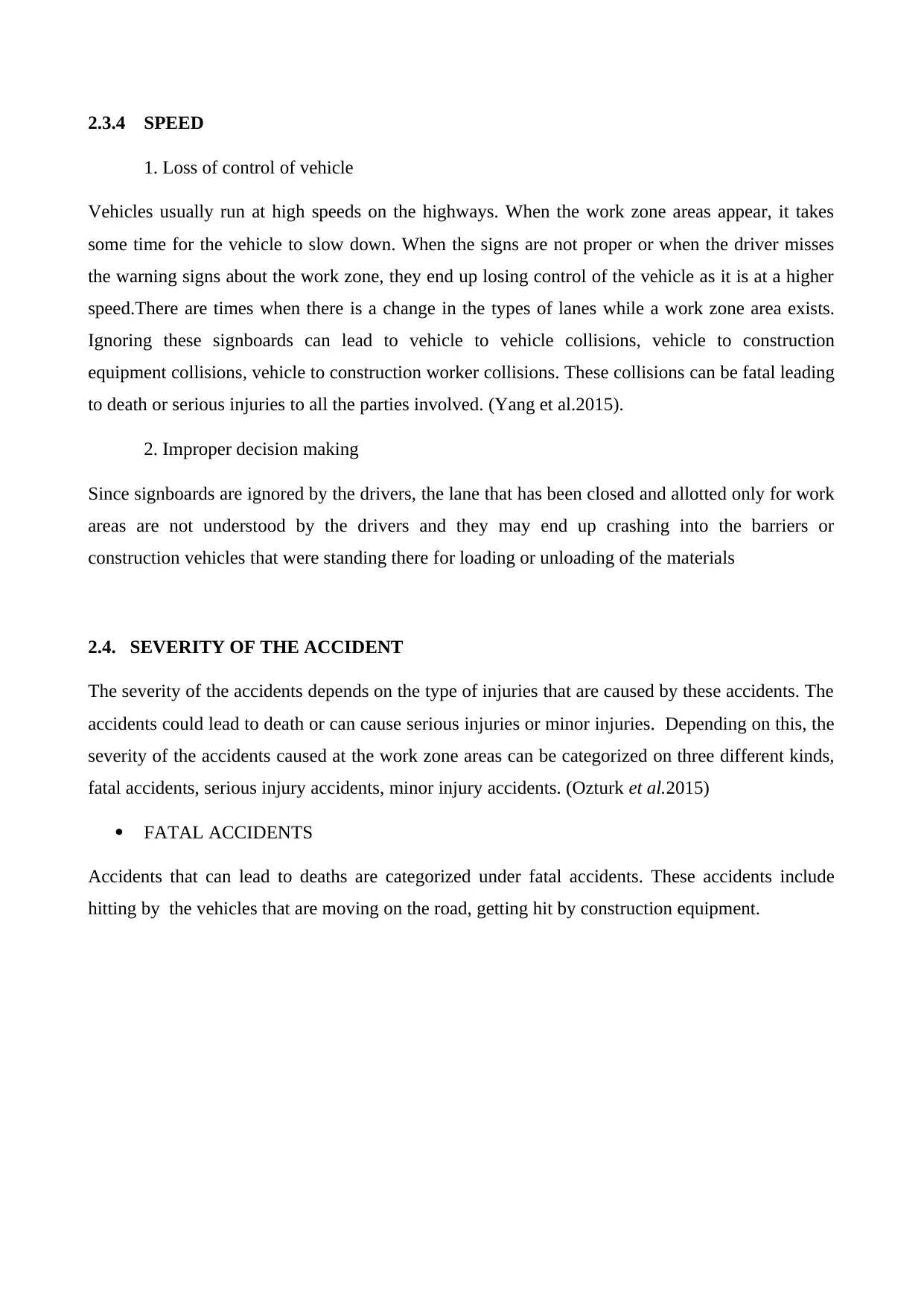
2.3.4 SPEED
1. Loss of control of vehicle
Vehicles usually run at high speeds on the highways. When the work zone areas appear, it takes
some time for the vehicle to slow down. When the signs are not proper or when the driver misses
the warning signs about the work zone, they end up losing control of the vehicle as it is at a higher
speed.There are times when there is a change in the types of lanes while a work zone area exists.
Ignoring these signboards can lead to vehicle to vehicle collisions, vehicle to construction
equipment collisions, vehicle to construction worker collisions. These collisions can be fatal leading
to death or serious injuries to all the parties involved. (Yang et al.2015).
2. Improper decision making
Since signboards are ignored by the drivers, the lane that has been closed and allotted only for work
areas are not understood by the drivers and they may end up crashing into the barriers or
construction vehicles that were standing there for loading or unloading of the materials
2.4. SEVERITY OF THE ACCIDENT
The severity of the accidents depends on the type of injuries that are caused by these accidents. The
accidents could lead to death or can cause serious injuries or minor injuries. Depending on this, the
severity of the accidents caused at the work zone areas can be categorized on three different kinds,
fatal accidents, serious injury accidents, minor injury accidents. (Ozturk et al.2015)
FATAL ACCIDENTS
Accidents that can lead to deaths are categorized under fatal accidents. These accidents include
hitting by the vehicles that are moving on the road, getting hit by construction equipment.
1. Loss of control of vehicle
Vehicles usually run at high speeds on the highways. When the work zone areas appear, it takes
some time for the vehicle to slow down. When the signs are not proper or when the driver misses
the warning signs about the work zone, they end up losing control of the vehicle as it is at a higher
speed.There are times when there is a change in the types of lanes while a work zone area exists.
Ignoring these signboards can lead to vehicle to vehicle collisions, vehicle to construction
equipment collisions, vehicle to construction worker collisions. These collisions can be fatal leading
to death or serious injuries to all the parties involved. (Yang et al.2015).
2. Improper decision making
Since signboards are ignored by the drivers, the lane that has been closed and allotted only for work
areas are not understood by the drivers and they may end up crashing into the barriers or
construction vehicles that were standing there for loading or unloading of the materials
2.4. SEVERITY OF THE ACCIDENT
The severity of the accidents depends on the type of injuries that are caused by these accidents. The
accidents could lead to death or can cause serious injuries or minor injuries. Depending on this, the
severity of the accidents caused at the work zone areas can be categorized on three different kinds,
fatal accidents, serious injury accidents, minor injury accidents. (Ozturk et al.2015)
FATAL ACCIDENTS
Accidents that can lead to deaths are categorized under fatal accidents. These accidents include
hitting by the vehicles that are moving on the road, getting hit by construction equipment.
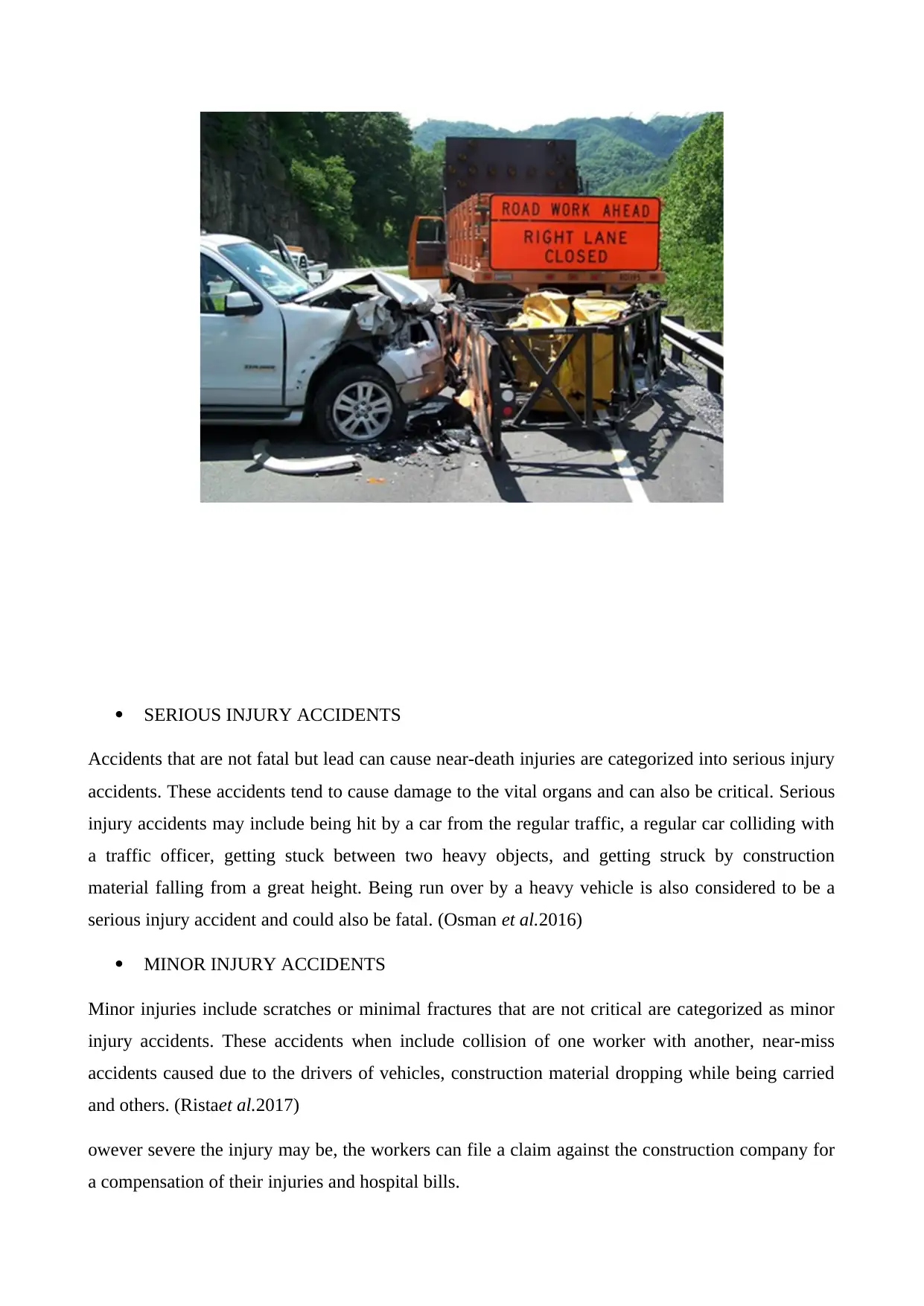
SERIOUS INJURY ACCIDENTS
Accidents that are not fatal but lead can cause near-death injuries are categorized into serious injury
accidents. These accidents tend to cause damage to the vital organs and can also be critical. Serious
injury accidents may include being hit by a car from the regular traffic, a regular car colliding with
a traffic officer, getting stuck between two heavy objects, and getting struck by construction
material falling from a great height. Being run over by a heavy vehicle is also considered to be a
serious injury accident and could also be fatal. (Osman et al.2016)
MINOR INJURY ACCIDENTS
Minor injuries include scratches or minimal fractures that are not critical are categorized as minor
injury accidents. These accidents when include collision of one worker with another, near-miss
accidents caused due to the drivers of vehicles, construction material dropping while being carried
and others. (Ristaet al.2017)
owever severe the injury may be, the workers can file a claim against the construction company for
a compensation of their injuries and hospital bills.
Accidents that are not fatal but lead can cause near-death injuries are categorized into serious injury
accidents. These accidents tend to cause damage to the vital organs and can also be critical. Serious
injury accidents may include being hit by a car from the regular traffic, a regular car colliding with
a traffic officer, getting stuck between two heavy objects, and getting struck by construction
material falling from a great height. Being run over by a heavy vehicle is also considered to be a
serious injury accident and could also be fatal. (Osman et al.2016)
MINOR INJURY ACCIDENTS
Minor injuries include scratches or minimal fractures that are not critical are categorized as minor
injury accidents. These accidents when include collision of one worker with another, near-miss
accidents caused due to the drivers of vehicles, construction material dropping while being carried
and others. (Ristaet al.2017)
owever severe the injury may be, the workers can file a claim against the construction company for
a compensation of their injuries and hospital bills.

2.5. FREQUENCY OF THE ACCIDENT
The frequency of accidents is the amount of time an accident occurs during a certain period. The
following table was reported by Safety Australia to describe the different causes of injuries and
fatalities in the work zone areas. The reason for injuries includes body stressing, falls, trips and
slips, and hit by a movie vehicle while for fatalities it can fall from heights, vehicle incidents and
unwanted contact with electricity. (Shah and Alqami, 2018)
Reason for injury Percentage
Body stressing 37
Falls, trips and slips 28
Hit by moving vehicle 14
Reason fatalities Percentage
Falls from a height 28
Vehicle incidents 16
Contact with electricity 15
The above table describes the frequency of the reason of injury and the reason of fatality.
According to the table, 37% of the injuries are caused due to body stressing work like picking up
heavy objects and over exerting oneself. 28% of the injuries caused are related to falls, slips and
trips while 14% injuries are caused due to getting hit by the vehicles.
On the other hand, fatalities at a work zone area can be caused by numerous reasons. 28% are
caused by falling from heights that are above 10 metres and such falls can lead to deaths. 16%
fatalities are a result of collisions with vehicles or collision of two or more vehicles while 15% are
caused due coming in contact with either a live wire or an unattended contact with electrical units.
CHAPTER 3
LITERATURE REVIEW
The frequency of accidents is the amount of time an accident occurs during a certain period. The
following table was reported by Safety Australia to describe the different causes of injuries and
fatalities in the work zone areas. The reason for injuries includes body stressing, falls, trips and
slips, and hit by a movie vehicle while for fatalities it can fall from heights, vehicle incidents and
unwanted contact with electricity. (Shah and Alqami, 2018)
Reason for injury Percentage
Body stressing 37
Falls, trips and slips 28
Hit by moving vehicle 14
Reason fatalities Percentage
Falls from a height 28
Vehicle incidents 16
Contact with electricity 15
The above table describes the frequency of the reason of injury and the reason of fatality.
According to the table, 37% of the injuries are caused due to body stressing work like picking up
heavy objects and over exerting oneself. 28% of the injuries caused are related to falls, slips and
trips while 14% injuries are caused due to getting hit by the vehicles.
On the other hand, fatalities at a work zone area can be caused by numerous reasons. 28% are
caused by falling from heights that are above 10 metres and such falls can lead to deaths. 16%
fatalities are a result of collisions with vehicles or collision of two or more vehicles while 15% are
caused due coming in contact with either a live wire or an unattended contact with electrical units.
CHAPTER 3
LITERATURE REVIEW
Secure Best Marks with AI Grader
Need help grading? Try our AI Grader for instant feedback on your assignments.
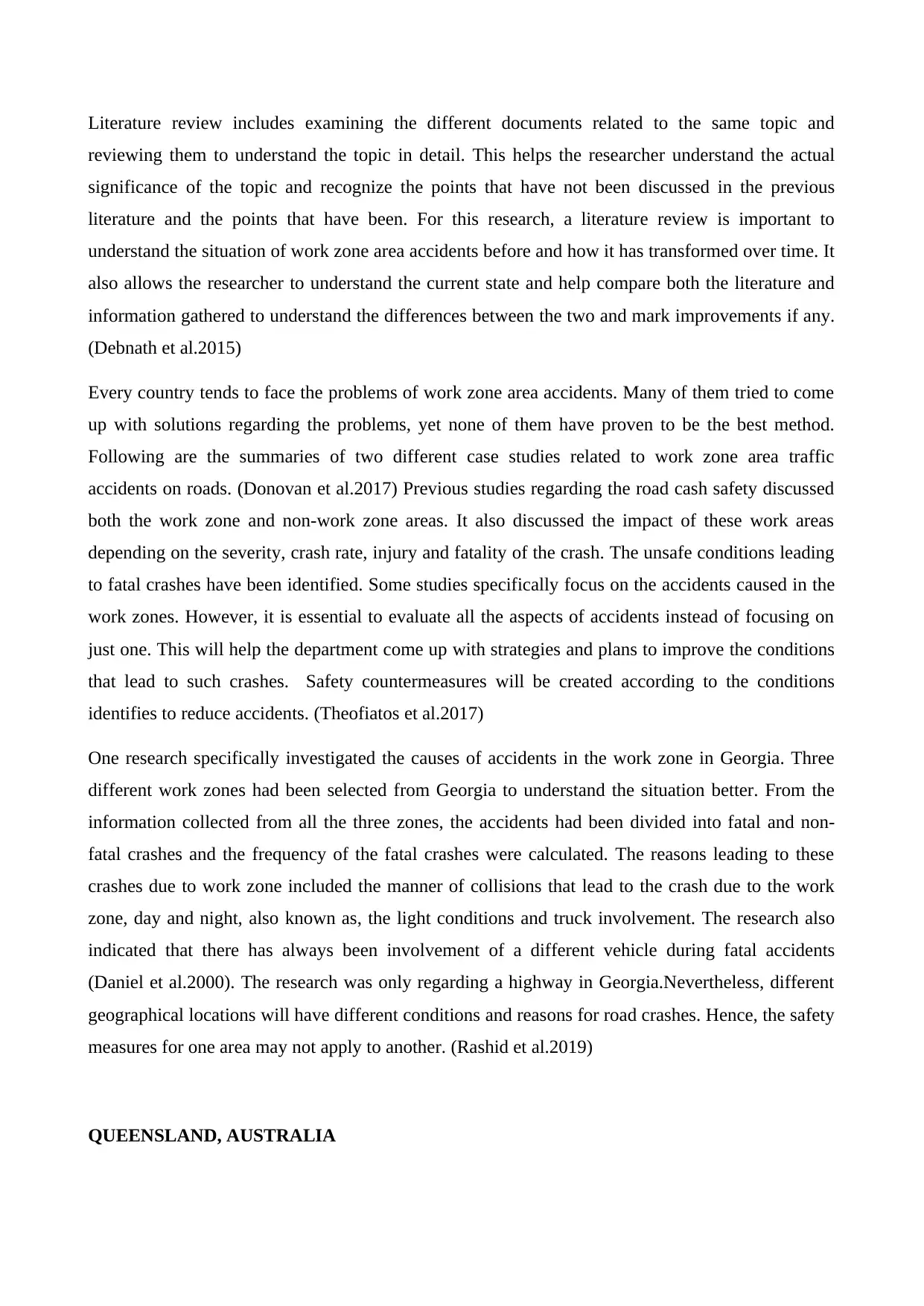
Literature review includes examining the different documents related to the same topic and
reviewing them to understand the topic in detail. This helps the researcher understand the actual
significance of the topic and recognize the points that have not been discussed in the previous
literature and the points that have been. For this research, a literature review is important to
understand the situation of work zone area accidents before and how it has transformed over time. It
also allows the researcher to understand the current state and help compare both the literature and
information gathered to understand the differences between the two and mark improvements if any.
(Debnath et al.2015)
Every country tends to face the problems of work zone area accidents. Many of them tried to come
up with solutions regarding the problems, yet none of them have proven to be the best method.
Following are the summaries of two different case studies related to work zone area traffic
accidents on roads. (Donovan et al.2017) Previous studies regarding the road cash safety discussed
both the work zone and non-work zone areas. It also discussed the impact of these work areas
depending on the severity, crash rate, injury and fatality of the crash. The unsafe conditions leading
to fatal crashes have been identified. Some studies specifically focus on the accidents caused in the
work zones. However, it is essential to evaluate all the aspects of accidents instead of focusing on
just one. This will help the department come up with strategies and plans to improve the conditions
that lead to such crashes. Safety countermeasures will be created according to the conditions
identifies to reduce accidents. (Theofiatos et al.2017)
One research specifically investigated the causes of accidents in the work zone in Georgia. Three
different work zones had been selected from Georgia to understand the situation better. From the
information collected from all the three zones, the accidents had been divided into fatal and non-
fatal crashes and the frequency of the fatal crashes were calculated. The reasons leading to these
crashes due to work zone included the manner of collisions that lead to the crash due to the work
zone, day and night, also known as, the light conditions and truck involvement. The research also
indicated that there has always been involvement of a different vehicle during fatal accidents
(Daniel et al.2000). The research was only regarding a highway in Georgia.Nevertheless, different
geographical locations will have different conditions and reasons for road crashes. Hence, the safety
measures for one area may not apply to another. (Rashid et al.2019)
QUEENSLAND, AUSTRALIA
reviewing them to understand the topic in detail. This helps the researcher understand the actual
significance of the topic and recognize the points that have not been discussed in the previous
literature and the points that have been. For this research, a literature review is important to
understand the situation of work zone area accidents before and how it has transformed over time. It
also allows the researcher to understand the current state and help compare both the literature and
information gathered to understand the differences between the two and mark improvements if any.
(Debnath et al.2015)
Every country tends to face the problems of work zone area accidents. Many of them tried to come
up with solutions regarding the problems, yet none of them have proven to be the best method.
Following are the summaries of two different case studies related to work zone area traffic
accidents on roads. (Donovan et al.2017) Previous studies regarding the road cash safety discussed
both the work zone and non-work zone areas. It also discussed the impact of these work areas
depending on the severity, crash rate, injury and fatality of the crash. The unsafe conditions leading
to fatal crashes have been identified. Some studies specifically focus on the accidents caused in the
work zones. However, it is essential to evaluate all the aspects of accidents instead of focusing on
just one. This will help the department come up with strategies and plans to improve the conditions
that lead to such crashes. Safety countermeasures will be created according to the conditions
identifies to reduce accidents. (Theofiatos et al.2017)
One research specifically investigated the causes of accidents in the work zone in Georgia. Three
different work zones had been selected from Georgia to understand the situation better. From the
information collected from all the three zones, the accidents had been divided into fatal and non-
fatal crashes and the frequency of the fatal crashes were calculated. The reasons leading to these
crashes due to work zone included the manner of collisions that lead to the crash due to the work
zone, day and night, also known as, the light conditions and truck involvement. The research also
indicated that there has always been involvement of a different vehicle during fatal accidents
(Daniel et al.2000). The research was only regarding a highway in Georgia.Nevertheless, different
geographical locations will have different conditions and reasons for road crashes. Hence, the safety
measures for one area may not apply to another. (Rashid et al.2019)
QUEENSLAND, AUSTRALIA

A research was carried out about the views of workers of road works on the types of accidents
caused at the work zone areas.
The research depended on the process of developing roads in the state of Queensland and Australia
as a whole. It was important to understand the common trends between the different fatalities that
occurred at the work sites. The reason for accidents was known; however, since there was no
information available about the accidents, it was difficult to analyse and examine the plans for
preventing the accidents. There were a lot of roadwork accidents that were happening; however,
these accidents weren't all reported leading to a shortage in information about the crash, crash rate
and crash severity is available. It had become imperative to understand the reasons and causes for
these accidents completely. It was important so that preventive measures for these accidents and
crashes would have been created to safeguard the other workers from facing the same fate as those
before them. Understanding the accidents and safety hazards from the point of views of the workers
have not been researched to its full extent. However, the studies done by different researchers from
the worker's point of view in the different countries have helped the researchers identify the
preventive measures for the safety at work zone areas.
In this research, a total of 66 workers were interviewed to understand the situation well and carry
out the research successfully. These participants were divided into two groups and belonged from
different locations of all working at a road work zone. These interviews conducted by two different
researchers either personally or through telephonic interviews. After this, the results from both the
researchers were combined so that it became easy to analyse and simple to draw up evaluations.
For the analysis, qualitative methods were used where the interviews that were taped and transcript
were analyzed to understand the patterns, insights and in-depth evaluation of the responses
recorded. This helped the research understand the underlying problems faced by road workers.
Through the results, the researchers were able to derive the common types of incidents that occur at
the road works. The most common type of incidents included the vehicles driving into the work
area, approaches the work area or in the middle of the work zone. The other incidents included
traffic controller being hit by the vehicle, and two or more public vehicles colliding with each other.
All these findings led to believe that road work area accidents were meant to be the most difficult
and dangerous kinds of accidents that could even lead to fatalities. Vehicle drivers needed to be
careful about the change in the speed limits that were required when approaching the work zone
areas. Along with this, the changes in lane types should also be looked out for.
caused at the work zone areas.
The research depended on the process of developing roads in the state of Queensland and Australia
as a whole. It was important to understand the common trends between the different fatalities that
occurred at the work sites. The reason for accidents was known; however, since there was no
information available about the accidents, it was difficult to analyse and examine the plans for
preventing the accidents. There were a lot of roadwork accidents that were happening; however,
these accidents weren't all reported leading to a shortage in information about the crash, crash rate
and crash severity is available. It had become imperative to understand the reasons and causes for
these accidents completely. It was important so that preventive measures for these accidents and
crashes would have been created to safeguard the other workers from facing the same fate as those
before them. Understanding the accidents and safety hazards from the point of views of the workers
have not been researched to its full extent. However, the studies done by different researchers from
the worker's point of view in the different countries have helped the researchers identify the
preventive measures for the safety at work zone areas.
In this research, a total of 66 workers were interviewed to understand the situation well and carry
out the research successfully. These participants were divided into two groups and belonged from
different locations of all working at a road work zone. These interviews conducted by two different
researchers either personally or through telephonic interviews. After this, the results from both the
researchers were combined so that it became easy to analyse and simple to draw up evaluations.
For the analysis, qualitative methods were used where the interviews that were taped and transcript
were analyzed to understand the patterns, insights and in-depth evaluation of the responses
recorded. This helped the research understand the underlying problems faced by road workers.
Through the results, the researchers were able to derive the common types of incidents that occur at
the road works. The most common type of incidents included the vehicles driving into the work
area, approaches the work area or in the middle of the work zone. The other incidents included
traffic controller being hit by the vehicle, and two or more public vehicles colliding with each other.
All these findings led to believe that road work area accidents were meant to be the most difficult
and dangerous kinds of accidents that could even lead to fatalities. Vehicle drivers needed to be
careful about the change in the speed limits that were required when approaching the work zone
areas. Along with this, the changes in lane types should also be looked out for.
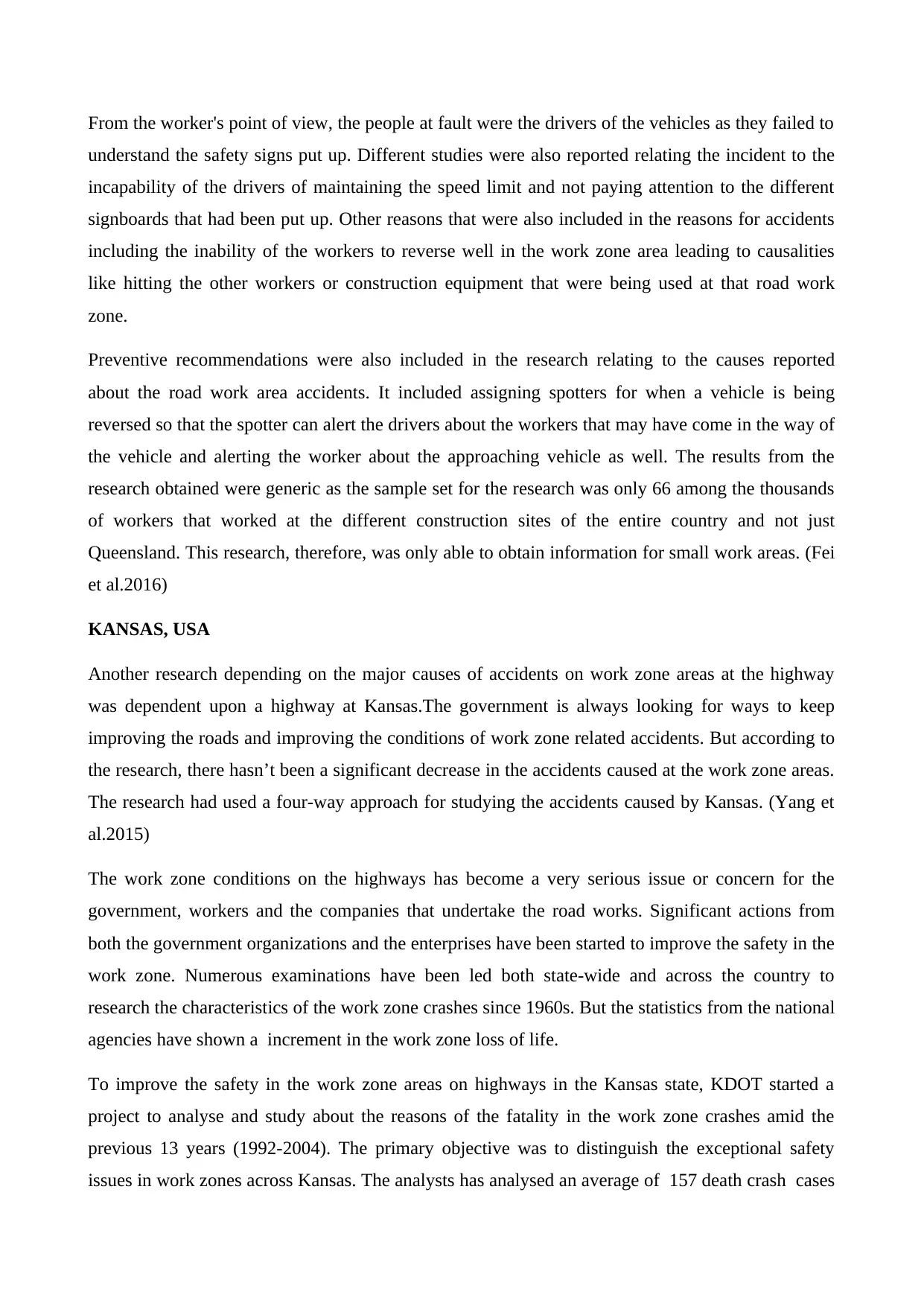
From the worker's point of view, the people at fault were the drivers of the vehicles as they failed to
understand the safety signs put up. Different studies were also reported relating the incident to the
incapability of the drivers of maintaining the speed limit and not paying attention to the different
signboards that had been put up. Other reasons that were also included in the reasons for accidents
including the inability of the workers to reverse well in the work zone area leading to causalities
like hitting the other workers or construction equipment that were being used at that road work
zone.
Preventive recommendations were also included in the research relating to the causes reported
about the road work area accidents. It included assigning spotters for when a vehicle is being
reversed so that the spotter can alert the drivers about the workers that may have come in the way of
the vehicle and alerting the worker about the approaching vehicle as well. The results from the
research obtained were generic as the sample set for the research was only 66 among the thousands
of workers that worked at the different construction sites of the entire country and not just
Queensland. This research, therefore, was only able to obtain information for small work areas. (Fei
et al.2016)
KANSAS, USA
Another research depending on the major causes of accidents on work zone areas at the highway
was dependent upon a highway at Kansas.The government is always looking for ways to keep
improving the roads and improving the conditions of work zone related accidents. But according to
the research, there hasn’t been a significant decrease in the accidents caused at the work zone areas.
The research had used a four-way approach for studying the accidents caused by Kansas. (Yang et
al.2015)
The work zone conditions on the highways has become a very serious issue or concern for the
government, workers and the companies that undertake the road works. Significant actions from
both the government organizations and the enterprises have been started to improve the safety in the
work zone. Numerous examinations have been led both state-wide and across the country to
research the characteristics of the work zone crashes since 1960s. But the statistics from the national
agencies have shown a increment in the work zone loss of life.
To improve the safety in the work zone areas on highways in the Kansas state, KDOT started a
project to analyse and study about the reasons of the fatality in the work zone crashes amid the
previous 13 years (1992-2004). The primary objective was to distinguish the exceptional safety
issues in work zones across Kansas. The analysts has analysed an average of 157 death crash cases
understand the safety signs put up. Different studies were also reported relating the incident to the
incapability of the drivers of maintaining the speed limit and not paying attention to the different
signboards that had been put up. Other reasons that were also included in the reasons for accidents
including the inability of the workers to reverse well in the work zone area leading to causalities
like hitting the other workers or construction equipment that were being used at that road work
zone.
Preventive recommendations were also included in the research relating to the causes reported
about the road work area accidents. It included assigning spotters for when a vehicle is being
reversed so that the spotter can alert the drivers about the workers that may have come in the way of
the vehicle and alerting the worker about the approaching vehicle as well. The results from the
research obtained were generic as the sample set for the research was only 66 among the thousands
of workers that worked at the different construction sites of the entire country and not just
Queensland. This research, therefore, was only able to obtain information for small work areas. (Fei
et al.2016)
KANSAS, USA
Another research depending on the major causes of accidents on work zone areas at the highway
was dependent upon a highway at Kansas.The government is always looking for ways to keep
improving the roads and improving the conditions of work zone related accidents. But according to
the research, there hasn’t been a significant decrease in the accidents caused at the work zone areas.
The research had used a four-way approach for studying the accidents caused by Kansas. (Yang et
al.2015)
The work zone conditions on the highways has become a very serious issue or concern for the
government, workers and the companies that undertake the road works. Significant actions from
both the government organizations and the enterprises have been started to improve the safety in the
work zone. Numerous examinations have been led both state-wide and across the country to
research the characteristics of the work zone crashes since 1960s. But the statistics from the national
agencies have shown a increment in the work zone loss of life.
To improve the safety in the work zone areas on highways in the Kansas state, KDOT started a
project to analyse and study about the reasons of the fatality in the work zone crashes amid the
previous 13 years (1992-2004). The primary objective was to distinguish the exceptional safety
issues in work zones across Kansas. The analysts has analysed an average of 157 death crash cases
Paraphrase This Document
Need a fresh take? Get an instant paraphrase of this document with our AI Paraphraser
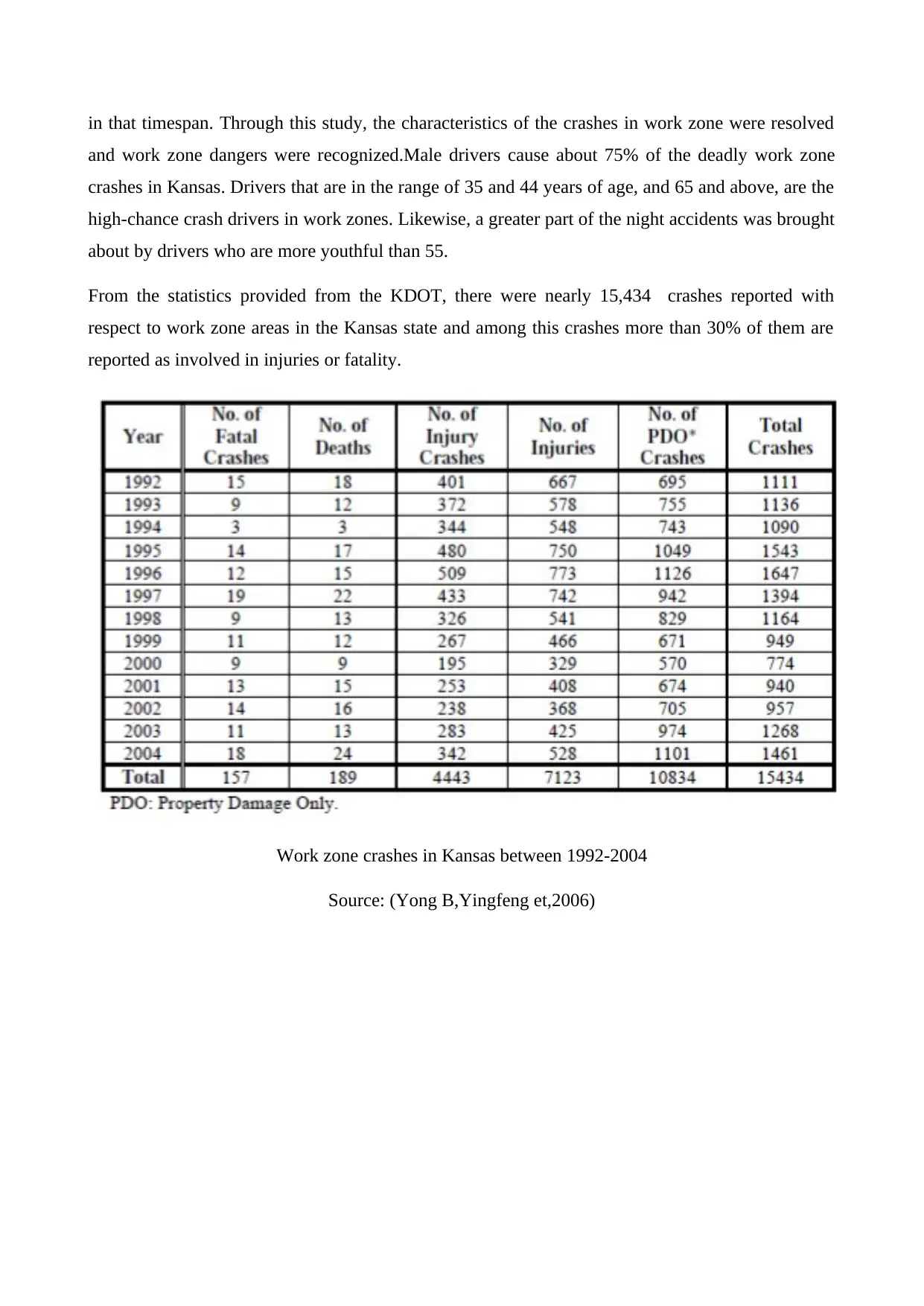
in that timespan. Through this study, the characteristics of the crashes in work zone were resolved
and work zone dangers were recognized.Male drivers cause about 75% of the deadly work zone
crashes in Kansas. Drivers that are in the range of 35 and 44 years of age, and 65 and above, are the
high-chance crash drivers in work zones. Likewise, a greater part of the night accidents was brought
about by drivers who are more youthful than 55.
From the statistics provided from the KDOT, there were nearly 15,434 crashes reported with
respect to work zone areas in the Kansas state and among this crashes more than 30% of them are
reported as involved in injuries or fatality.
Work zone crashes in Kansas between 1992-2004
Source: (Yong B,Yingfeng et,2006)
and work zone dangers were recognized.Male drivers cause about 75% of the deadly work zone
crashes in Kansas. Drivers that are in the range of 35 and 44 years of age, and 65 and above, are the
high-chance crash drivers in work zones. Likewise, a greater part of the night accidents was brought
about by drivers who are more youthful than 55.
From the statistics provided from the KDOT, there were nearly 15,434 crashes reported with
respect to work zone areas in the Kansas state and among this crashes more than 30% of them are
reported as involved in injuries or fatality.
Work zone crashes in Kansas between 1992-2004
Source: (Yong B,Yingfeng et,2006)
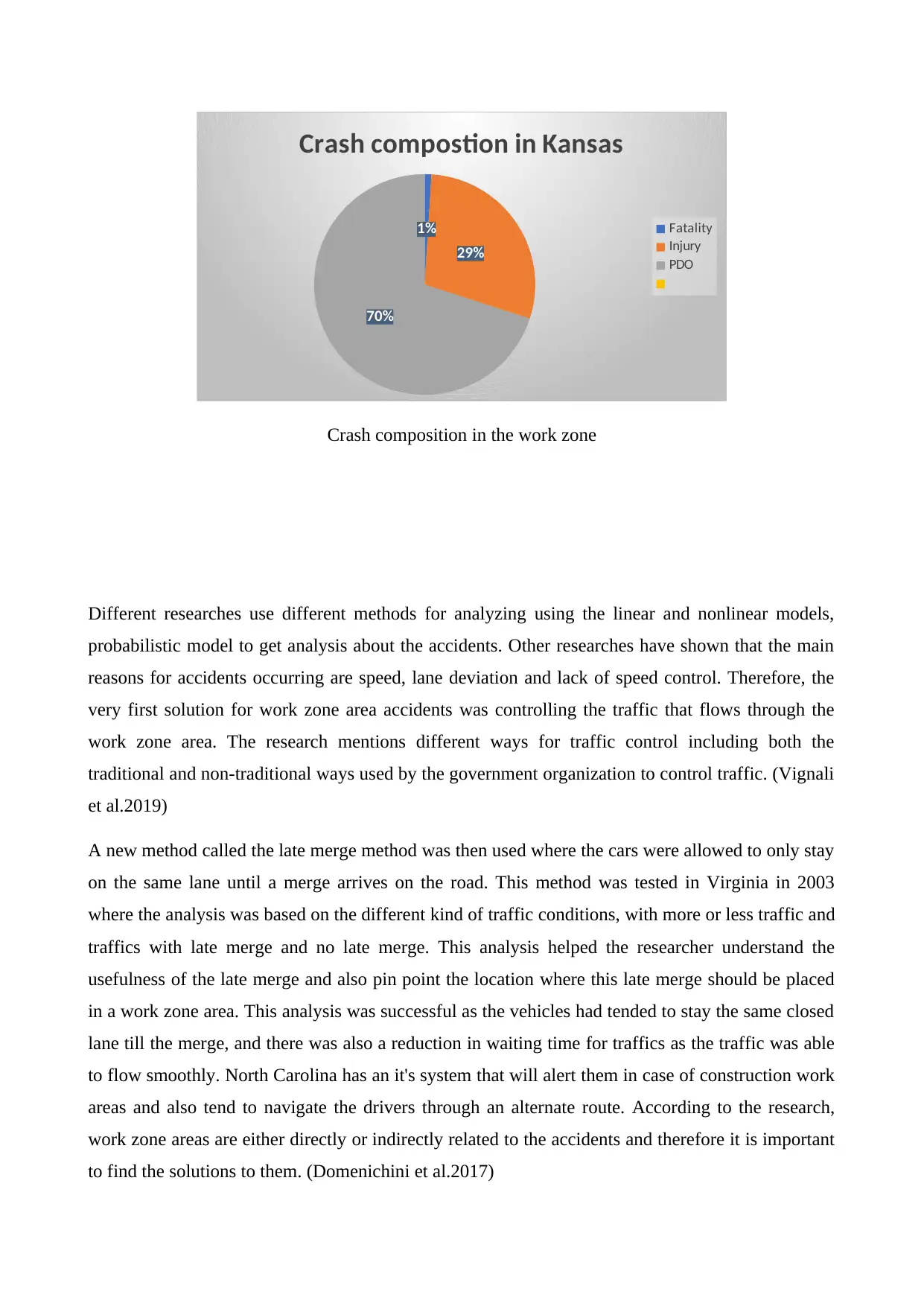
1%
29%
70%
Crash compostion in Kansas
Fatality
Injury
PDO
Crash composition in the work zone
Different researches use different methods for analyzing using the linear and nonlinear models,
probabilistic model to get analysis about the accidents. Other researches have shown that the main
reasons for accidents occurring are speed, lane deviation and lack of speed control. Therefore, the
very first solution for work zone area accidents was controlling the traffic that flows through the
work zone area. The research mentions different ways for traffic control including both the
traditional and non-traditional ways used by the government organization to control traffic. (Vignali
et al.2019)
A new method called the late merge method was then used where the cars were allowed to only stay
on the same lane until a merge arrives on the road. This method was tested in Virginia in 2003
where the analysis was based on the different kind of traffic conditions, with more or less traffic and
traffics with late merge and no late merge. This analysis helped the researcher understand the
usefulness of the late merge and also pin point the location where this late merge should be placed
in a work zone area. This analysis was successful as the vehicles had tended to stay the same closed
lane till the merge, and there was also a reduction in waiting time for traffics as the traffic was able
to flow smoothly. North Carolina has an it's system that will alert them in case of construction work
areas and also tend to navigate the drivers through an alternate route. According to the research,
work zone areas are either directly or indirectly related to the accidents and therefore it is important
to find the solutions to them. (Domenichini et al.2017)
29%
70%
Crash compostion in Kansas
Fatality
Injury
PDO
Crash composition in the work zone
Different researches use different methods for analyzing using the linear and nonlinear models,
probabilistic model to get analysis about the accidents. Other researches have shown that the main
reasons for accidents occurring are speed, lane deviation and lack of speed control. Therefore, the
very first solution for work zone area accidents was controlling the traffic that flows through the
work zone area. The research mentions different ways for traffic control including both the
traditional and non-traditional ways used by the government organization to control traffic. (Vignali
et al.2019)
A new method called the late merge method was then used where the cars were allowed to only stay
on the same lane until a merge arrives on the road. This method was tested in Virginia in 2003
where the analysis was based on the different kind of traffic conditions, with more or less traffic and
traffics with late merge and no late merge. This analysis helped the researcher understand the
usefulness of the late merge and also pin point the location where this late merge should be placed
in a work zone area. This analysis was successful as the vehicles had tended to stay the same closed
lane till the merge, and there was also a reduction in waiting time for traffics as the traffic was able
to flow smoothly. North Carolina has an it's system that will alert them in case of construction work
areas and also tend to navigate the drivers through an alternate route. According to the research,
work zone areas are either directly or indirectly related to the accidents and therefore it is important
to find the solutions to them. (Domenichini et al.2017)

According to the research there the conclusion explains that,
There should be reduction in the mean speed limit as most of the causes of these accidents have
been identified to be the high-speed limit. Reducing the speed limit will make it easier for traffic
control officers to manage the traffic and will also help in reducing the accident rates at these work
zone areas. Also reducing the speed limit gives both the driver and the worker, in case of collisions
more time to understand the situation and react accordingly. This will be beneficial for reducing the
accidents. (Steinbakk et al.2019)
Another main reason for the conduction of this research was to understand the VSL system for
stimulation on highways. This research was able to prove that the application of VSL with proper
speed limit assignment, the accidents and crashes in work zone can be reduced. Although, safety
should also be given equal weight age in order to ensure work zone area safety. Different traffic
control mechanisms too, were discussed in the assignments like the traffic sensors,
communications, devices used for navigating, proprietary algorithm and others. (Steinbakk et
al.2017)
.
There should be reduction in the mean speed limit as most of the causes of these accidents have
been identified to be the high-speed limit. Reducing the speed limit will make it easier for traffic
control officers to manage the traffic and will also help in reducing the accident rates at these work
zone areas. Also reducing the speed limit gives both the driver and the worker, in case of collisions
more time to understand the situation and react accordingly. This will be beneficial for reducing the
accidents. (Steinbakk et al.2019)
Another main reason for the conduction of this research was to understand the VSL system for
stimulation on highways. This research was able to prove that the application of VSL with proper
speed limit assignment, the accidents and crashes in work zone can be reduced. Although, safety
should also be given equal weight age in order to ensure work zone area safety. Different traffic
control mechanisms too, were discussed in the assignments like the traffic sensors,
communications, devices used for navigating, proprietary algorithm and others. (Steinbakk et
al.2017)
.
Secure Best Marks with AI Grader
Need help grading? Try our AI Grader for instant feedback on your assignments.
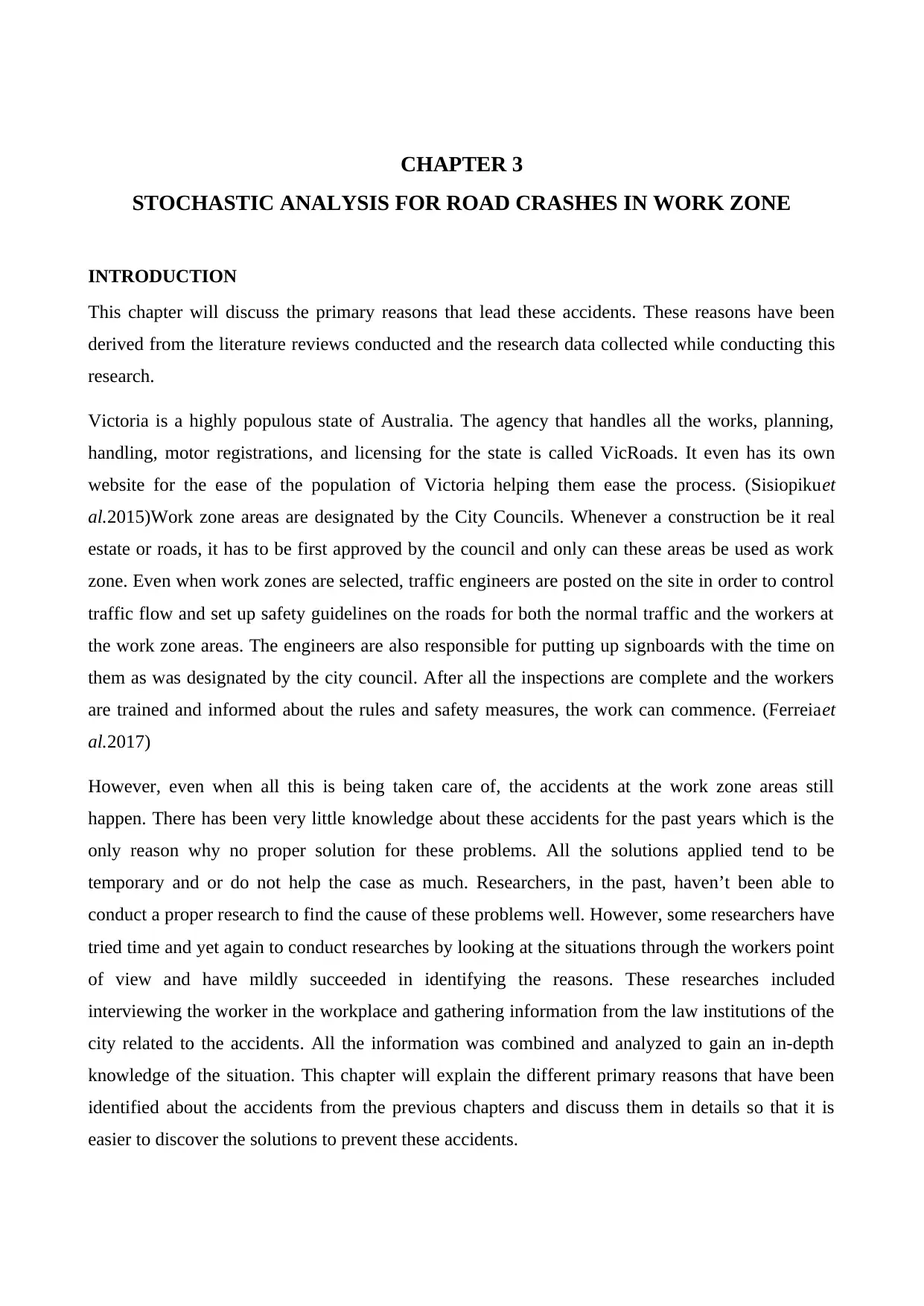
CHAPTER 3
STOCHASTIC ANALYSIS FOR ROAD CRASHES IN WORK ZONE
INTRODUCTION
This chapter will discuss the primary reasons that lead these accidents. These reasons have been
derived from the literature reviews conducted and the research data collected while conducting this
research.
Victoria is a highly populous state of Australia. The agency that handles all the works, planning,
handling, motor registrations, and licensing for the state is called VicRoads. It even has its own
website for the ease of the population of Victoria helping them ease the process. (Sisiopikuet
al.2015)Work zone areas are designated by the City Councils. Whenever a construction be it real
estate or roads, it has to be first approved by the council and only can these areas be used as work
zone. Even when work zones are selected, traffic engineers are posted on the site in order to control
traffic flow and set up safety guidelines on the roads for both the normal traffic and the workers at
the work zone areas. The engineers are also responsible for putting up signboards with the time on
them as was designated by the city council. After all the inspections are complete and the workers
are trained and informed about the rules and safety measures, the work can commence. (Ferreiaet
al.2017)
However, even when all this is being taken care of, the accidents at the work zone areas still
happen. There has been very little knowledge about these accidents for the past years which is the
only reason why no proper solution for these problems. All the solutions applied tend to be
temporary and or do not help the case as much. Researchers, in the past, haven’t been able to
conduct a proper research to find the cause of these problems well. However, some researchers have
tried time and yet again to conduct researches by looking at the situations through the workers point
of view and have mildly succeeded in identifying the reasons. These researches included
interviewing the worker in the workplace and gathering information from the law institutions of the
city related to the accidents. All the information was combined and analyzed to gain an in-depth
knowledge of the situation. This chapter will explain the different primary reasons that have been
identified about the accidents from the previous chapters and discuss them in details so that it is
easier to discover the solutions to prevent these accidents.
STOCHASTIC ANALYSIS FOR ROAD CRASHES IN WORK ZONE
INTRODUCTION
This chapter will discuss the primary reasons that lead these accidents. These reasons have been
derived from the literature reviews conducted and the research data collected while conducting this
research.
Victoria is a highly populous state of Australia. The agency that handles all the works, planning,
handling, motor registrations, and licensing for the state is called VicRoads. It even has its own
website for the ease of the population of Victoria helping them ease the process. (Sisiopikuet
al.2015)Work zone areas are designated by the City Councils. Whenever a construction be it real
estate or roads, it has to be first approved by the council and only can these areas be used as work
zone. Even when work zones are selected, traffic engineers are posted on the site in order to control
traffic flow and set up safety guidelines on the roads for both the normal traffic and the workers at
the work zone areas. The engineers are also responsible for putting up signboards with the time on
them as was designated by the city council. After all the inspections are complete and the workers
are trained and informed about the rules and safety measures, the work can commence. (Ferreiaet
al.2017)
However, even when all this is being taken care of, the accidents at the work zone areas still
happen. There has been very little knowledge about these accidents for the past years which is the
only reason why no proper solution for these problems. All the solutions applied tend to be
temporary and or do not help the case as much. Researchers, in the past, haven’t been able to
conduct a proper research to find the cause of these problems well. However, some researchers have
tried time and yet again to conduct researches by looking at the situations through the workers point
of view and have mildly succeeded in identifying the reasons. These researches included
interviewing the worker in the workplace and gathering information from the law institutions of the
city related to the accidents. All the information was combined and analyzed to gain an in-depth
knowledge of the situation. This chapter will explain the different primary reasons that have been
identified about the accidents from the previous chapters and discuss them in details so that it is
easier to discover the solutions to prevent these accidents.
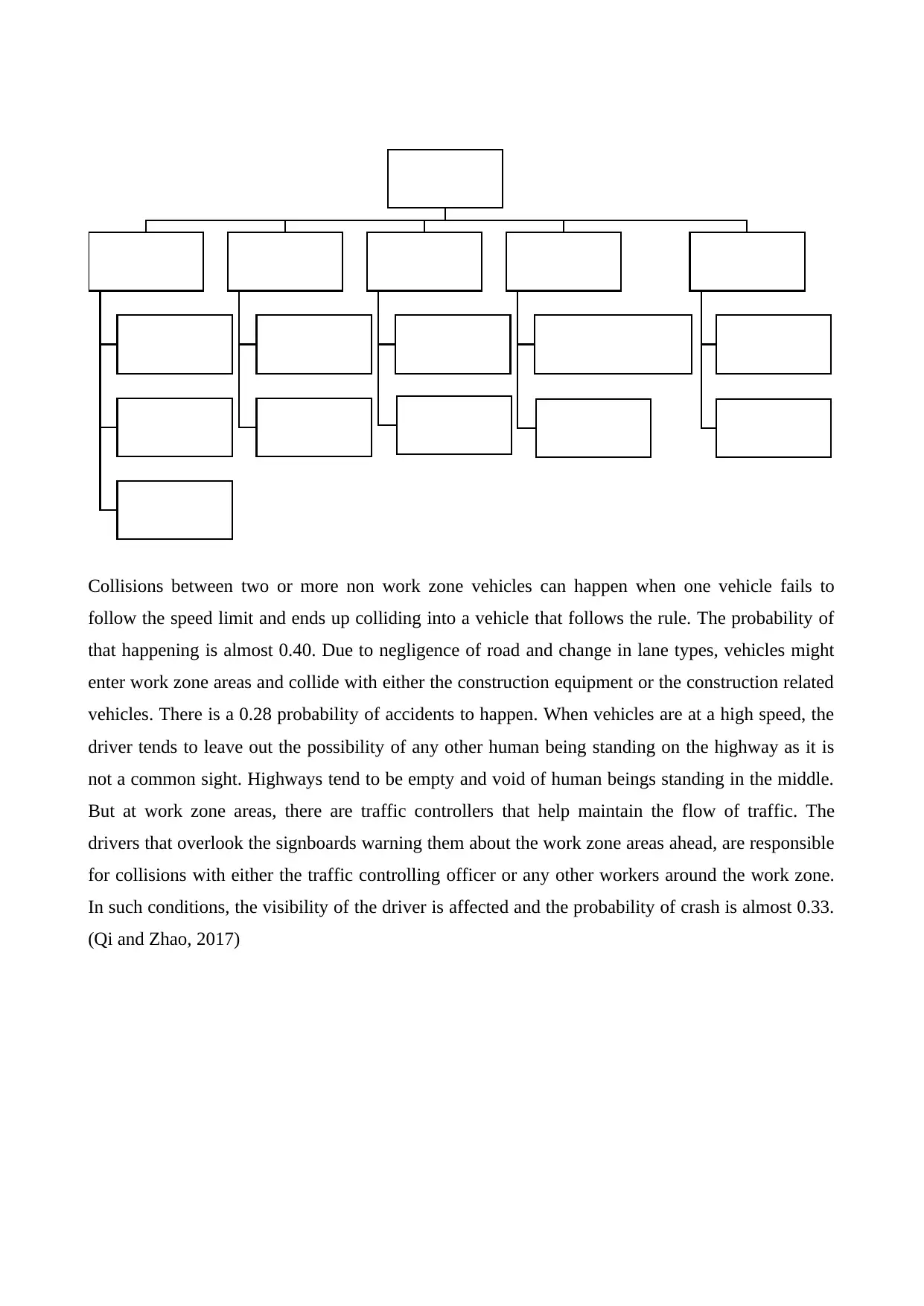
Collisions between two or more non work zone vehicles can happen when one vehicle fails to
follow the speed limit and ends up colliding into a vehicle that follows the rule. The probability of
that happening is almost 0.40. Due to negligence of road and change in lane types, vehicles might
enter work zone areas and collide with either the construction equipment or the construction related
vehicles. There is a 0.28 probability of accidents to happen. When vehicles are at a high speed, the
driver tends to leave out the possibility of any other human being standing on the highway as it is
not a common sight. Highways tend to be empty and void of human beings standing in the middle.
But at work zone areas, there are traffic controllers that help maintain the flow of traffic. The
drivers that overlook the signboards warning them about the work zone areas ahead, are responsible
for collisions with either the traffic controlling officer or any other workers around the work zone.
In such conditions, the visibility of the driver is affected and the probability of crash is almost 0.33.
(Qi and Zhao, 2017)
CRASH
DRIVER
CHARACTERISTICS
STRESS/
TIREDNESS
CELL PHONE
USAGE
ALCOHOL/ DRUG
CONSUMPTIONS
VISIBILITY
BAD
WEATHER
IMPROPER SIGNS
WORK ZONE
CONFIGURATION
INADEQUATE
WORKAREA
CONGESTED
LANES
SPEED
LOSS OF CONTROL
OF VECHILE
IMPROPER
DECISIONS
WORKING
CONDITIONS
WORKING DURING
NIGHTS
TRAFFIC
ISSUES
follow the speed limit and ends up colliding into a vehicle that follows the rule. The probability of
that happening is almost 0.40. Due to negligence of road and change in lane types, vehicles might
enter work zone areas and collide with either the construction equipment or the construction related
vehicles. There is a 0.28 probability of accidents to happen. When vehicles are at a high speed, the
driver tends to leave out the possibility of any other human being standing on the highway as it is
not a common sight. Highways tend to be empty and void of human beings standing in the middle.
But at work zone areas, there are traffic controllers that help maintain the flow of traffic. The
drivers that overlook the signboards warning them about the work zone areas ahead, are responsible
for collisions with either the traffic controlling officer or any other workers around the work zone.
In such conditions, the visibility of the driver is affected and the probability of crash is almost 0.33.
(Qi and Zhao, 2017)
CRASH
DRIVER
CHARACTERISTICS
STRESS/
TIREDNESS
CELL PHONE
USAGE
ALCOHOL/ DRUG
CONSUMPTIONS
VISIBILITY
BAD
WEATHER
IMPROPER SIGNS
WORK ZONE
CONFIGURATION
INADEQUATE
WORKAREA
CONGESTED
LANES
SPEED
LOSS OF CONTROL
OF VECHILE
IMPROPER
DECISIONS
WORKING
CONDITIONS
WORKING DURING
NIGHTS
TRAFFIC
ISSUES
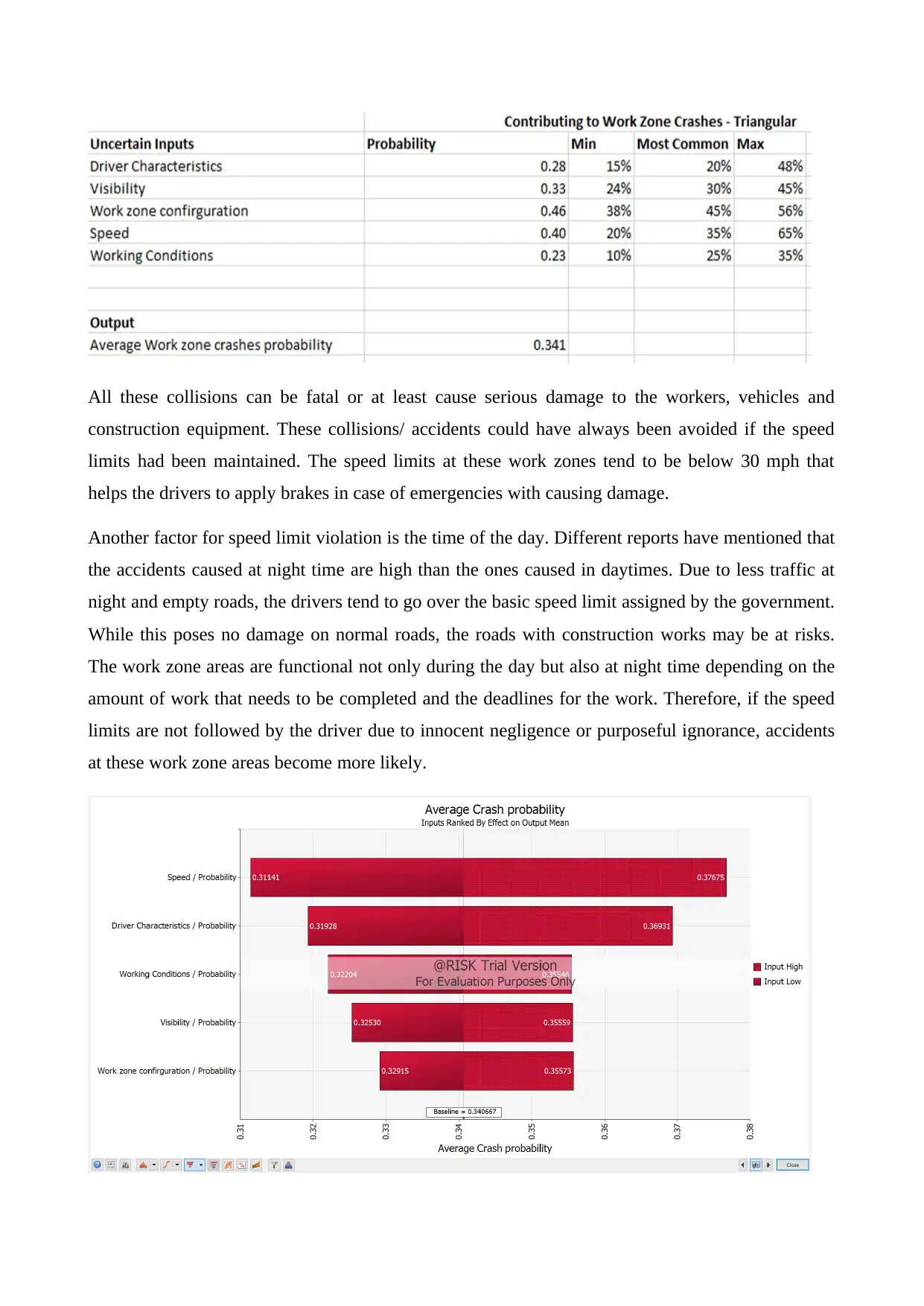
All these collisions can be fatal or at least cause serious damage to the workers, vehicles and
construction equipment. These collisions/ accidents could have always been avoided if the speed
limits had been maintained. The speed limits at these work zones tend to be below 30 mph that
helps the drivers to apply brakes in case of emergencies with causing damage.
Another factor for speed limit violation is the time of the day. Different reports have mentioned that
the accidents caused at night time are high than the ones caused in daytimes. Due to less traffic at
night and empty roads, the drivers tend to go over the basic speed limit assigned by the government.
While this poses no damage on normal roads, the roads with construction works may be at risks.
The work zone areas are functional not only during the day but also at night time depending on the
amount of work that needs to be completed and the deadlines for the work. Therefore, if the speed
limits are not followed by the driver due to innocent negligence or purposeful ignorance, accidents
at these work zone areas become more likely.
construction equipment. These collisions/ accidents could have always been avoided if the speed
limits had been maintained. The speed limits at these work zones tend to be below 30 mph that
helps the drivers to apply brakes in case of emergencies with causing damage.
Another factor for speed limit violation is the time of the day. Different reports have mentioned that
the accidents caused at night time are high than the ones caused in daytimes. Due to less traffic at
night and empty roads, the drivers tend to go over the basic speed limit assigned by the government.
While this poses no damage on normal roads, the roads with construction works may be at risks.
The work zone areas are functional not only during the day but also at night time depending on the
amount of work that needs to be completed and the deadlines for the work. Therefore, if the speed
limits are not followed by the driver due to innocent negligence or purposeful ignorance, accidents
at these work zone areas become more likely.
Paraphrase This Document
Need a fresh take? Get an instant paraphrase of this document with our AI Paraphraser
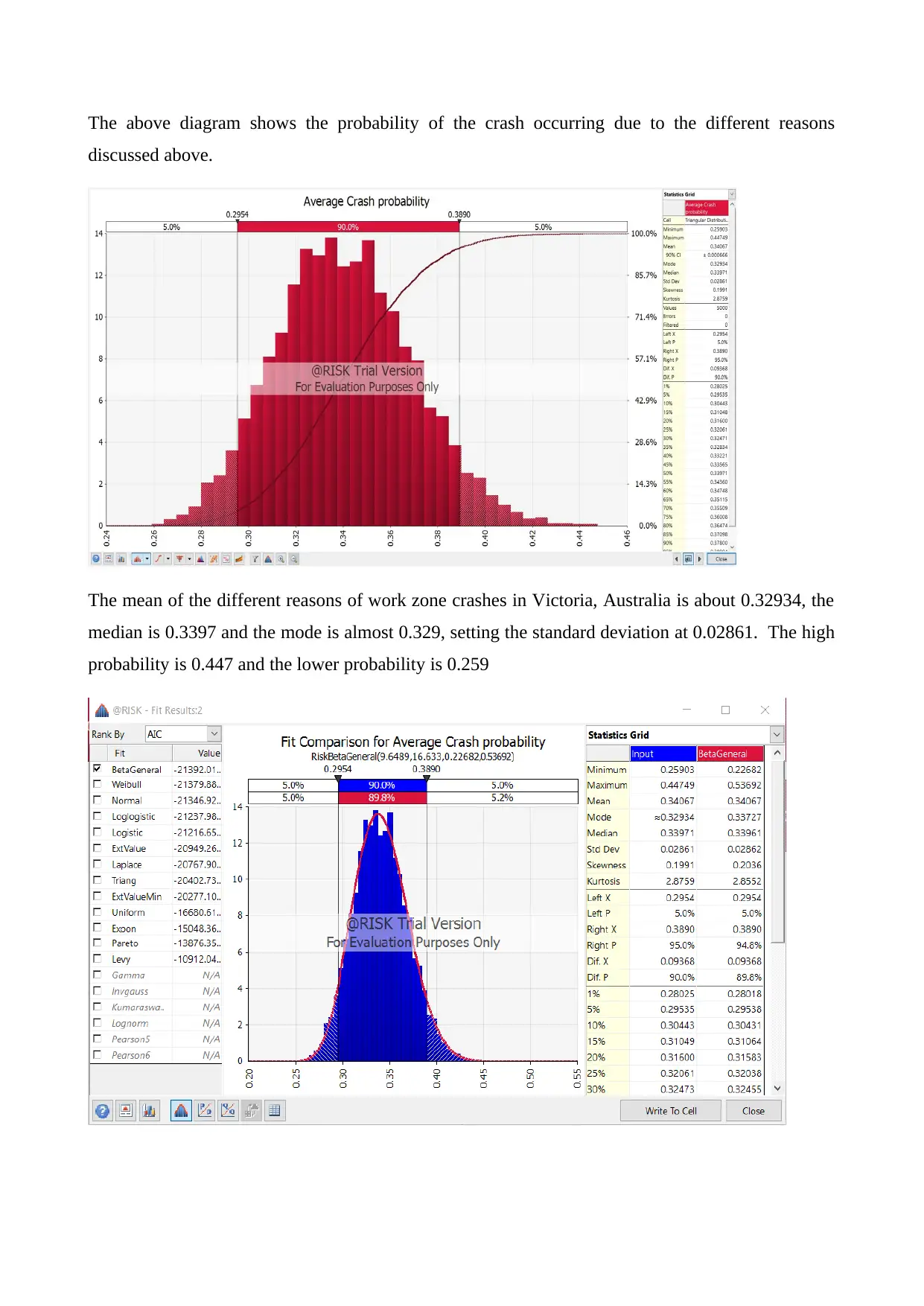
The above diagram shows the probability of the crash occurring due to the different reasons
discussed above.
The mean of the different reasons of work zone crashes in Victoria, Australia is about 0.32934, the
median is 0.3397 and the mode is almost 0.329, setting the standard deviation at 0.02861. The high
probability is 0.447 and the lower probability is 0.259
discussed above.
The mean of the different reasons of work zone crashes in Victoria, Australia is about 0.32934, the
median is 0.3397 and the mode is almost 0.329, setting the standard deviation at 0.02861. The high
probability is 0.447 and the lower probability is 0.259

Through this chapter the primary reasons for work zone related accidents are caused due to speed
limit violations, visibility, driver carelessness, and negligence of safety protocols. Both the civilians
and the workers at the work zone areas are responsible for these accidents.
limit violations, visibility, driver carelessness, and negligence of safety protocols. Both the civilians
and the workers at the work zone areas are responsible for these accidents.
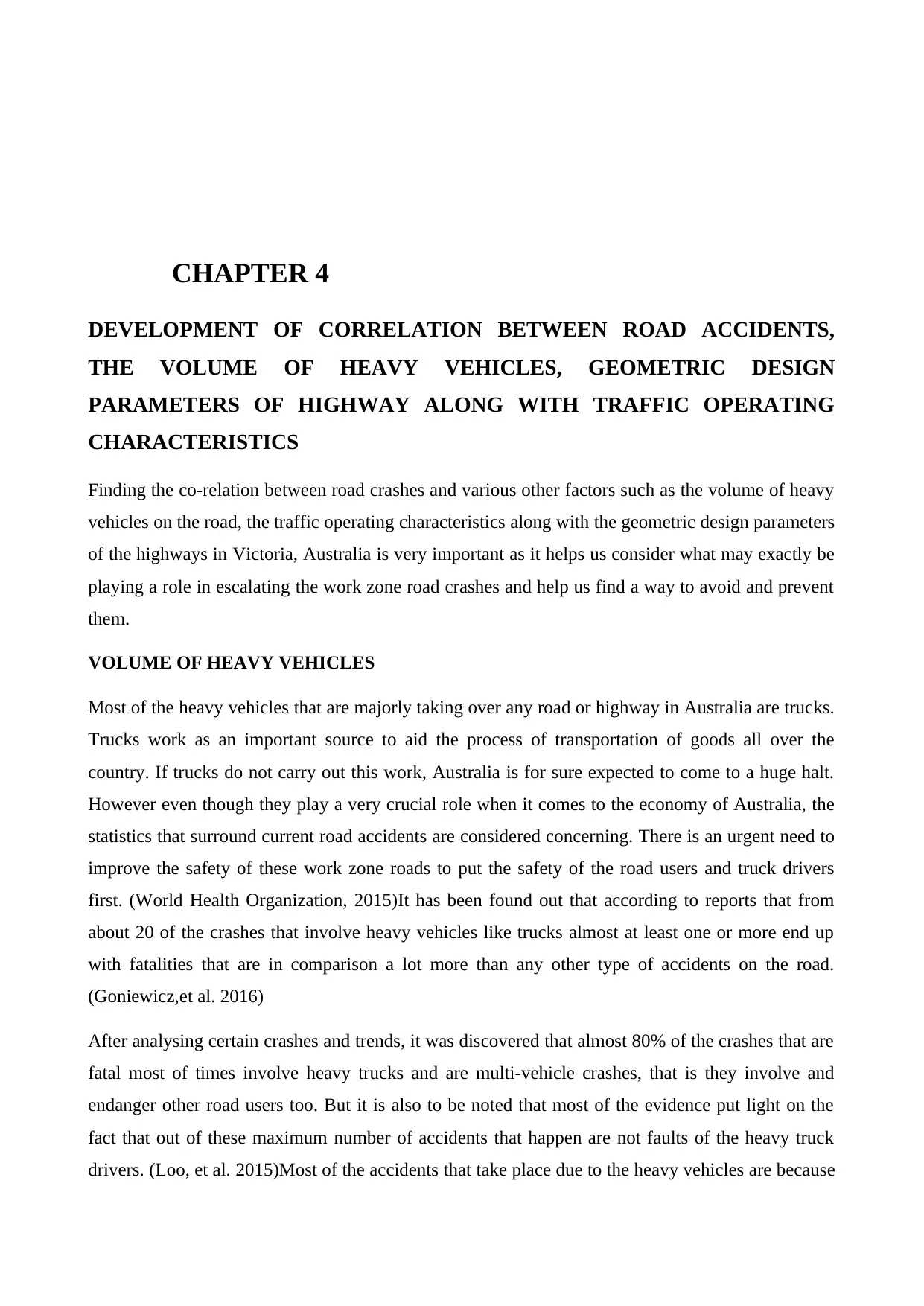
CHAPTER 4
DEVELOPMENT OF CORRELATION BETWEEN ROAD ACCIDENTS,
THE VOLUME OF HEAVY VEHICLES, GEOMETRIC DESIGN
PARAMETERS OF HIGHWAY ALONG WITH TRAFFIC OPERATING
CHARACTERISTICS
Finding the co-relation between road crashes and various other factors such as the volume of heavy
vehicles on the road, the traffic operating characteristics along with the geometric design parameters
of the highways in Victoria, Australia is very important as it helps us consider what may exactly be
playing a role in escalating the work zone road crashes and help us find a way to avoid and prevent
them.
VOLUME OF HEAVY VEHICLES
Most of the heavy vehicles that are majorly taking over any road or highway in Australia are trucks.
Trucks work as an important source to aid the process of transportation of goods all over the
country. If trucks do not carry out this work, Australia is for sure expected to come to a huge halt.
However even though they play a very crucial role when it comes to the economy of Australia, the
statistics that surround current road accidents are considered concerning. There is an urgent need to
improve the safety of these work zone roads to put the safety of the road users and truck drivers
first. (World Health Organization, 2015)It has been found out that according to reports that from
about 20 of the crashes that involve heavy vehicles like trucks almost at least one or more end up
with fatalities that are in comparison a lot more than any other type of accidents on the road.
(Goniewicz,et al. 2016)
After analysing certain crashes and trends, it was discovered that almost 80% of the crashes that are
fatal most of times involve heavy trucks and are multi-vehicle crashes, that is they involve and
endanger other road users too. But it is also to be noted that most of the evidence put light on the
fact that out of these maximum number of accidents that happen are not faults of the heavy truck
drivers. (Loo, et al. 2015)Most of the accidents that take place due to the heavy vehicles are because
DEVELOPMENT OF CORRELATION BETWEEN ROAD ACCIDENTS,
THE VOLUME OF HEAVY VEHICLES, GEOMETRIC DESIGN
PARAMETERS OF HIGHWAY ALONG WITH TRAFFIC OPERATING
CHARACTERISTICS
Finding the co-relation between road crashes and various other factors such as the volume of heavy
vehicles on the road, the traffic operating characteristics along with the geometric design parameters
of the highways in Victoria, Australia is very important as it helps us consider what may exactly be
playing a role in escalating the work zone road crashes and help us find a way to avoid and prevent
them.
VOLUME OF HEAVY VEHICLES
Most of the heavy vehicles that are majorly taking over any road or highway in Australia are trucks.
Trucks work as an important source to aid the process of transportation of goods all over the
country. If trucks do not carry out this work, Australia is for sure expected to come to a huge halt.
However even though they play a very crucial role when it comes to the economy of Australia, the
statistics that surround current road accidents are considered concerning. There is an urgent need to
improve the safety of these work zone roads to put the safety of the road users and truck drivers
first. (World Health Organization, 2015)It has been found out that according to reports that from
about 20 of the crashes that involve heavy vehicles like trucks almost at least one or more end up
with fatalities that are in comparison a lot more than any other type of accidents on the road.
(Goniewicz,et al. 2016)
After analysing certain crashes and trends, it was discovered that almost 80% of the crashes that are
fatal most of times involve heavy trucks and are multi-vehicle crashes, that is they involve and
endanger other road users too. But it is also to be noted that most of the evidence put light on the
fact that out of these maximum number of accidents that happen are not faults of the heavy truck
drivers. (Loo, et al. 2015)Most of the accidents that take place due to the heavy vehicles are because
Secure Best Marks with AI Grader
Need help grading? Try our AI Grader for instant feedback on your assignments.

of the untended road conditions that exist. Many of them are also a result of an overly worked
driver, and the consequences of fatigue lead to fatality. Not providing good working conditions and
care for drivers may also be a huge concern which might be the underlying factor behind the
fatigue. (Imprialou, et al. 2017)
While the cases of accidents that happen due to heavy vehicles in work zone areas are not as high
but is still concerning, it is a known fact that these heavy vehicles are important in their way to the
construction sites, however even the volume of these heavy vehicles that are led onto these work
zones is a factor of concern for road safety as well as delay in the schedule due to the increase of
traffic. As the heavy vehicles take a lot of space, they also cause frustration among workers and
drivers which in turn sometimes also escalate accidents. (Hughes, et al. 2015)
TRAFFIC OPERATING CHARACTERISTICS
Managing and taking care of traffic when it comes to areas that are work zones and specifically deal
with the construction is necessary to reduce the delays and maintain a safe environment for the
workers as well as the drivers. To ensure proper management of traffic in work zone areas one of
the things that become of most importance is the rule to reduce the normal speed limit the highways
usually work on. As work zones are usually frequented with heavy vehicles that carry heavy goods
it becomes an important key element to pay attention towards, as there is always a chance of people
working near the roads ahead and changing of traffic lanes. As speeding remains one of the major
cause behind road accidents, the speed limit can help with controlling it to an extent. (Wegman, et
al. 2017)
Along with the speed limit, warning signs are very important in work zone areas; there is a very
important need for all drivers to be educated about these signs and forced now and then to be
careful and drive safely because only if the signs are observed will the safety be guaranteed. Many
times work zones keep changing their area of work and hence warning signs to play a huge role.
(Scott-Parker, et al. 2015)The travel times, delays, length of queues, the number of accidents,
clearance times, complaints, costs, and others are most of the time directly related to the traffic
operating and management techniques adopted in the particular work zone areas. In order to
complete the road work in the right manner with the least amount of delays and accidents it
becomes important to make sure all the strategies and traffic management policies are taken into
account after thorough check on the project constraints, the type of work carried out in the work
zone and how the work will impact the work zones as well as the main roads. (Sagberg, et al. 2015)
driver, and the consequences of fatigue lead to fatality. Not providing good working conditions and
care for drivers may also be a huge concern which might be the underlying factor behind the
fatigue. (Imprialou, et al. 2017)
While the cases of accidents that happen due to heavy vehicles in work zone areas are not as high
but is still concerning, it is a known fact that these heavy vehicles are important in their way to the
construction sites, however even the volume of these heavy vehicles that are led onto these work
zones is a factor of concern for road safety as well as delay in the schedule due to the increase of
traffic. As the heavy vehicles take a lot of space, they also cause frustration among workers and
drivers which in turn sometimes also escalate accidents. (Hughes, et al. 2015)
TRAFFIC OPERATING CHARACTERISTICS
Managing and taking care of traffic when it comes to areas that are work zones and specifically deal
with the construction is necessary to reduce the delays and maintain a safe environment for the
workers as well as the drivers. To ensure proper management of traffic in work zone areas one of
the things that become of most importance is the rule to reduce the normal speed limit the highways
usually work on. As work zones are usually frequented with heavy vehicles that carry heavy goods
it becomes an important key element to pay attention towards, as there is always a chance of people
working near the roads ahead and changing of traffic lanes. As speeding remains one of the major
cause behind road accidents, the speed limit can help with controlling it to an extent. (Wegman, et
al. 2017)
Along with the speed limit, warning signs are very important in work zone areas; there is a very
important need for all drivers to be educated about these signs and forced now and then to be
careful and drive safely because only if the signs are observed will the safety be guaranteed. Many
times work zones keep changing their area of work and hence warning signs to play a huge role.
(Scott-Parker, et al. 2015)The travel times, delays, length of queues, the number of accidents,
clearance times, complaints, costs, and others are most of the time directly related to the traffic
operating and management techniques adopted in the particular work zone areas. In order to
complete the road work in the right manner with the least amount of delays and accidents it
becomes important to make sure all the strategies and traffic management policies are taken into
account after thorough check on the project constraints, the type of work carried out in the work
zone and how the work will impact the work zones as well as the main roads. (Sagberg, et al. 2015)
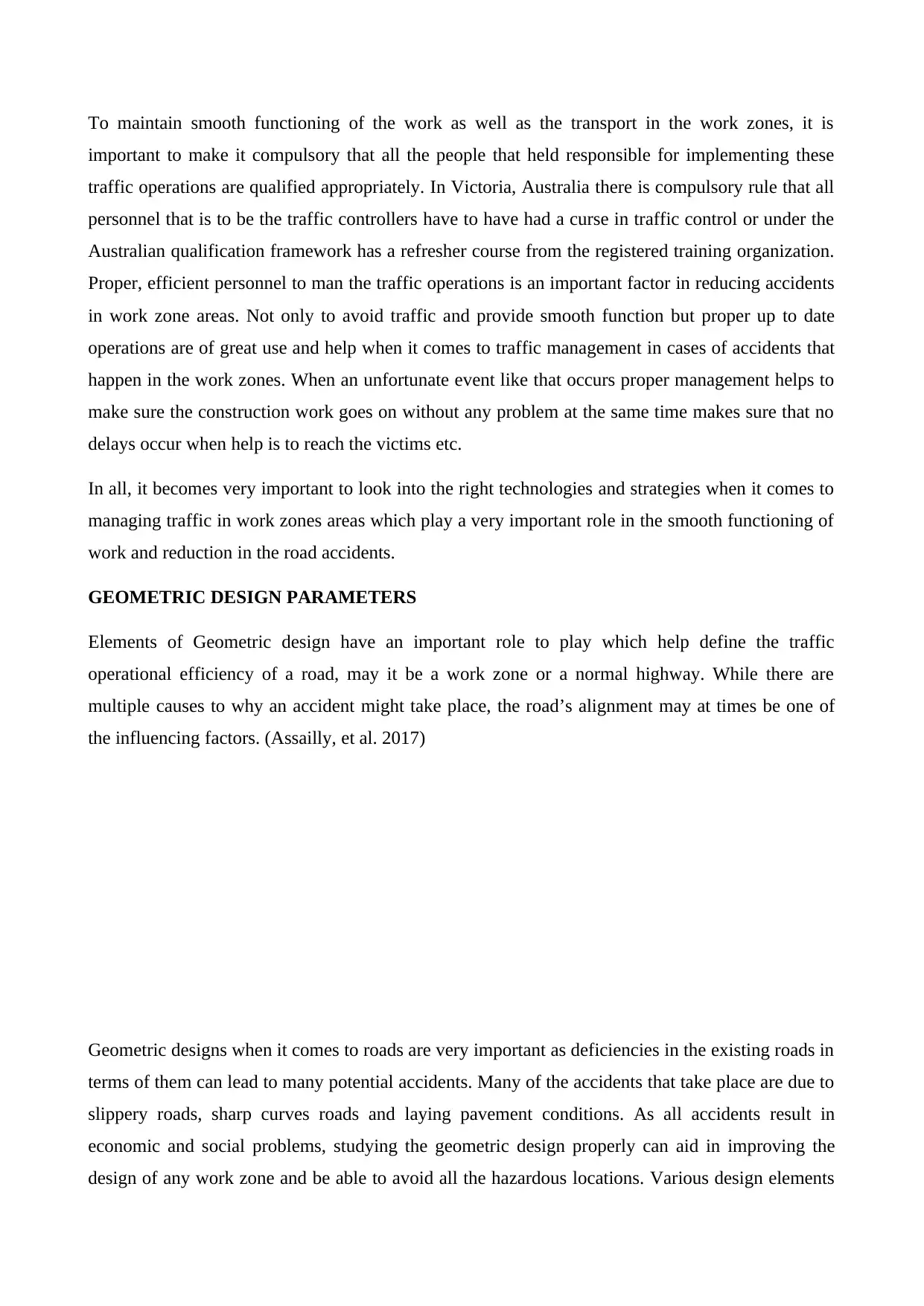
To maintain smooth functioning of the work as well as the transport in the work zones, it is
important to make it compulsory that all the people that held responsible for implementing these
traffic operations are qualified appropriately. In Victoria, Australia there is compulsory rule that all
personnel that is to be the traffic controllers have to have had a curse in traffic control or under the
Australian qualification framework has a refresher course from the registered training organization.
Proper, efficient personnel to man the traffic operations is an important factor in reducing accidents
in work zone areas. Not only to avoid traffic and provide smooth function but proper up to date
operations are of great use and help when it comes to traffic management in cases of accidents that
happen in the work zones. When an unfortunate event like that occurs proper management helps to
make sure the construction work goes on without any problem at the same time makes sure that no
delays occur when help is to reach the victims etc.
In all, it becomes very important to look into the right technologies and strategies when it comes to
managing traffic in work zones areas which play a very important role in the smooth functioning of
work and reduction in the road accidents.
GEOMETRIC DESIGN PARAMETERS
Elements of Geometric design have an important role to play which help define the traffic
operational efficiency of a road, may it be a work zone or a normal highway. While there are
multiple causes to why an accident might take place, the road’s alignment may at times be one of
the influencing factors. (Assailly, et al. 2017)
Geometric designs when it comes to roads are very important as deficiencies in the existing roads in
terms of them can lead to many potential accidents. Many of the accidents that take place are due to
slippery roads, sharp curves roads and laying pavement conditions. As all accidents result in
economic and social problems, studying the geometric design properly can aid in improving the
design of any work zone and be able to avoid all the hazardous locations. Various design elements
important to make it compulsory that all the people that held responsible for implementing these
traffic operations are qualified appropriately. In Victoria, Australia there is compulsory rule that all
personnel that is to be the traffic controllers have to have had a curse in traffic control or under the
Australian qualification framework has a refresher course from the registered training organization.
Proper, efficient personnel to man the traffic operations is an important factor in reducing accidents
in work zone areas. Not only to avoid traffic and provide smooth function but proper up to date
operations are of great use and help when it comes to traffic management in cases of accidents that
happen in the work zones. When an unfortunate event like that occurs proper management helps to
make sure the construction work goes on without any problem at the same time makes sure that no
delays occur when help is to reach the victims etc.
In all, it becomes very important to look into the right technologies and strategies when it comes to
managing traffic in work zones areas which play a very important role in the smooth functioning of
work and reduction in the road accidents.
GEOMETRIC DESIGN PARAMETERS
Elements of Geometric design have an important role to play which help define the traffic
operational efficiency of a road, may it be a work zone or a normal highway. While there are
multiple causes to why an accident might take place, the road’s alignment may at times be one of
the influencing factors. (Assailly, et al. 2017)
Geometric designs when it comes to roads are very important as deficiencies in the existing roads in
terms of them can lead to many potential accidents. Many of the accidents that take place are due to
slippery roads, sharp curves roads and laying pavement conditions. As all accidents result in
economic and social problems, studying the geometric design properly can aid in improving the
design of any work zone and be able to avoid all the hazardous locations. Various design elements
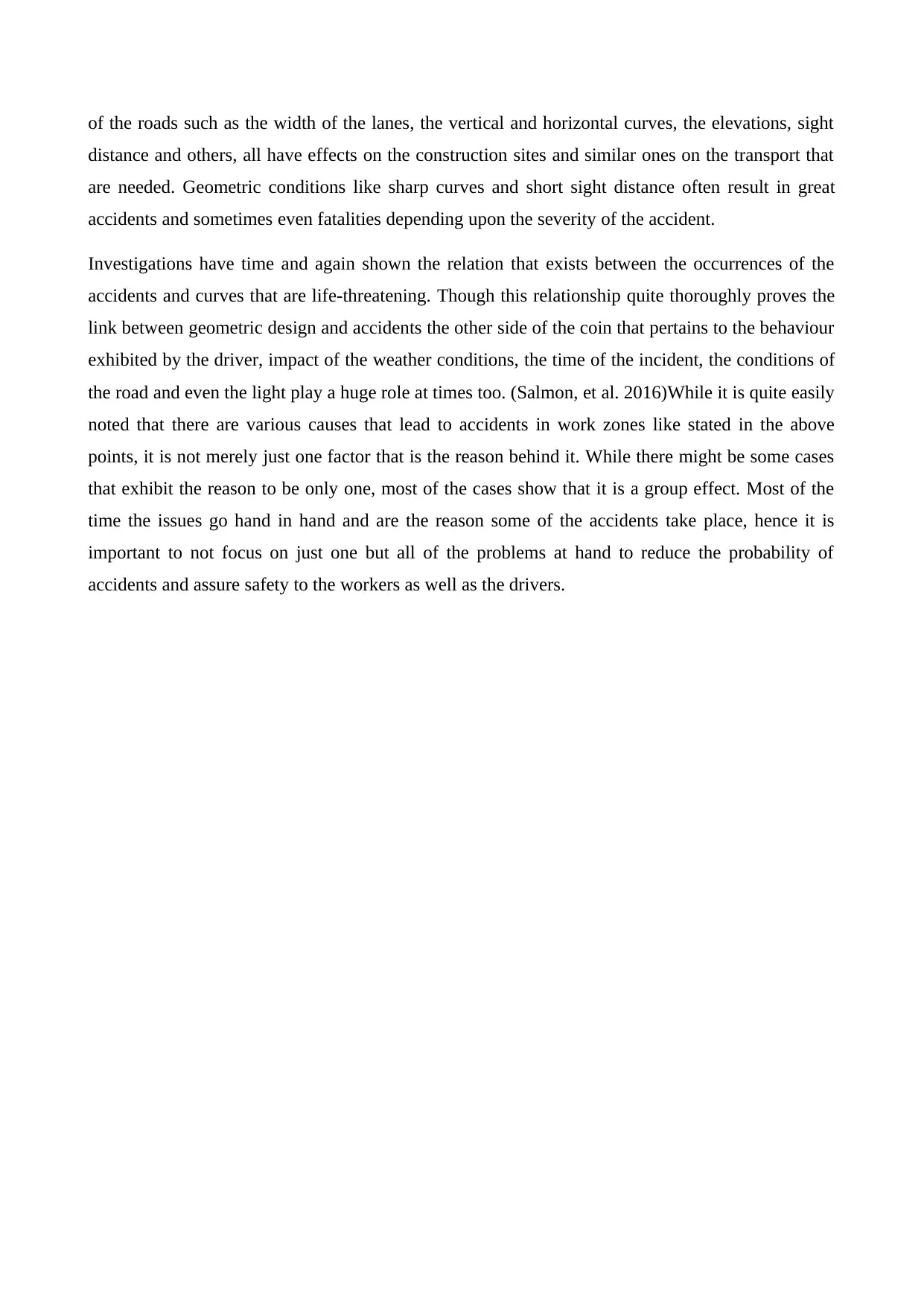
of the roads such as the width of the lanes, the vertical and horizontal curves, the elevations, sight
distance and others, all have effects on the construction sites and similar ones on the transport that
are needed. Geometric conditions like sharp curves and short sight distance often result in great
accidents and sometimes even fatalities depending upon the severity of the accident.
Investigations have time and again shown the relation that exists between the occurrences of the
accidents and curves that are life-threatening. Though this relationship quite thoroughly proves the
link between geometric design and accidents the other side of the coin that pertains to the behaviour
exhibited by the driver, impact of the weather conditions, the time of the incident, the conditions of
the road and even the light play a huge role at times too. (Salmon, et al. 2016)While it is quite easily
noted that there are various causes that lead to accidents in work zones like stated in the above
points, it is not merely just one factor that is the reason behind it. While there might be some cases
that exhibit the reason to be only one, most of the cases show that it is a group effect. Most of the
time the issues go hand in hand and are the reason some of the accidents take place, hence it is
important to not focus on just one but all of the problems at hand to reduce the probability of
accidents and assure safety to the workers as well as the drivers.
distance and others, all have effects on the construction sites and similar ones on the transport that
are needed. Geometric conditions like sharp curves and short sight distance often result in great
accidents and sometimes even fatalities depending upon the severity of the accident.
Investigations have time and again shown the relation that exists between the occurrences of the
accidents and curves that are life-threatening. Though this relationship quite thoroughly proves the
link between geometric design and accidents the other side of the coin that pertains to the behaviour
exhibited by the driver, impact of the weather conditions, the time of the incident, the conditions of
the road and even the light play a huge role at times too. (Salmon, et al. 2016)While it is quite easily
noted that there are various causes that lead to accidents in work zones like stated in the above
points, it is not merely just one factor that is the reason behind it. While there might be some cases
that exhibit the reason to be only one, most of the cases show that it is a group effect. Most of the
time the issues go hand in hand and are the reason some of the accidents take place, hence it is
important to not focus on just one but all of the problems at hand to reduce the probability of
accidents and assure safety to the workers as well as the drivers.
Paraphrase This Document
Need a fresh take? Get an instant paraphrase of this document with our AI Paraphraser
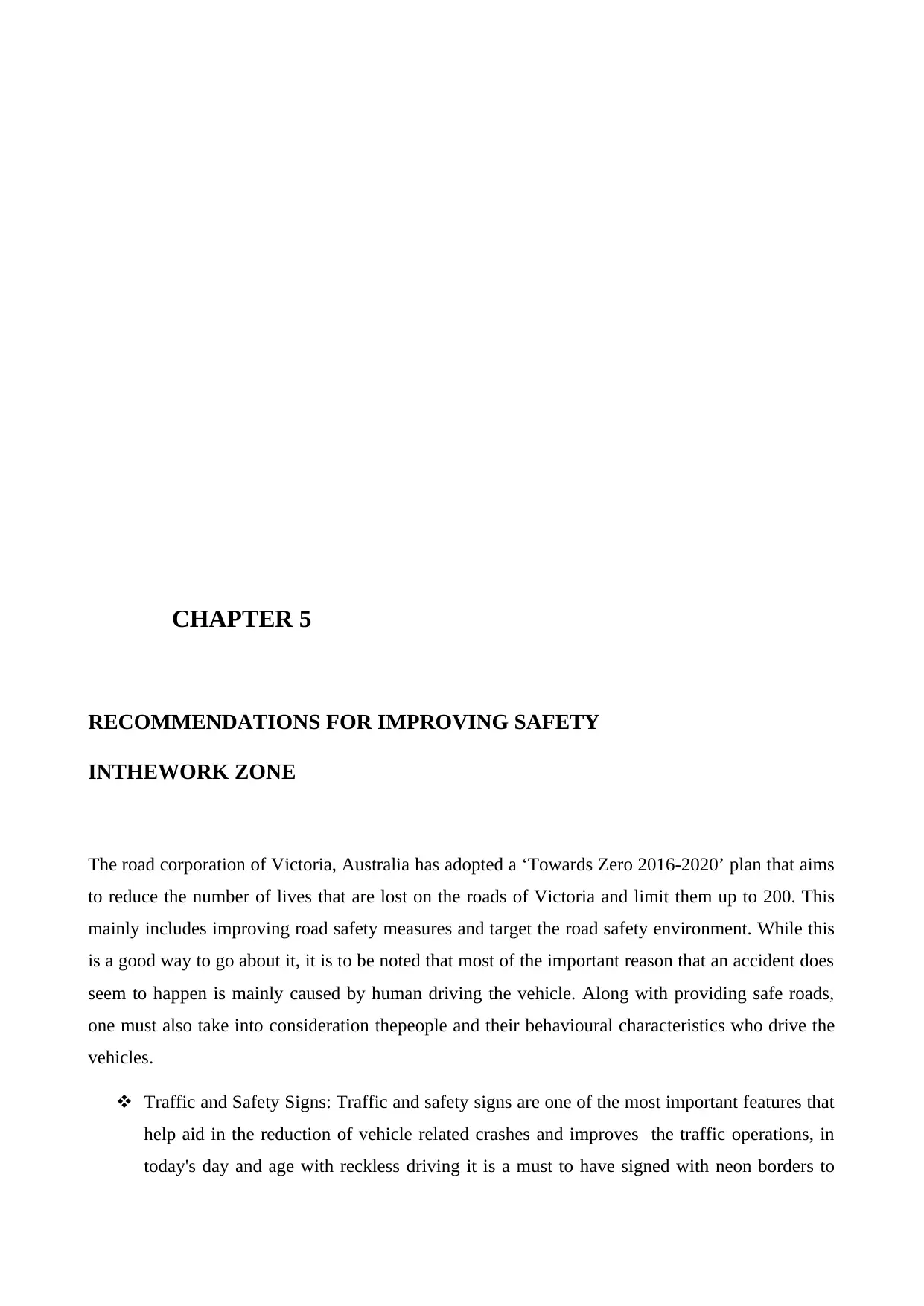
CHAPTER 5
RECOMMENDATIONS FOR IMPROVING SAFETY
INTHEWORK ZONE
The road corporation of Victoria, Australia has adopted a ‘Towards Zero 2016-2020’ plan that aims
to reduce the number of lives that are lost on the roads of Victoria and limit them up to 200. This
mainly includes improving road safety measures and target the road safety environment. While this
is a good way to go about it, it is to be noted that most of the important reason that an accident does
seem to happen is mainly caused by human driving the vehicle. Along with providing safe roads,
one must also take into consideration thepeople and their behavioural characteristics who drive the
vehicles.
Traffic and Safety Signs: Traffic and safety signs are one of the most important features that
help aid in the reduction of vehicle related crashes and improves the traffic operations, in
today's day and age with reckless driving it is a must to have signed with neon borders to
RECOMMENDATIONS FOR IMPROVING SAFETY
INTHEWORK ZONE
The road corporation of Victoria, Australia has adopted a ‘Towards Zero 2016-2020’ plan that aims
to reduce the number of lives that are lost on the roads of Victoria and limit them up to 200. This
mainly includes improving road safety measures and target the road safety environment. While this
is a good way to go about it, it is to be noted that most of the important reason that an accident does
seem to happen is mainly caused by human driving the vehicle. Along with providing safe roads,
one must also take into consideration thepeople and their behavioural characteristics who drive the
vehicles.
Traffic and Safety Signs: Traffic and safety signs are one of the most important features that
help aid in the reduction of vehicle related crashes and improves the traffic operations, in
today's day and age with reckless driving it is a must to have signed with neon borders to
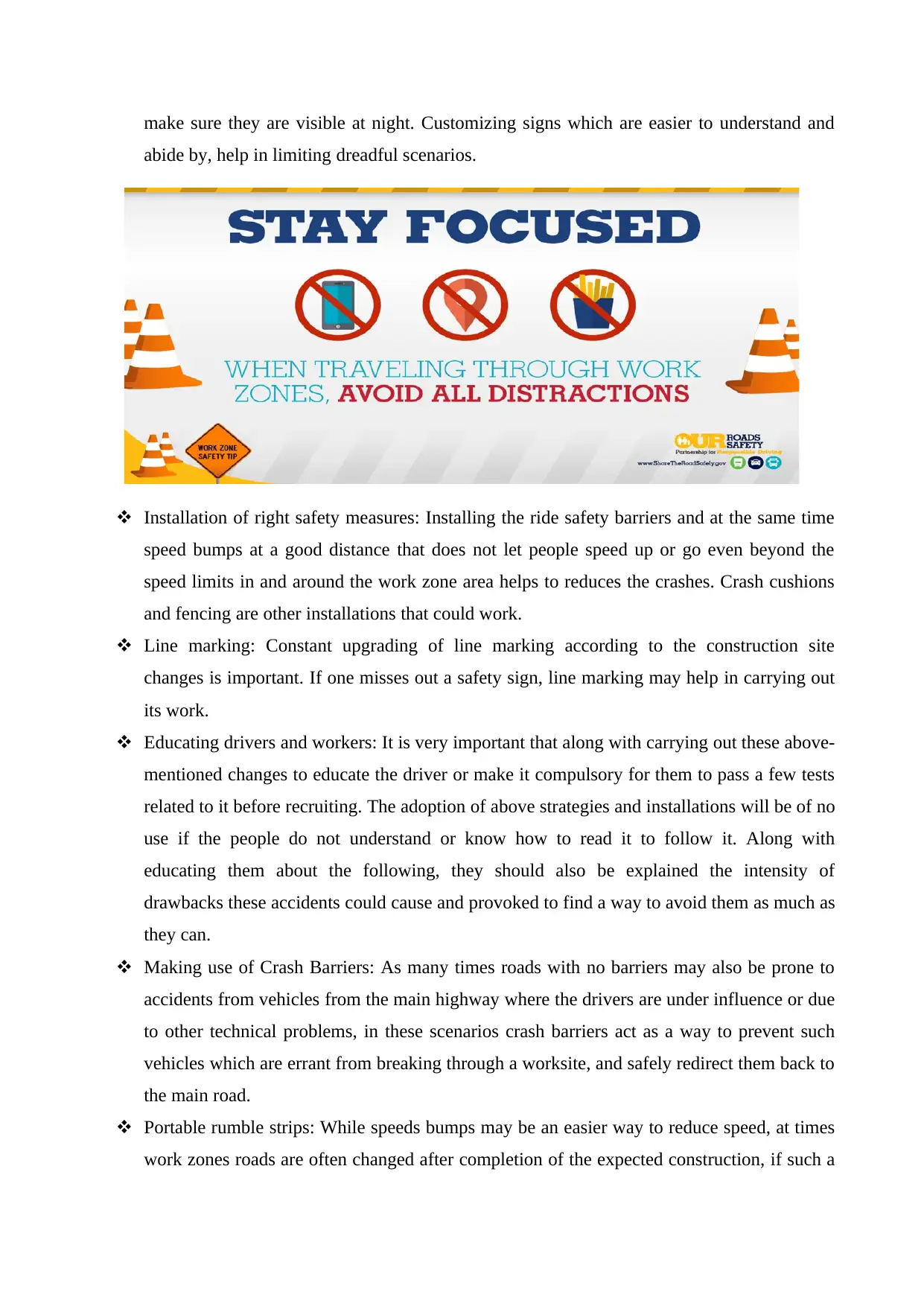
make sure they are visible at night. Customizing signs which are easier to understand and
abide by, help in limiting dreadful scenarios.
Installation of right safety measures: Installing the ride safety barriers and at the same time
speed bumps at a good distance that does not let people speed up or go even beyond the
speed limits in and around the work zone area helps to reduces the crashes. Crash cushions
and fencing are other installations that could work.
Line marking: Constant upgrading of line marking according to the construction site
changes is important. If one misses out a safety sign, line marking may help in carrying out
its work.
Educating drivers and workers: It is very important that along with carrying out these above-
mentioned changes to educate the driver or make it compulsory for them to pass a few tests
related to it before recruiting. The adoption of above strategies and installations will be of no
use if the people do not understand or know how to read it to follow it. Along with
educating them about the following, they should also be explained the intensity of
drawbacks these accidents could cause and provoked to find a way to avoid them as much as
they can.
Making use of Crash Barriers: As many times roads with no barriers may also be prone to
accidents from vehicles from the main highway where the drivers are under influence or due
to other technical problems, in these scenarios crash barriers act as a way to prevent such
vehicles which are errant from breaking through a worksite, and safely redirect them back to
the main road.
Portable rumble strips: While speeds bumps may be an easier way to reduce speed, at times
work zones roads are often changed after completion of the expected construction, if such a
abide by, help in limiting dreadful scenarios.
Installation of right safety measures: Installing the ride safety barriers and at the same time
speed bumps at a good distance that does not let people speed up or go even beyond the
speed limits in and around the work zone area helps to reduces the crashes. Crash cushions
and fencing are other installations that could work.
Line marking: Constant upgrading of line marking according to the construction site
changes is important. If one misses out a safety sign, line marking may help in carrying out
its work.
Educating drivers and workers: It is very important that along with carrying out these above-
mentioned changes to educate the driver or make it compulsory for them to pass a few tests
related to it before recruiting. The adoption of above strategies and installations will be of no
use if the people do not understand or know how to read it to follow it. Along with
educating them about the following, they should also be explained the intensity of
drawbacks these accidents could cause and provoked to find a way to avoid them as much as
they can.
Making use of Crash Barriers: As many times roads with no barriers may also be prone to
accidents from vehicles from the main highway where the drivers are under influence or due
to other technical problems, in these scenarios crash barriers act as a way to prevent such
vehicles which are errant from breaking through a worksite, and safely redirect them back to
the main road.
Portable rumble strips: While speeds bumps may be an easier way to reduce speed, at times
work zones roads are often changed after completion of the expected construction, if such a
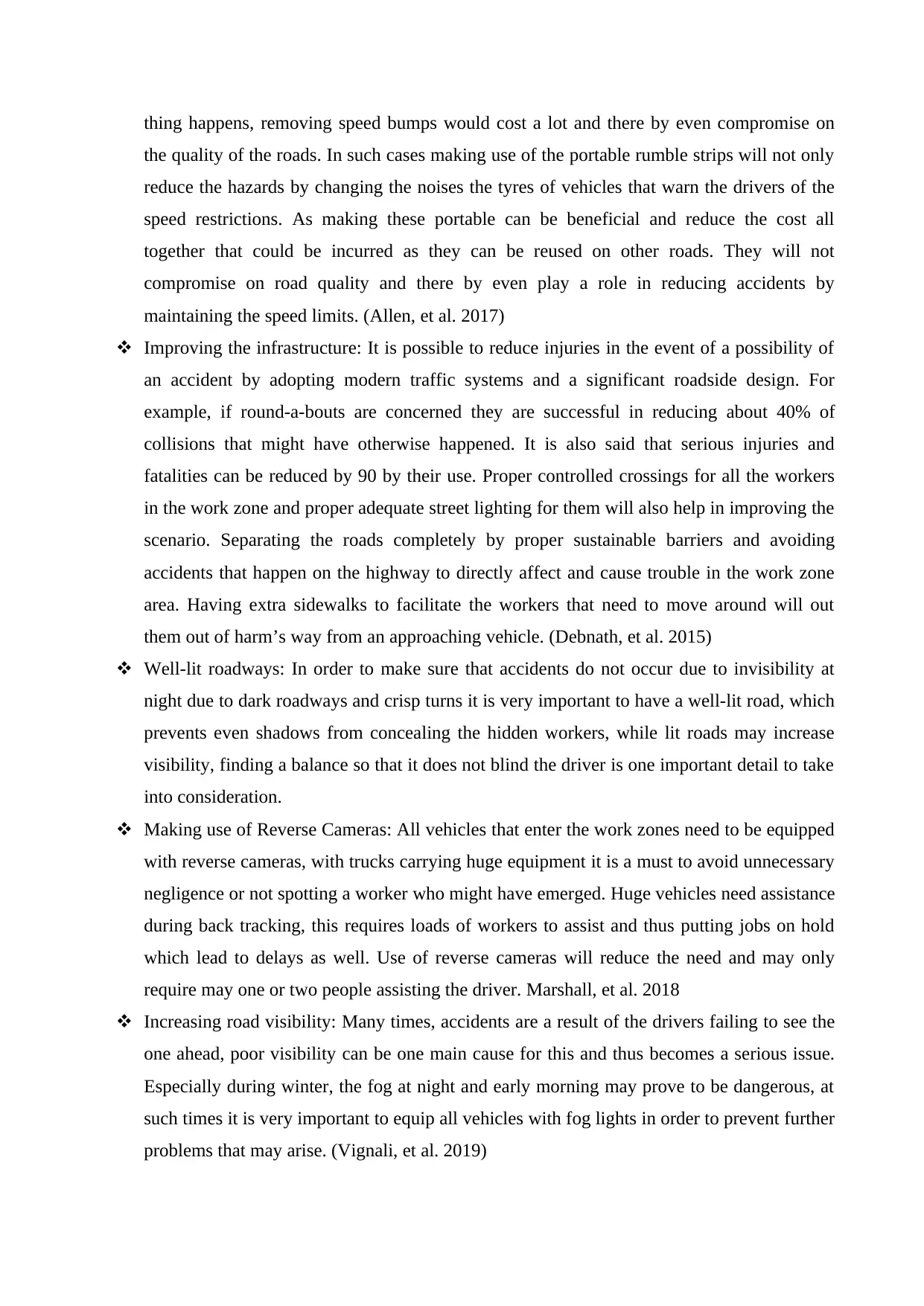
thing happens, removing speed bumps would cost a lot and there by even compromise on
the quality of the roads. In such cases making use of the portable rumble strips will not only
reduce the hazards by changing the noises the tyres of vehicles that warn the drivers of the
speed restrictions. As making these portable can be beneficial and reduce the cost all
together that could be incurred as they can be reused on other roads. They will not
compromise on road quality and there by even play a role in reducing accidents by
maintaining the speed limits. (Allen, et al. 2017)
Improving the infrastructure: It is possible to reduce injuries in the event of a possibility of
an accident by adopting modern traffic systems and a significant roadside design. For
example, if round-a-bouts are concerned they are successful in reducing about 40% of
collisions that might have otherwise happened. It is also said that serious injuries and
fatalities can be reduced by 90 by their use. Proper controlled crossings for all the workers
in the work zone and proper adequate street lighting for them will also help in improving the
scenario. Separating the roads completely by proper sustainable barriers and avoiding
accidents that happen on the highway to directly affect and cause trouble in the work zone
area. Having extra sidewalks to facilitate the workers that need to move around will out
them out of harm’s way from an approaching vehicle. (Debnath, et al. 2015)
Well-lit roadways: In order to make sure that accidents do not occur due to invisibility at
night due to dark roadways and crisp turns it is very important to have a well-lit road, which
prevents even shadows from concealing the hidden workers, while lit roads may increase
visibility, finding a balance so that it does not blind the driver is one important detail to take
into consideration.
Making use of Reverse Cameras: All vehicles that enter the work zones need to be equipped
with reverse cameras, with trucks carrying huge equipment it is a must to avoid unnecessary
negligence or not spotting a worker who might have emerged. Huge vehicles need assistance
during back tracking, this requires loads of workers to assist and thus putting jobs on hold
which lead to delays as well. Use of reverse cameras will reduce the need and may only
require may one or two people assisting the driver. Marshall, et al. 2018
Increasing road visibility: Many times, accidents are a result of the drivers failing to see the
one ahead, poor visibility can be one main cause for this and thus becomes a serious issue.
Especially during winter, the fog at night and early morning may prove to be dangerous, at
such times it is very important to equip all vehicles with fog lights in order to prevent further
problems that may arise. (Vignali, et al. 2019)
the quality of the roads. In such cases making use of the portable rumble strips will not only
reduce the hazards by changing the noises the tyres of vehicles that warn the drivers of the
speed restrictions. As making these portable can be beneficial and reduce the cost all
together that could be incurred as they can be reused on other roads. They will not
compromise on road quality and there by even play a role in reducing accidents by
maintaining the speed limits. (Allen, et al. 2017)
Improving the infrastructure: It is possible to reduce injuries in the event of a possibility of
an accident by adopting modern traffic systems and a significant roadside design. For
example, if round-a-bouts are concerned they are successful in reducing about 40% of
collisions that might have otherwise happened. It is also said that serious injuries and
fatalities can be reduced by 90 by their use. Proper controlled crossings for all the workers
in the work zone and proper adequate street lighting for them will also help in improving the
scenario. Separating the roads completely by proper sustainable barriers and avoiding
accidents that happen on the highway to directly affect and cause trouble in the work zone
area. Having extra sidewalks to facilitate the workers that need to move around will out
them out of harm’s way from an approaching vehicle. (Debnath, et al. 2015)
Well-lit roadways: In order to make sure that accidents do not occur due to invisibility at
night due to dark roadways and crisp turns it is very important to have a well-lit road, which
prevents even shadows from concealing the hidden workers, while lit roads may increase
visibility, finding a balance so that it does not blind the driver is one important detail to take
into consideration.
Making use of Reverse Cameras: All vehicles that enter the work zones need to be equipped
with reverse cameras, with trucks carrying huge equipment it is a must to avoid unnecessary
negligence or not spotting a worker who might have emerged. Huge vehicles need assistance
during back tracking, this requires loads of workers to assist and thus putting jobs on hold
which lead to delays as well. Use of reverse cameras will reduce the need and may only
require may one or two people assisting the driver. Marshall, et al. 2018
Increasing road visibility: Many times, accidents are a result of the drivers failing to see the
one ahead, poor visibility can be one main cause for this and thus becomes a serious issue.
Especially during winter, the fog at night and early morning may prove to be dangerous, at
such times it is very important to equip all vehicles with fog lights in order to prevent further
problems that may arise. (Vignali, et al. 2019)
Secure Best Marks with AI Grader
Need help grading? Try our AI Grader for instant feedback on your assignments.
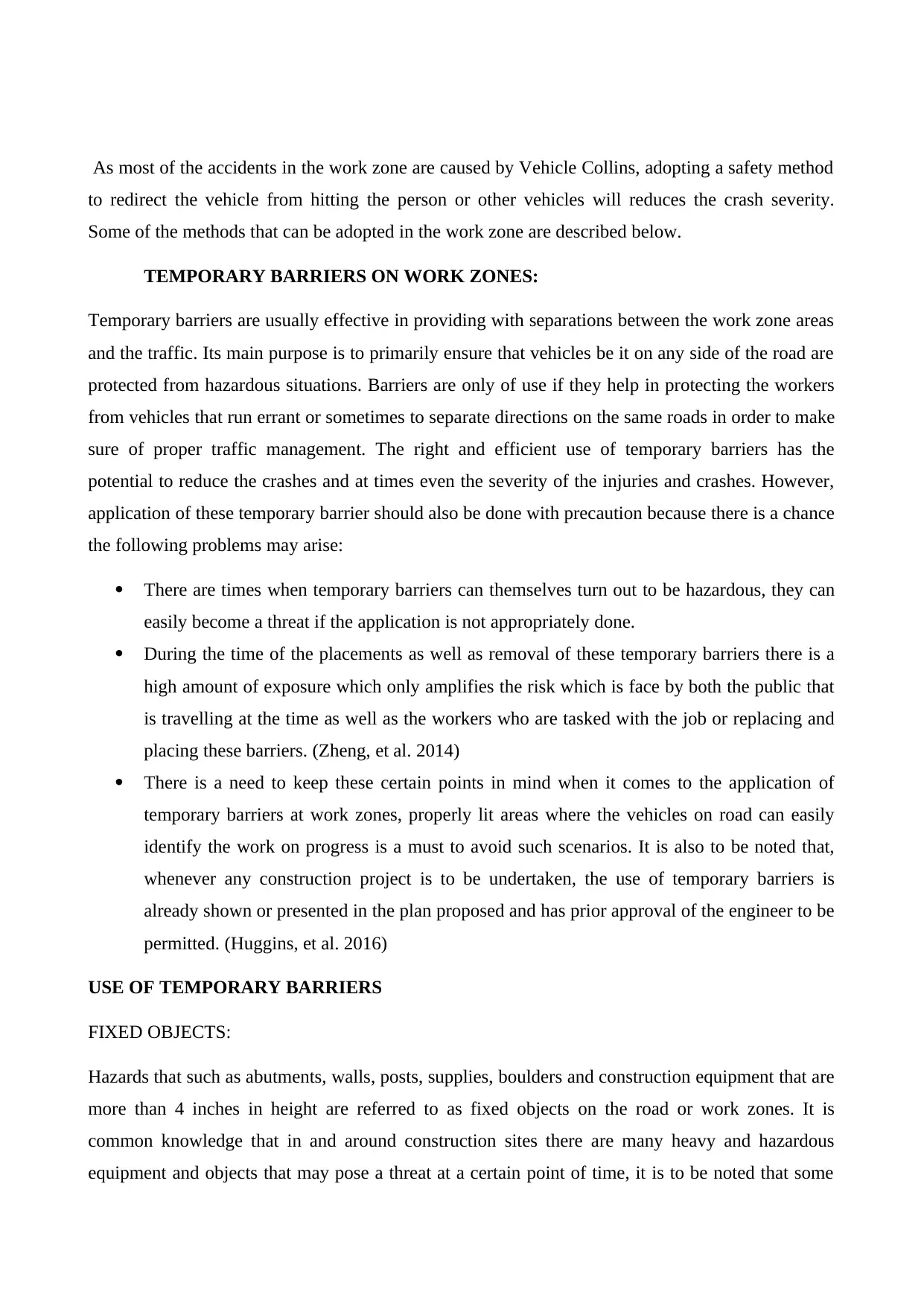
As most of the accidents in the work zone are caused by Vehicle Collins, adopting a safety method
to redirect the vehicle from hitting the person or other vehicles will reduces the crash severity.
Some of the methods that can be adopted in the work zone are described below.
TEMPORARY BARRIERS ON WORK ZONES:
Temporary barriers are usually effective in providing with separations between the work zone areas
and the traffic. Its main purpose is to primarily ensure that vehicles be it on any side of the road are
protected from hazardous situations. Barriers are only of use if they help in protecting the workers
from vehicles that run errant or sometimes to separate directions on the same roads in order to make
sure of proper traffic management. The right and efficient use of temporary barriers has the
potential to reduce the crashes and at times even the severity of the injuries and crashes. However,
application of these temporary barrier should also be done with precaution because there is a chance
the following problems may arise:
There are times when temporary barriers can themselves turn out to be hazardous, they can
easily become a threat if the application is not appropriately done.
During the time of the placements as well as removal of these temporary barriers there is a
high amount of exposure which only amplifies the risk which is face by both the public that
is travelling at the time as well as the workers who are tasked with the job or replacing and
placing these barriers. (Zheng, et al. 2014)
There is a need to keep these certain points in mind when it comes to the application of
temporary barriers at work zones, properly lit areas where the vehicles on road can easily
identify the work on progress is a must to avoid such scenarios. It is also to be noted that,
whenever any construction project is to be undertaken, the use of temporary barriers is
already shown or presented in the plan proposed and has prior approval of the engineer to be
permitted. (Huggins, et al. 2016)
USE OF TEMPORARY BARRIERS
FIXED OBJECTS:
Hazards that such as abutments, walls, posts, supplies, boulders and construction equipment that are
more than 4 inches in height are referred to as fixed objects on the road or work zones. It is
common knowledge that in and around construction sites there are many heavy and hazardous
equipment and objects that may pose a threat at a certain point of time, it is to be noted that some
to redirect the vehicle from hitting the person or other vehicles will reduces the crash severity.
Some of the methods that can be adopted in the work zone are described below.
TEMPORARY BARRIERS ON WORK ZONES:
Temporary barriers are usually effective in providing with separations between the work zone areas
and the traffic. Its main purpose is to primarily ensure that vehicles be it on any side of the road are
protected from hazardous situations. Barriers are only of use if they help in protecting the workers
from vehicles that run errant or sometimes to separate directions on the same roads in order to make
sure of proper traffic management. The right and efficient use of temporary barriers has the
potential to reduce the crashes and at times even the severity of the injuries and crashes. However,
application of these temporary barrier should also be done with precaution because there is a chance
the following problems may arise:
There are times when temporary barriers can themselves turn out to be hazardous, they can
easily become a threat if the application is not appropriately done.
During the time of the placements as well as removal of these temporary barriers there is a
high amount of exposure which only amplifies the risk which is face by both the public that
is travelling at the time as well as the workers who are tasked with the job or replacing and
placing these barriers. (Zheng, et al. 2014)
There is a need to keep these certain points in mind when it comes to the application of
temporary barriers at work zones, properly lit areas where the vehicles on road can easily
identify the work on progress is a must to avoid such scenarios. It is also to be noted that,
whenever any construction project is to be undertaken, the use of temporary barriers is
already shown or presented in the plan proposed and has prior approval of the engineer to be
permitted. (Huggins, et al. 2016)
USE OF TEMPORARY BARRIERS
FIXED OBJECTS:
Hazards that such as abutments, walls, posts, supplies, boulders and construction equipment that are
more than 4 inches in height are referred to as fixed objects on the road or work zones. It is
common knowledge that in and around construction sites there are many heavy and hazardous
equipment and objects that may pose a threat at a certain point of time, it is to be noted that some

portable barriers not only divide streets or roads but also help in protecting this equipment and at
the same time the drivers on the road that might miss or ignore its existence.
Another important to keep in mind which should be implemented as a rule as well should be that
fact that all fixed objects should not be in the clear work zone areas/ roads which are usually used
by transport unless they are properly protected by temporary barriers. In rare cases, if an engineer
gives a go to not needing temporary barriers for these fixed objects then it may be considered
practical.Also in order for smooth functioning, traffic management devices like changeable message
signs which may be portable and arrow boards can be used but usually do not need to protected by
barriers.
PORTABLE CONCRETE BARRIERS (PCB):
Portable concrete barriers are usually the concrete walls that stand between the work zones and
casual traffic roads and are free standing segments of mac 30 feet length and have connecting
devices which are built in, in order to avoid and deflect intrusions from either sides and lead to
other roadside accidents and injuries. (Zain, et al. 2015)They are usually segments which are
individually connected by flexible joints and hence the impact of the deflection it causes is very
much dependent on the connection system of joints and each section’s length. As they are
individual segments, it ensures a good performance when it comes to absorbing impact. They are
usually useful of higher speed roadways and need to be approved by highway agencies.
(Mohammed, et al. 2017)
BALLAST FILLED BARRIERS
These are usually segmented barriers od plastic shells made of polyethylene, which are specifically
designed to be used with a ballast and it may be of water or sand. They are usually used in the
similar way to Portable Concrete Barriers but procure an advantage which is that the placement of
these barriers is very easy because of its feature that is low weight. They are usually filled with
water in order to help steer cars back vehicles and redirect them back to the roads. (Gover, et al.
2015)
They can be used to draw attention towards a particular place that needs to be avoided or when
filled properly can be used in the urban areas that are more prone to low speed areas and when
the same time the drivers on the road that might miss or ignore its existence.
Another important to keep in mind which should be implemented as a rule as well should be that
fact that all fixed objects should not be in the clear work zone areas/ roads which are usually used
by transport unless they are properly protected by temporary barriers. In rare cases, if an engineer
gives a go to not needing temporary barriers for these fixed objects then it may be considered
practical.Also in order for smooth functioning, traffic management devices like changeable message
signs which may be portable and arrow boards can be used but usually do not need to protected by
barriers.
PORTABLE CONCRETE BARRIERS (PCB):
Portable concrete barriers are usually the concrete walls that stand between the work zones and
casual traffic roads and are free standing segments of mac 30 feet length and have connecting
devices which are built in, in order to avoid and deflect intrusions from either sides and lead to
other roadside accidents and injuries. (Zain, et al. 2015)They are usually segments which are
individually connected by flexible joints and hence the impact of the deflection it causes is very
much dependent on the connection system of joints and each section’s length. As they are
individual segments, it ensures a good performance when it comes to absorbing impact. They are
usually useful of higher speed roadways and need to be approved by highway agencies.
(Mohammed, et al. 2017)
BALLAST FILLED BARRIERS
These are usually segmented barriers od plastic shells made of polyethylene, which are specifically
designed to be used with a ballast and it may be of water or sand. They are usually used in the
similar way to Portable Concrete Barriers but procure an advantage which is that the placement of
these barriers is very easy because of its feature that is low weight. They are usually filled with
water in order to help steer cars back vehicles and redirect them back to the roads. (Gover, et al.
2015)
They can be used to draw attention towards a particular place that needs to be avoided or when
filled properly can be used in the urban areas that are more prone to low speed areas and when
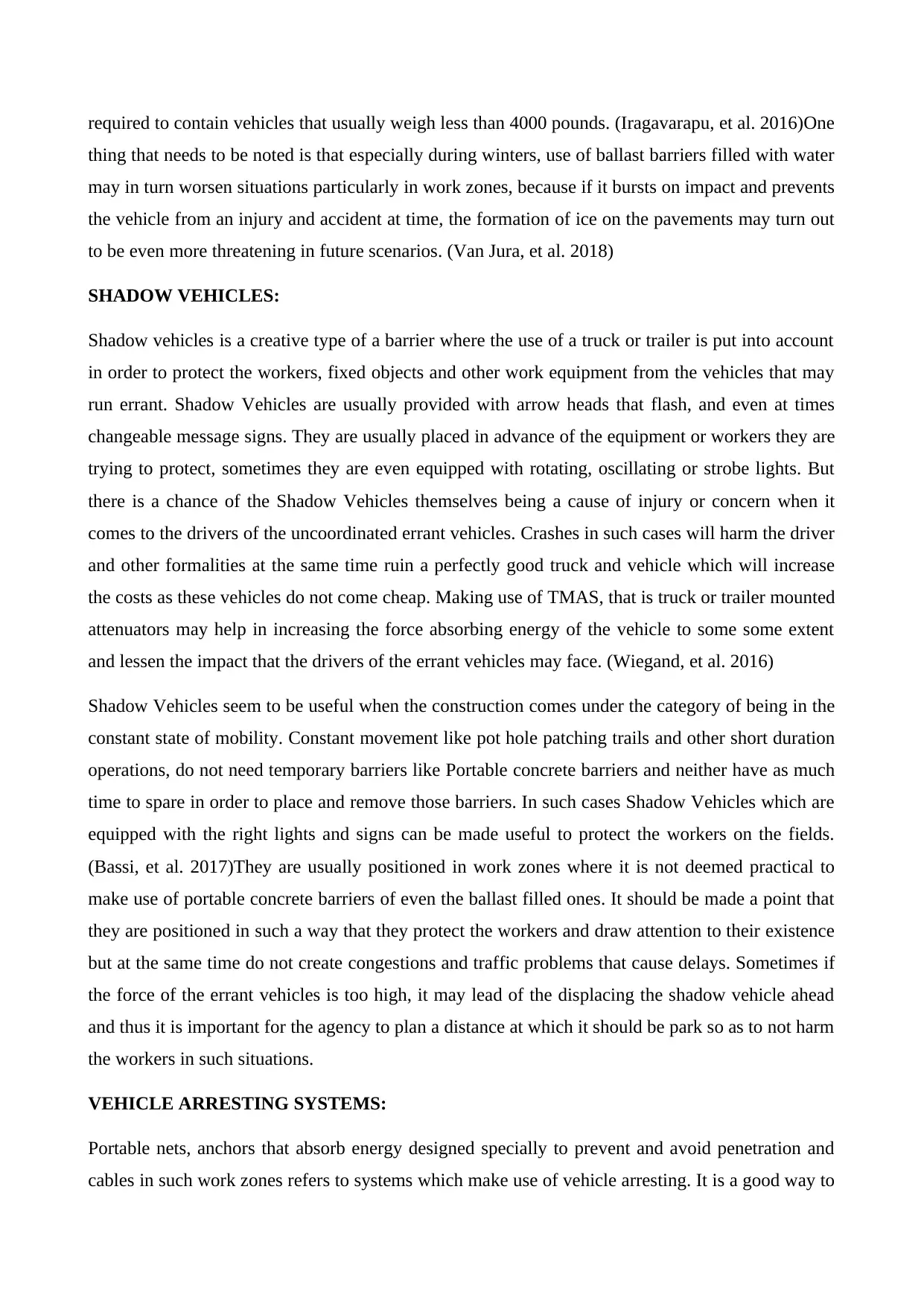
required to contain vehicles that usually weigh less than 4000 pounds. (Iragavarapu, et al. 2016)One
thing that needs to be noted is that especially during winters, use of ballast barriers filled with water
may in turn worsen situations particularly in work zones, because if it bursts on impact and prevents
the vehicle from an injury and accident at time, the formation of ice on the pavements may turn out
to be even more threatening in future scenarios. (Van Jura, et al. 2018)
SHADOW VEHICLES:
Shadow vehicles is a creative type of a barrier where the use of a truck or trailer is put into account
in order to protect the workers, fixed objects and other work equipment from the vehicles that may
run errant. Shadow Vehicles are usually provided with arrow heads that flash, and even at times
changeable message signs. They are usually placed in advance of the equipment or workers they are
trying to protect, sometimes they are even equipped with rotating, oscillating or strobe lights. But
there is a chance of the Shadow Vehicles themselves being a cause of injury or concern when it
comes to the drivers of the uncoordinated errant vehicles. Crashes in such cases will harm the driver
and other formalities at the same time ruin a perfectly good truck and vehicle which will increase
the costs as these vehicles do not come cheap. Making use of TMAS, that is truck or trailer mounted
attenuators may help in increasing the force absorbing energy of the vehicle to some some extent
and lessen the impact that the drivers of the errant vehicles may face. (Wiegand, et al. 2016)
Shadow Vehicles seem to be useful when the construction comes under the category of being in the
constant state of mobility. Constant movement like pot hole patching trails and other short duration
operations, do not need temporary barriers like Portable concrete barriers and neither have as much
time to spare in order to place and remove those barriers. In such cases Shadow Vehicles which are
equipped with the right lights and signs can be made useful to protect the workers on the fields.
(Bassi, et al. 2017)They are usually positioned in work zones where it is not deemed practical to
make use of portable concrete barriers of even the ballast filled ones. It should be made a point that
they are positioned in such a way that they protect the workers and draw attention to their existence
but at the same time do not create congestions and traffic problems that cause delays. Sometimes if
the force of the errant vehicles is too high, it may lead of the displacing the shadow vehicle ahead
and thus it is important for the agency to plan a distance at which it should be park so as to not harm
the workers in such situations.
VEHICLE ARRESTING SYSTEMS:
Portable nets, anchors that absorb energy designed specially to prevent and avoid penetration and
cables in such work zones refers to systems which make use of vehicle arresting. It is a good way to
thing that needs to be noted is that especially during winters, use of ballast barriers filled with water
may in turn worsen situations particularly in work zones, because if it bursts on impact and prevents
the vehicle from an injury and accident at time, the formation of ice on the pavements may turn out
to be even more threatening in future scenarios. (Van Jura, et al. 2018)
SHADOW VEHICLES:
Shadow vehicles is a creative type of a barrier where the use of a truck or trailer is put into account
in order to protect the workers, fixed objects and other work equipment from the vehicles that may
run errant. Shadow Vehicles are usually provided with arrow heads that flash, and even at times
changeable message signs. They are usually placed in advance of the equipment or workers they are
trying to protect, sometimes they are even equipped with rotating, oscillating or strobe lights. But
there is a chance of the Shadow Vehicles themselves being a cause of injury or concern when it
comes to the drivers of the uncoordinated errant vehicles. Crashes in such cases will harm the driver
and other formalities at the same time ruin a perfectly good truck and vehicle which will increase
the costs as these vehicles do not come cheap. Making use of TMAS, that is truck or trailer mounted
attenuators may help in increasing the force absorbing energy of the vehicle to some some extent
and lessen the impact that the drivers of the errant vehicles may face. (Wiegand, et al. 2016)
Shadow Vehicles seem to be useful when the construction comes under the category of being in the
constant state of mobility. Constant movement like pot hole patching trails and other short duration
operations, do not need temporary barriers like Portable concrete barriers and neither have as much
time to spare in order to place and remove those barriers. In such cases Shadow Vehicles which are
equipped with the right lights and signs can be made useful to protect the workers on the fields.
(Bassi, et al. 2017)They are usually positioned in work zones where it is not deemed practical to
make use of portable concrete barriers of even the ballast filled ones. It should be made a point that
they are positioned in such a way that they protect the workers and draw attention to their existence
but at the same time do not create congestions and traffic problems that cause delays. Sometimes if
the force of the errant vehicles is too high, it may lead of the displacing the shadow vehicle ahead
and thus it is important for the agency to plan a distance at which it should be park so as to not harm
the workers in such situations.
VEHICLE ARRESTING SYSTEMS:
Portable nets, anchors that absorb energy designed specially to prevent and avoid penetration and
cables in such work zones refers to systems which make use of vehicle arresting. It is a good way to
Paraphrase This Document
Need a fresh take? Get an instant paraphrase of this document with our AI Paraphraser
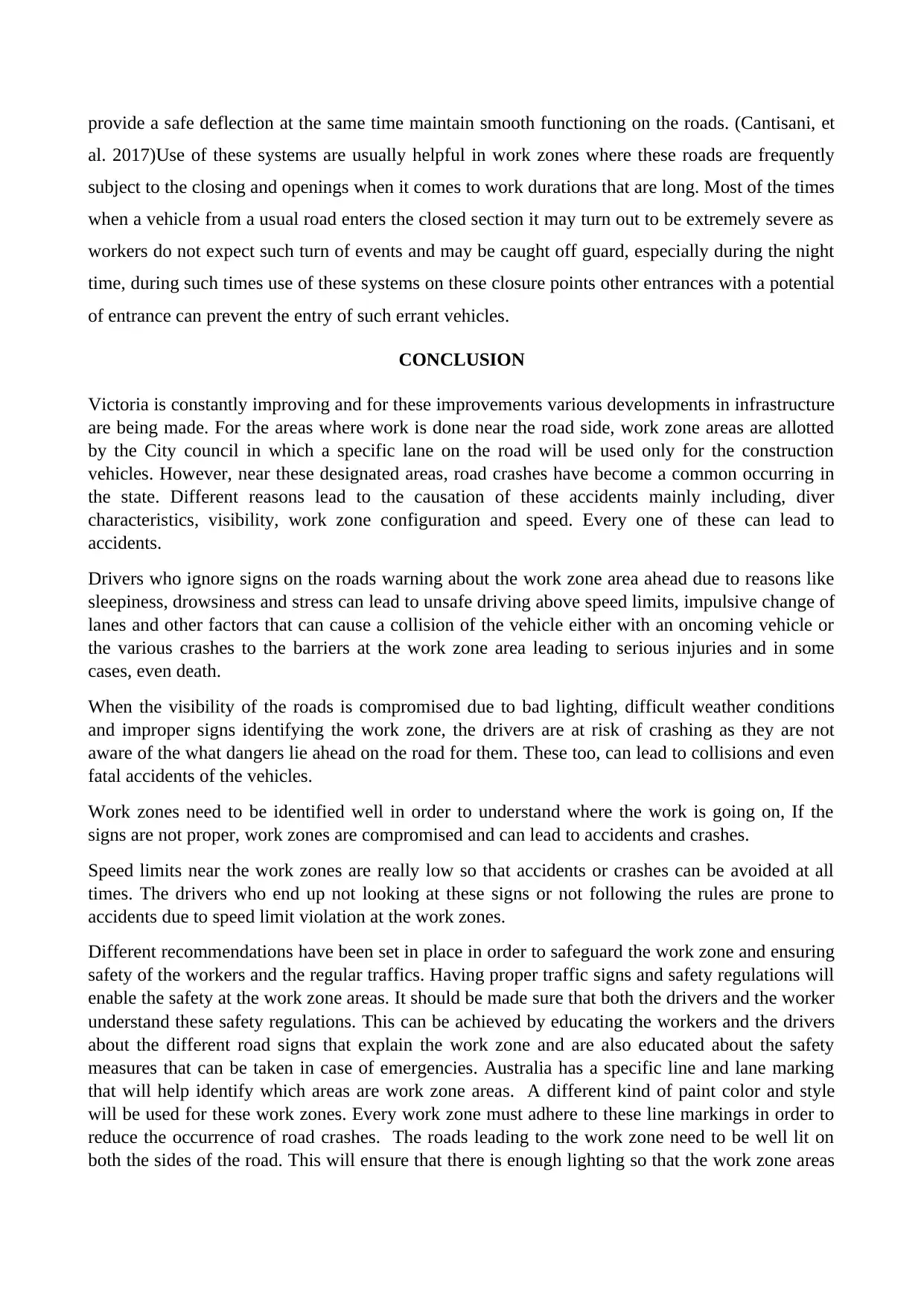
provide a safe deflection at the same time maintain smooth functioning on the roads. (Cantisani, et
al. 2017)Use of these systems are usually helpful in work zones where these roads are frequently
subject to the closing and openings when it comes to work durations that are long. Most of the times
when a vehicle from a usual road enters the closed section it may turn out to be extremely severe as
workers do not expect such turn of events and may be caught off guard, especially during the night
time, during such times use of these systems on these closure points other entrances with a potential
of entrance can prevent the entry of such errant vehicles.
CONCLUSION
Victoria is constantly improving and for these improvements various developments in infrastructure
are being made. For the areas where work is done near the road side, work zone areas are allotted
by the City council in which a specific lane on the road will be used only for the construction
vehicles. However, near these designated areas, road crashes have become a common occurring in
the state. Different reasons lead to the causation of these accidents mainly including, diver
characteristics, visibility, work zone configuration and speed. Every one of these can lead to
accidents.
Drivers who ignore signs on the roads warning about the work zone area ahead due to reasons like
sleepiness, drowsiness and stress can lead to unsafe driving above speed limits, impulsive change of
lanes and other factors that can cause a collision of the vehicle either with an oncoming vehicle or
the various crashes to the barriers at the work zone area leading to serious injuries and in some
cases, even death.
When the visibility of the roads is compromised due to bad lighting, difficult weather conditions
and improper signs identifying the work zone, the drivers are at risk of crashing as they are not
aware of the what dangers lie ahead on the road for them. These too, can lead to collisions and even
fatal accidents of the vehicles.
Work zones need to be identified well in order to understand where the work is going on, If the
signs are not proper, work zones are compromised and can lead to accidents and crashes.
Speed limits near the work zones are really low so that accidents or crashes can be avoided at all
times. The drivers who end up not looking at these signs or not following the rules are prone to
accidents due to speed limit violation at the work zones.
Different recommendations have been set in place in order to safeguard the work zone and ensuring
safety of the workers and the regular traffics. Having proper traffic signs and safety regulations will
enable the safety at the work zone areas. It should be made sure that both the drivers and the worker
understand these safety regulations. This can be achieved by educating the workers and the drivers
about the different road signs that explain the work zone and are also educated about the safety
measures that can be taken in case of emergencies. Australia has a specific line and lane marking
that will help identify which areas are work zone areas. A different kind of paint color and style
will be used for these work zones. Every work zone must adhere to these line markings in order to
reduce the occurrence of road crashes. The roads leading to the work zone need to be well lit on
both the sides of the road. This will ensure that there is enough lighting so that the work zone areas
al. 2017)Use of these systems are usually helpful in work zones where these roads are frequently
subject to the closing and openings when it comes to work durations that are long. Most of the times
when a vehicle from a usual road enters the closed section it may turn out to be extremely severe as
workers do not expect such turn of events and may be caught off guard, especially during the night
time, during such times use of these systems on these closure points other entrances with a potential
of entrance can prevent the entry of such errant vehicles.
CONCLUSION
Victoria is constantly improving and for these improvements various developments in infrastructure
are being made. For the areas where work is done near the road side, work zone areas are allotted
by the City council in which a specific lane on the road will be used only for the construction
vehicles. However, near these designated areas, road crashes have become a common occurring in
the state. Different reasons lead to the causation of these accidents mainly including, diver
characteristics, visibility, work zone configuration and speed. Every one of these can lead to
accidents.
Drivers who ignore signs on the roads warning about the work zone area ahead due to reasons like
sleepiness, drowsiness and stress can lead to unsafe driving above speed limits, impulsive change of
lanes and other factors that can cause a collision of the vehicle either with an oncoming vehicle or
the various crashes to the barriers at the work zone area leading to serious injuries and in some
cases, even death.
When the visibility of the roads is compromised due to bad lighting, difficult weather conditions
and improper signs identifying the work zone, the drivers are at risk of crashing as they are not
aware of the what dangers lie ahead on the road for them. These too, can lead to collisions and even
fatal accidents of the vehicles.
Work zones need to be identified well in order to understand where the work is going on, If the
signs are not proper, work zones are compromised and can lead to accidents and crashes.
Speed limits near the work zones are really low so that accidents or crashes can be avoided at all
times. The drivers who end up not looking at these signs or not following the rules are prone to
accidents due to speed limit violation at the work zones.
Different recommendations have been set in place in order to safeguard the work zone and ensuring
safety of the workers and the regular traffics. Having proper traffic signs and safety regulations will
enable the safety at the work zone areas. It should be made sure that both the drivers and the worker
understand these safety regulations. This can be achieved by educating the workers and the drivers
about the different road signs that explain the work zone and are also educated about the safety
measures that can be taken in case of emergencies. Australia has a specific line and lane marking
that will help identify which areas are work zone areas. A different kind of paint color and style
will be used for these work zones. Every work zone must adhere to these line markings in order to
reduce the occurrence of road crashes. The roads leading to the work zone need to be well lit on
both the sides of the road. This will ensure that there is enough lighting so that the work zone areas
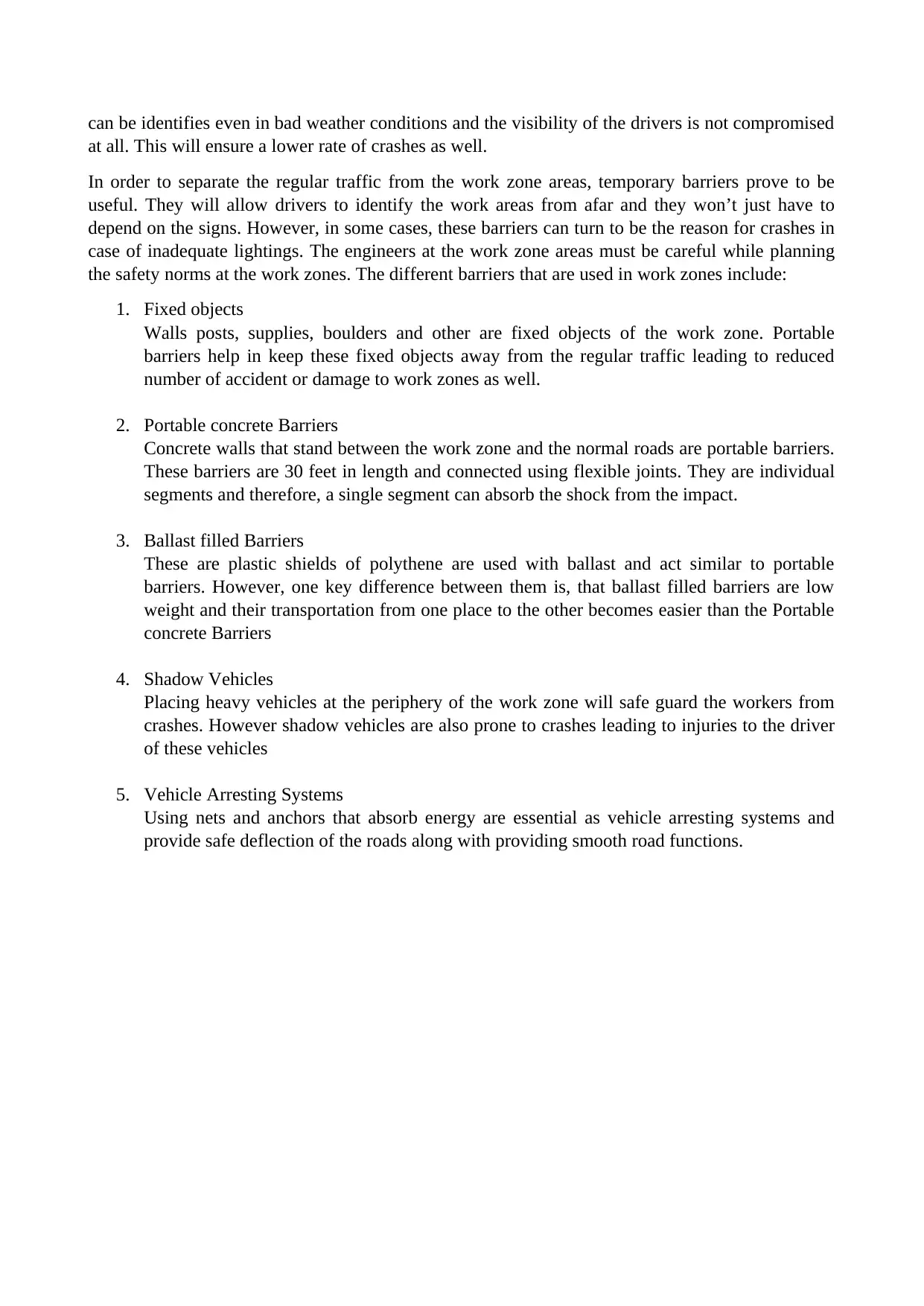
can be identifies even in bad weather conditions and the visibility of the drivers is not compromised
at all. This will ensure a lower rate of crashes as well.
In order to separate the regular traffic from the work zone areas, temporary barriers prove to be
useful. They will allow drivers to identify the work areas from afar and they won’t just have to
depend on the signs. However, in some cases, these barriers can turn to be the reason for crashes in
case of inadequate lightings. The engineers at the work zone areas must be careful while planning
the safety norms at the work zones. The different barriers that are used in work zones include:
1. Fixed objects
Walls posts, supplies, boulders and other are fixed objects of the work zone. Portable
barriers help in keep these fixed objects away from the regular traffic leading to reduced
number of accident or damage to work zones as well.
2. Portable concrete Barriers
Concrete walls that stand between the work zone and the normal roads are portable barriers.
These barriers are 30 feet in length and connected using flexible joints. They are individual
segments and therefore, a single segment can absorb the shock from the impact.
3. Ballast filled Barriers
These are plastic shields of polythene are used with ballast and act similar to portable
barriers. However, one key difference between them is, that ballast filled barriers are low
weight and their transportation from one place to the other becomes easier than the Portable
concrete Barriers
4. Shadow Vehicles
Placing heavy vehicles at the periphery of the work zone will safe guard the workers from
crashes. However shadow vehicles are also prone to crashes leading to injuries to the driver
of these vehicles
5. Vehicle Arresting Systems
Using nets and anchors that absorb energy are essential as vehicle arresting systems and
provide safe deflection of the roads along with providing smooth road functions.
at all. This will ensure a lower rate of crashes as well.
In order to separate the regular traffic from the work zone areas, temporary barriers prove to be
useful. They will allow drivers to identify the work areas from afar and they won’t just have to
depend on the signs. However, in some cases, these barriers can turn to be the reason for crashes in
case of inadequate lightings. The engineers at the work zone areas must be careful while planning
the safety norms at the work zones. The different barriers that are used in work zones include:
1. Fixed objects
Walls posts, supplies, boulders and other are fixed objects of the work zone. Portable
barriers help in keep these fixed objects away from the regular traffic leading to reduced
number of accident or damage to work zones as well.
2. Portable concrete Barriers
Concrete walls that stand between the work zone and the normal roads are portable barriers.
These barriers are 30 feet in length and connected using flexible joints. They are individual
segments and therefore, a single segment can absorb the shock from the impact.
3. Ballast filled Barriers
These are plastic shields of polythene are used with ballast and act similar to portable
barriers. However, one key difference between them is, that ballast filled barriers are low
weight and their transportation from one place to the other becomes easier than the Portable
concrete Barriers
4. Shadow Vehicles
Placing heavy vehicles at the periphery of the work zone will safe guard the workers from
crashes. However shadow vehicles are also prone to crashes leading to injuries to the driver
of these vehicles
5. Vehicle Arresting Systems
Using nets and anchors that absorb energy are essential as vehicle arresting systems and
provide safe deflection of the roads along with providing smooth road functions.
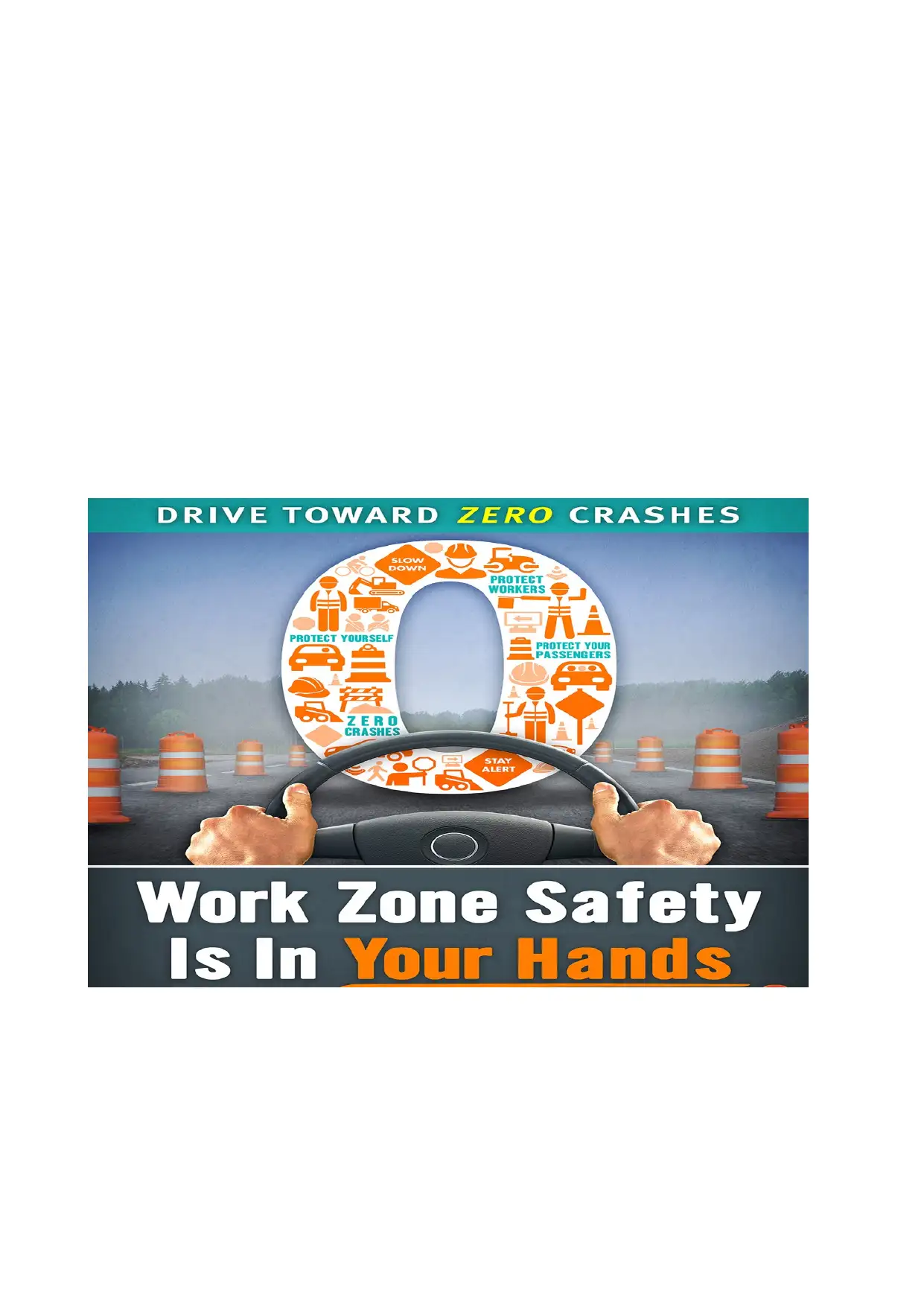
Secure Best Marks with AI Grader
Need help grading? Try our AI Grader for instant feedback on your assignments.
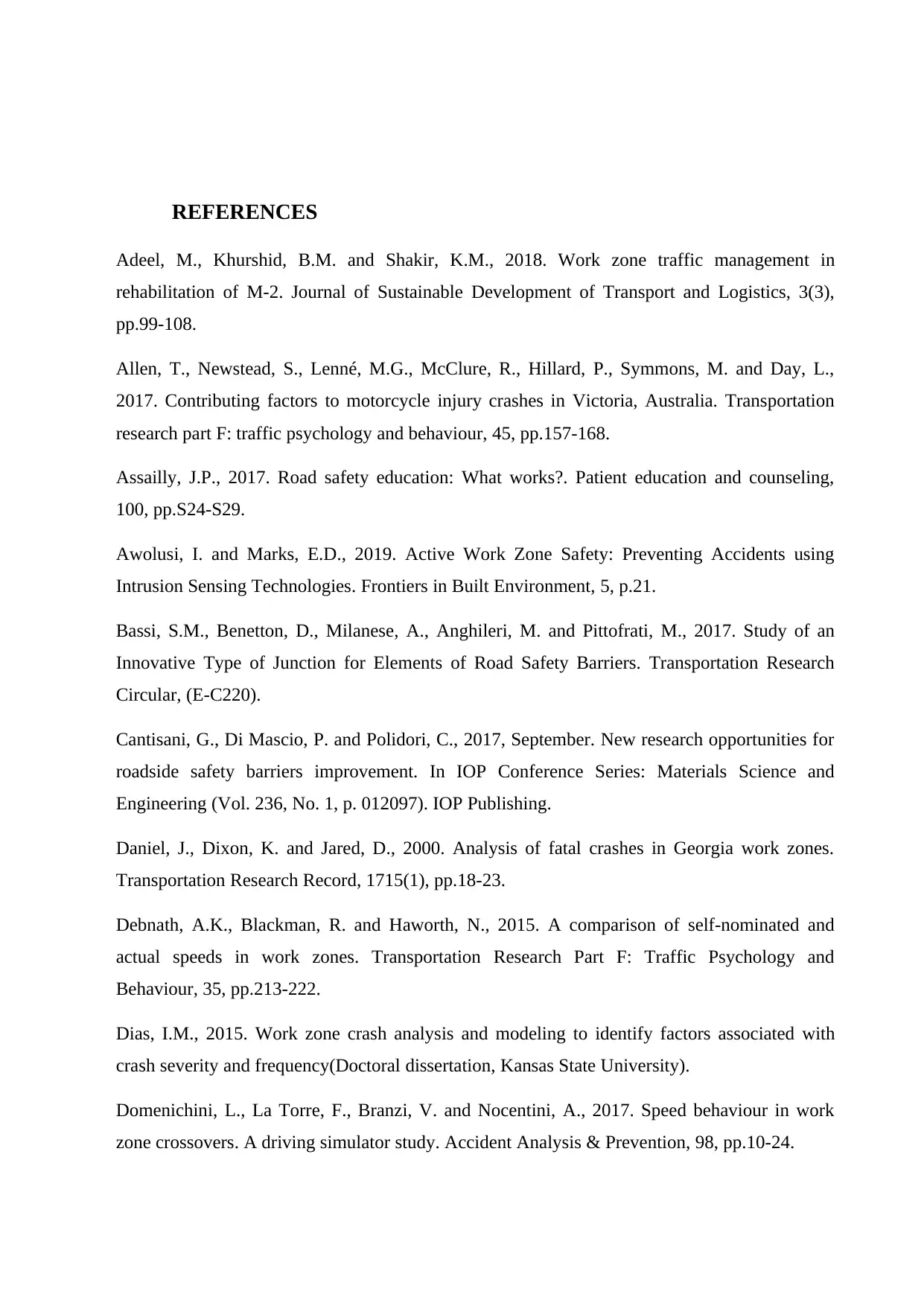
REFERENCES
Adeel, M., Khurshid, B.M. and Shakir, K.M., 2018. Work zone traffic management in
rehabilitation of M-2. Journal of Sustainable Development of Transport and Logistics, 3(3),
pp.99-108.
Allen, T., Newstead, S., Lenné, M.G., McClure, R., Hillard, P., Symmons, M. and Day, L.,
2017. Contributing factors to motorcycle injury crashes in Victoria, Australia. Transportation
research part F: traffic psychology and behaviour, 45, pp.157-168.
Assailly, J.P., 2017. Road safety education: What works?. Patient education and counseling,
100, pp.S24-S29.
Awolusi, I. and Marks, E.D., 2019. Active Work Zone Safety: Preventing Accidents using
Intrusion Sensing Technologies. Frontiers in Built Environment, 5, p.21.
Bassi, S.M., Benetton, D., Milanese, A., Anghileri, M. and Pittofrati, M., 2017. Study of an
Innovative Type of Junction for Elements of Road Safety Barriers. Transportation Research
Circular, (E-C220).
Cantisani, G., Di Mascio, P. and Polidori, C., 2017, September. New research opportunities for
roadside safety barriers improvement. In IOP Conference Series: Materials Science and
Engineering (Vol. 236, No. 1, p. 012097). IOP Publishing.
Daniel, J., Dixon, K. and Jared, D., 2000. Analysis of fatal crashes in Georgia work zones.
Transportation Research Record, 1715(1), pp.18-23.
Debnath, A.K., Blackman, R. and Haworth, N., 2015. A comparison of self-nominated and
actual speeds in work zones. Transportation Research Part F: Traffic Psychology and
Behaviour, 35, pp.213-222.
Dias, I.M., 2015. Work zone crash analysis and modeling to identify factors associated with
crash severity and frequency(Doctoral dissertation, Kansas State University).
Domenichini, L., La Torre, F., Branzi, V. and Nocentini, A., 2017. Speed behaviour in work
zone crossovers. A driving simulator study. Accident Analysis & Prevention, 98, pp.10-24.
Adeel, M., Khurshid, B.M. and Shakir, K.M., 2018. Work zone traffic management in
rehabilitation of M-2. Journal of Sustainable Development of Transport and Logistics, 3(3),
pp.99-108.
Allen, T., Newstead, S., Lenné, M.G., McClure, R., Hillard, P., Symmons, M. and Day, L.,
2017. Contributing factors to motorcycle injury crashes in Victoria, Australia. Transportation
research part F: traffic psychology and behaviour, 45, pp.157-168.
Assailly, J.P., 2017. Road safety education: What works?. Patient education and counseling,
100, pp.S24-S29.
Awolusi, I. and Marks, E.D., 2019. Active Work Zone Safety: Preventing Accidents using
Intrusion Sensing Technologies. Frontiers in Built Environment, 5, p.21.
Bassi, S.M., Benetton, D., Milanese, A., Anghileri, M. and Pittofrati, M., 2017. Study of an
Innovative Type of Junction for Elements of Road Safety Barriers. Transportation Research
Circular, (E-C220).
Cantisani, G., Di Mascio, P. and Polidori, C., 2017, September. New research opportunities for
roadside safety barriers improvement. In IOP Conference Series: Materials Science and
Engineering (Vol. 236, No. 1, p. 012097). IOP Publishing.
Daniel, J., Dixon, K. and Jared, D., 2000. Analysis of fatal crashes in Georgia work zones.
Transportation Research Record, 1715(1), pp.18-23.
Debnath, A.K., Blackman, R. and Haworth, N., 2015. A comparison of self-nominated and
actual speeds in work zones. Transportation Research Part F: Traffic Psychology and
Behaviour, 35, pp.213-222.
Dias, I.M., 2015. Work zone crash analysis and modeling to identify factors associated with
crash severity and frequency(Doctoral dissertation, Kansas State University).
Domenichini, L., La Torre, F., Branzi, V. and Nocentini, A., 2017. Speed behaviour in work
zone crossovers. A driving simulator study. Accident Analysis & Prevention, 98, pp.10-24.
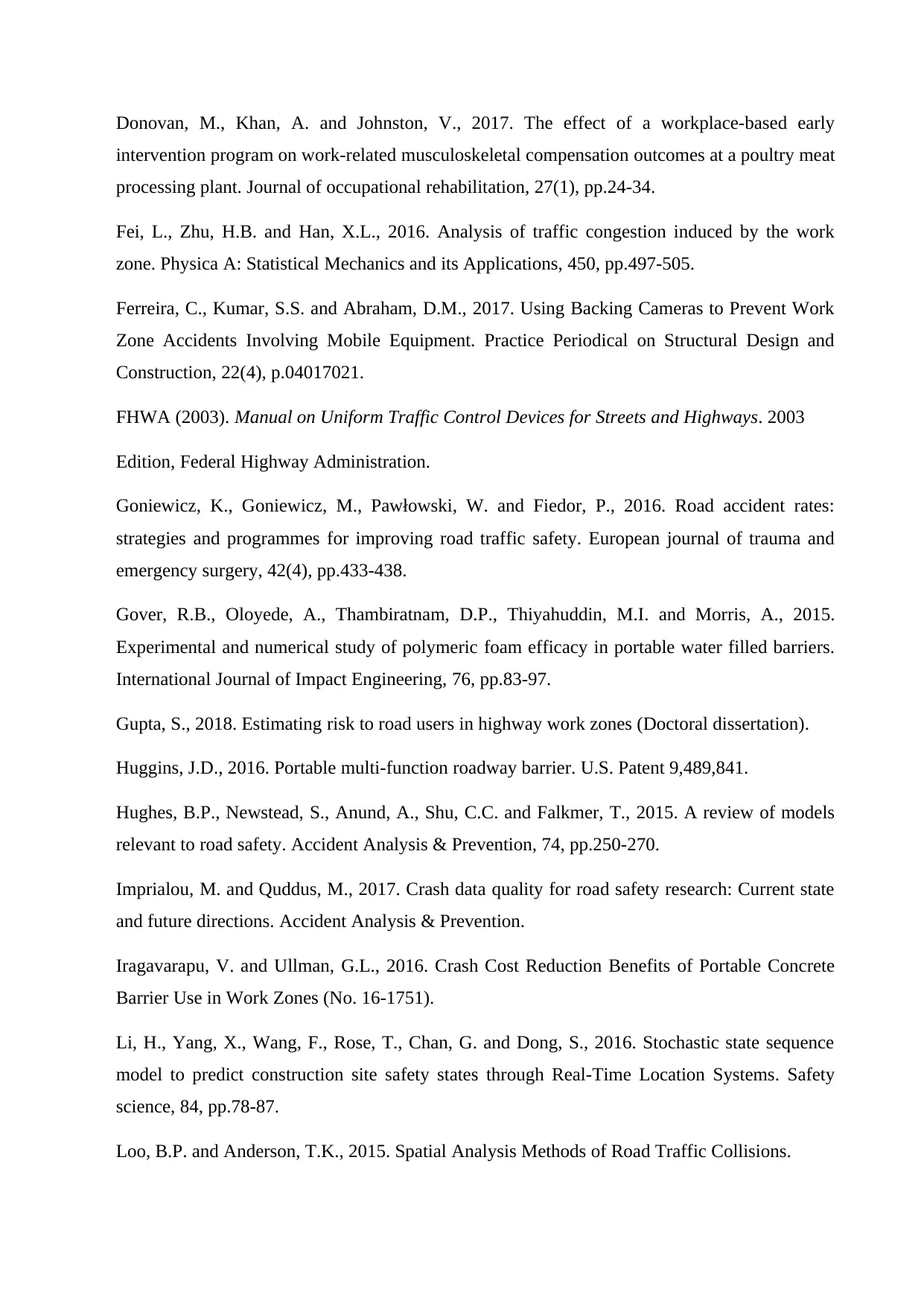
Donovan, M., Khan, A. and Johnston, V., 2017. The effect of a workplace-based early
intervention program on work-related musculoskeletal compensation outcomes at a poultry meat
processing plant. Journal of occupational rehabilitation, 27(1), pp.24-34.
Fei, L., Zhu, H.B. and Han, X.L., 2016. Analysis of traffic congestion induced by the work
zone. Physica A: Statistical Mechanics and its Applications, 450, pp.497-505.
Ferreira, C., Kumar, S.S. and Abraham, D.M., 2017. Using Backing Cameras to Prevent Work
Zone Accidents Involving Mobile Equipment. Practice Periodical on Structural Design and
Construction, 22(4), p.04017021.
FHWA (2003). Manual on Uniform Traffic Control Devices for Streets and Highways. 2003
Edition, Federal Highway Administration.
Goniewicz, K., Goniewicz, M., Pawłowski, W. and Fiedor, P., 2016. Road accident rates:
strategies and programmes for improving road traffic safety. European journal of trauma and
emergency surgery, 42(4), pp.433-438.
Gover, R.B., Oloyede, A., Thambiratnam, D.P., Thiyahuddin, M.I. and Morris, A., 2015.
Experimental and numerical study of polymeric foam efficacy in portable water filled barriers.
International Journal of Impact Engineering, 76, pp.83-97.
Gupta, S., 2018. Estimating risk to road users in highway work zones (Doctoral dissertation).
Huggins, J.D., 2016. Portable multi-function roadway barrier. U.S. Patent 9,489,841.
Hughes, B.P., Newstead, S., Anund, A., Shu, C.C. and Falkmer, T., 2015. A review of models
relevant to road safety. Accident Analysis & Prevention, 74, pp.250-270.
Imprialou, M. and Quddus, M., 2017. Crash data quality for road safety research: Current state
and future directions. Accident Analysis & Prevention.
Iragavarapu, V. and Ullman, G.L., 2016. Crash Cost Reduction Benefits of Portable Concrete
Barrier Use in Work Zones (No. 16-1751).
Li, H., Yang, X., Wang, F., Rose, T., Chan, G. and Dong, S., 2016. Stochastic state sequence
model to predict construction site safety states through Real-Time Location Systems. Safety
science, 84, pp.78-87.
Loo, B.P. and Anderson, T.K., 2015. Spatial Analysis Methods of Road Traffic Collisions.
intervention program on work-related musculoskeletal compensation outcomes at a poultry meat
processing plant. Journal of occupational rehabilitation, 27(1), pp.24-34.
Fei, L., Zhu, H.B. and Han, X.L., 2016. Analysis of traffic congestion induced by the work
zone. Physica A: Statistical Mechanics and its Applications, 450, pp.497-505.
Ferreira, C., Kumar, S.S. and Abraham, D.M., 2017. Using Backing Cameras to Prevent Work
Zone Accidents Involving Mobile Equipment. Practice Periodical on Structural Design and
Construction, 22(4), p.04017021.
FHWA (2003). Manual on Uniform Traffic Control Devices for Streets and Highways. 2003
Edition, Federal Highway Administration.
Goniewicz, K., Goniewicz, M., Pawłowski, W. and Fiedor, P., 2016. Road accident rates:
strategies and programmes for improving road traffic safety. European journal of trauma and
emergency surgery, 42(4), pp.433-438.
Gover, R.B., Oloyede, A., Thambiratnam, D.P., Thiyahuddin, M.I. and Morris, A., 2015.
Experimental and numerical study of polymeric foam efficacy in portable water filled barriers.
International Journal of Impact Engineering, 76, pp.83-97.
Gupta, S., 2018. Estimating risk to road users in highway work zones (Doctoral dissertation).
Huggins, J.D., 2016. Portable multi-function roadway barrier. U.S. Patent 9,489,841.
Hughes, B.P., Newstead, S., Anund, A., Shu, C.C. and Falkmer, T., 2015. A review of models
relevant to road safety. Accident Analysis & Prevention, 74, pp.250-270.
Imprialou, M. and Quddus, M., 2017. Crash data quality for road safety research: Current state
and future directions. Accident Analysis & Prevention.
Iragavarapu, V. and Ullman, G.L., 2016. Crash Cost Reduction Benefits of Portable Concrete
Barrier Use in Work Zones (No. 16-1751).
Li, H., Yang, X., Wang, F., Rose, T., Chan, G. and Dong, S., 2016. Stochastic state sequence
model to predict construction site safety states through Real-Time Location Systems. Safety
science, 84, pp.78-87.
Loo, B.P. and Anderson, T.K., 2015. Spatial Analysis Methods of Road Traffic Collisions.
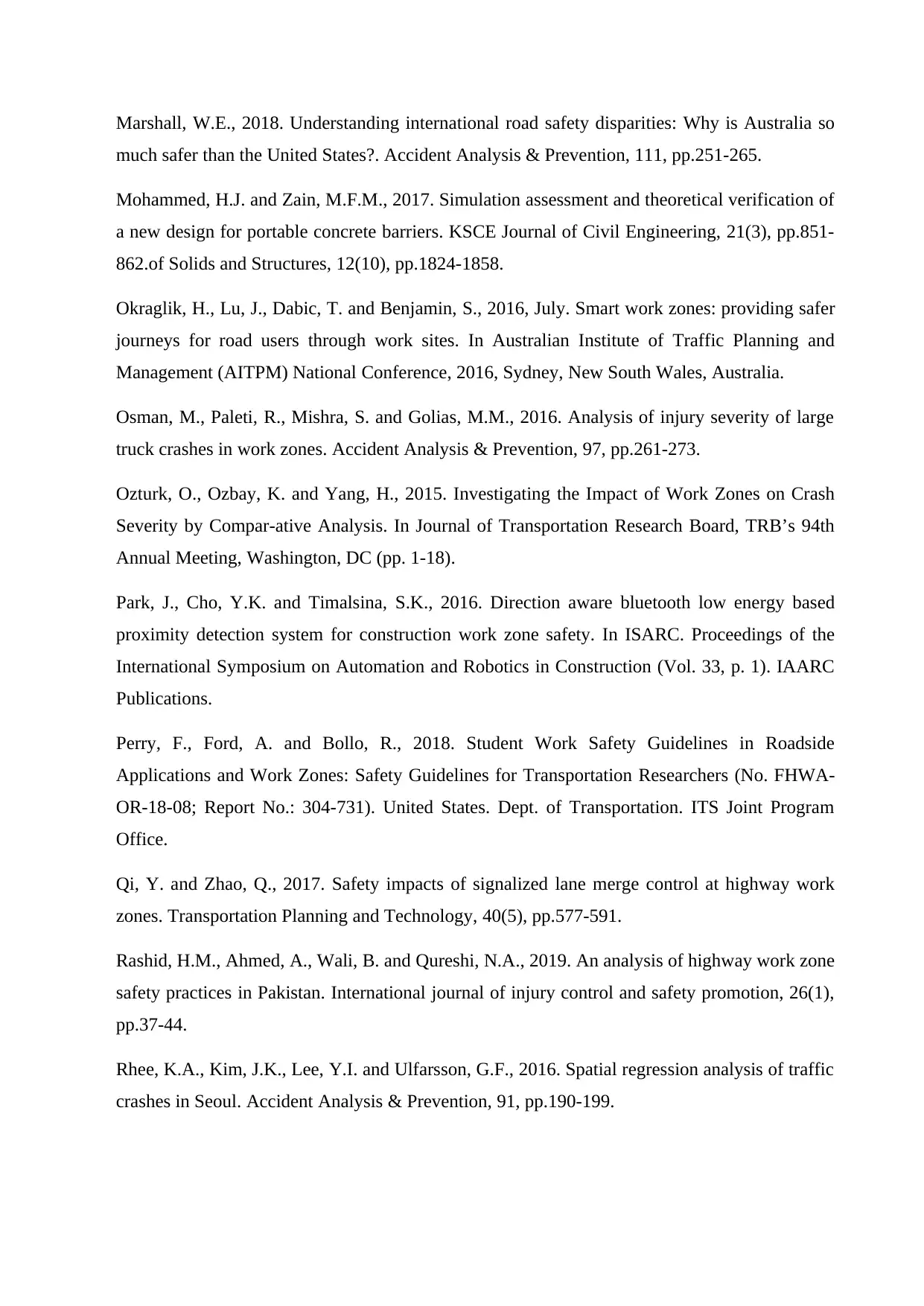
Marshall, W.E., 2018. Understanding international road safety disparities: Why is Australia so
much safer than the United States?. Accident Analysis & Prevention, 111, pp.251-265.
Mohammed, H.J. and Zain, M.F.M., 2017. Simulation assessment and theoretical verification of
a new design for portable concrete barriers. KSCE Journal of Civil Engineering, 21(3), pp.851-
862.of Solids and Structures, 12(10), pp.1824-1858.
Okraglik, H., Lu, J., Dabic, T. and Benjamin, S., 2016, July. Smart work zones: providing safer
journeys for road users through work sites. In Australian Institute of Traffic Planning and
Management (AITPM) National Conference, 2016, Sydney, New South Wales, Australia.
Osman, M., Paleti, R., Mishra, S. and Golias, M.M., 2016. Analysis of injury severity of large
truck crashes in work zones. Accident Analysis & Prevention, 97, pp.261-273.
Ozturk, O., Ozbay, K. and Yang, H., 2015. Investigating the Impact of Work Zones on Crash
Severity by Compar-ative Analysis. In Journal of Transportation Research Board, TRB’s 94th
Annual Meeting, Washington, DC (pp. 1-18).
Park, J., Cho, Y.K. and Timalsina, S.K., 2016. Direction aware bluetooth low energy based
proximity detection system for construction work zone safety. In ISARC. Proceedings of the
International Symposium on Automation and Robotics in Construction (Vol. 33, p. 1). IAARC
Publications.
Perry, F., Ford, A. and Bollo, R., 2018. Student Work Safety Guidelines in Roadside
Applications and Work Zones: Safety Guidelines for Transportation Researchers (No. FHWA-
OR-18-08; Report No.: 304-731). United States. Dept. of Transportation. ITS Joint Program
Office.
Qi, Y. and Zhao, Q., 2017. Safety impacts of signalized lane merge control at highway work
zones. Transportation Planning and Technology, 40(5), pp.577-591.
Rashid, H.M., Ahmed, A., Wali, B. and Qureshi, N.A., 2019. An analysis of highway work zone
safety practices in Pakistan. International journal of injury control and safety promotion, 26(1),
pp.37-44.
Rhee, K.A., Kim, J.K., Lee, Y.I. and Ulfarsson, G.F., 2016. Spatial regression analysis of traffic
crashes in Seoul. Accident Analysis & Prevention, 91, pp.190-199.
much safer than the United States?. Accident Analysis & Prevention, 111, pp.251-265.
Mohammed, H.J. and Zain, M.F.M., 2017. Simulation assessment and theoretical verification of
a new design for portable concrete barriers. KSCE Journal of Civil Engineering, 21(3), pp.851-
862.of Solids and Structures, 12(10), pp.1824-1858.
Okraglik, H., Lu, J., Dabic, T. and Benjamin, S., 2016, July. Smart work zones: providing safer
journeys for road users through work sites. In Australian Institute of Traffic Planning and
Management (AITPM) National Conference, 2016, Sydney, New South Wales, Australia.
Osman, M., Paleti, R., Mishra, S. and Golias, M.M., 2016. Analysis of injury severity of large
truck crashes in work zones. Accident Analysis & Prevention, 97, pp.261-273.
Ozturk, O., Ozbay, K. and Yang, H., 2015. Investigating the Impact of Work Zones on Crash
Severity by Compar-ative Analysis. In Journal of Transportation Research Board, TRB’s 94th
Annual Meeting, Washington, DC (pp. 1-18).
Park, J., Cho, Y.K. and Timalsina, S.K., 2016. Direction aware bluetooth low energy based
proximity detection system for construction work zone safety. In ISARC. Proceedings of the
International Symposium on Automation and Robotics in Construction (Vol. 33, p. 1). IAARC
Publications.
Perry, F., Ford, A. and Bollo, R., 2018. Student Work Safety Guidelines in Roadside
Applications and Work Zones: Safety Guidelines for Transportation Researchers (No. FHWA-
OR-18-08; Report No.: 304-731). United States. Dept. of Transportation. ITS Joint Program
Office.
Qi, Y. and Zhao, Q., 2017. Safety impacts of signalized lane merge control at highway work
zones. Transportation Planning and Technology, 40(5), pp.577-591.
Rashid, H.M., Ahmed, A., Wali, B. and Qureshi, N.A., 2019. An analysis of highway work zone
safety practices in Pakistan. International journal of injury control and safety promotion, 26(1),
pp.37-44.
Rhee, K.A., Kim, J.K., Lee, Y.I. and Ulfarsson, G.F., 2016. Spatial regression analysis of traffic
crashes in Seoul. Accident Analysis & Prevention, 91, pp.190-199.
Paraphrase This Document
Need a fresh take? Get an instant paraphrase of this document with our AI Paraphraser
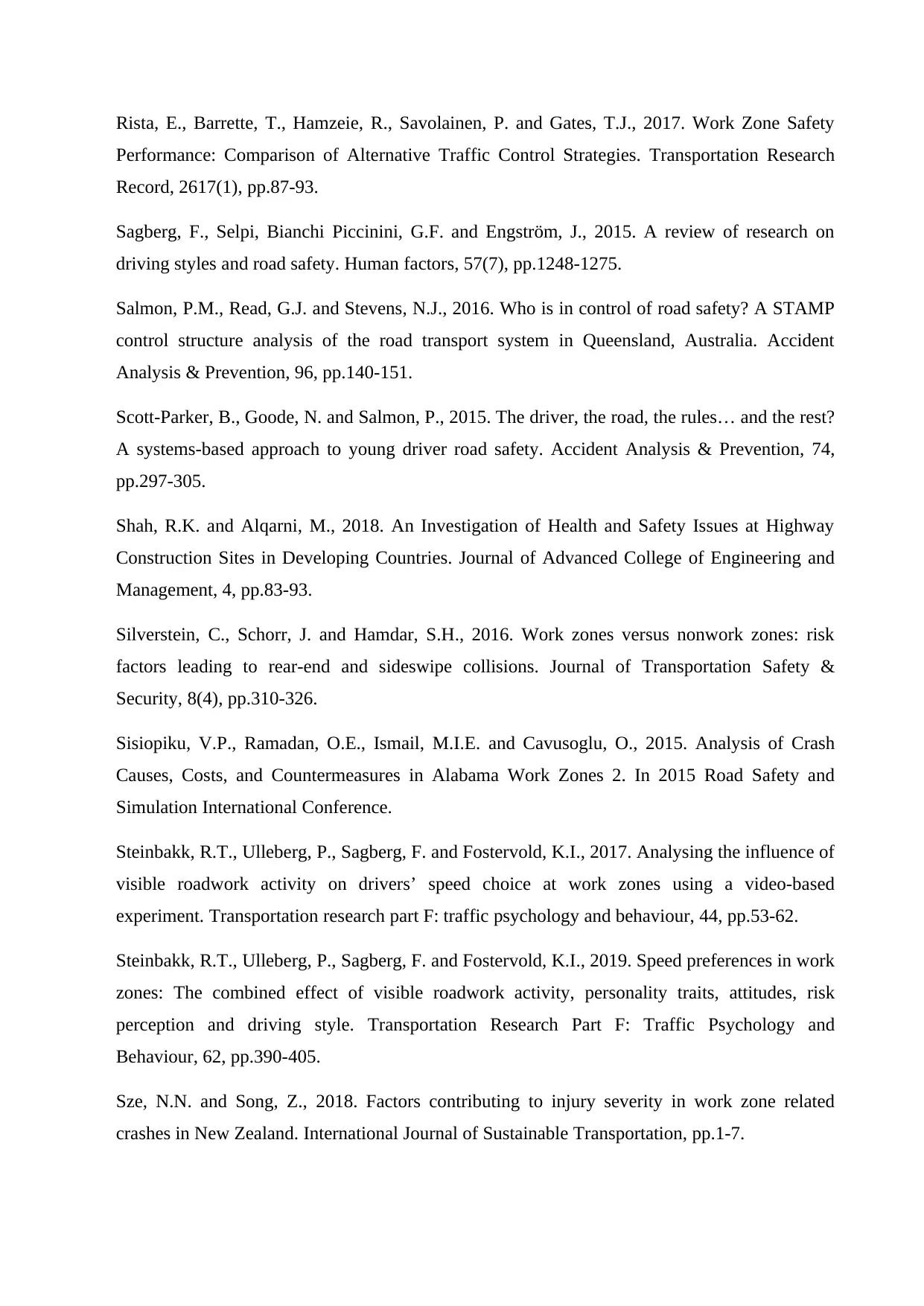
Rista, E., Barrette, T., Hamzeie, R., Savolainen, P. and Gates, T.J., 2017. Work Zone Safety
Performance: Comparison of Alternative Traffic Control Strategies. Transportation Research
Record, 2617(1), pp.87-93.
Sagberg, F., Selpi, Bianchi Piccinini, G.F. and Engström, J., 2015. A review of research on
driving styles and road safety. Human factors, 57(7), pp.1248-1275.
Salmon, P.M., Read, G.J. and Stevens, N.J., 2016. Who is in control of road safety? A STAMP
control structure analysis of the road transport system in Queensland, Australia. Accident
Analysis & Prevention, 96, pp.140-151.
Scott-Parker, B., Goode, N. and Salmon, P., 2015. The driver, the road, the rules… and the rest?
A systems-based approach to young driver road safety. Accident Analysis & Prevention, 74,
pp.297-305.
Shah, R.K. and Alqarni, M., 2018. An Investigation of Health and Safety Issues at Highway
Construction Sites in Developing Countries. Journal of Advanced College of Engineering and
Management, 4, pp.83-93.
Silverstein, C., Schorr, J. and Hamdar, S.H., 2016. Work zones versus nonwork zones: risk
factors leading to rear-end and sideswipe collisions. Journal of Transportation Safety &
Security, 8(4), pp.310-326.
Sisiopiku, V.P., Ramadan, O.E., Ismail, M.I.E. and Cavusoglu, O., 2015. Analysis of Crash
Causes, Costs, and Countermeasures in Alabama Work Zones 2. In 2015 Road Safety and
Simulation International Conference.
Steinbakk, R.T., Ulleberg, P., Sagberg, F. and Fostervold, K.I., 2017. Analysing the influence of
visible roadwork activity on drivers’ speed choice at work zones using a video-based
experiment. Transportation research part F: traffic psychology and behaviour, 44, pp.53-62.
Steinbakk, R.T., Ulleberg, P., Sagberg, F. and Fostervold, K.I., 2019. Speed preferences in work
zones: The combined effect of visible roadwork activity, personality traits, attitudes, risk
perception and driving style. Transportation Research Part F: Traffic Psychology and
Behaviour, 62, pp.390-405.
Sze, N.N. and Song, Z., 2018. Factors contributing to injury severity in work zone related
crashes in New Zealand. International Journal of Sustainable Transportation, pp.1-7.
Performance: Comparison of Alternative Traffic Control Strategies. Transportation Research
Record, 2617(1), pp.87-93.
Sagberg, F., Selpi, Bianchi Piccinini, G.F. and Engström, J., 2015. A review of research on
driving styles and road safety. Human factors, 57(7), pp.1248-1275.
Salmon, P.M., Read, G.J. and Stevens, N.J., 2016. Who is in control of road safety? A STAMP
control structure analysis of the road transport system in Queensland, Australia. Accident
Analysis & Prevention, 96, pp.140-151.
Scott-Parker, B., Goode, N. and Salmon, P., 2015. The driver, the road, the rules… and the rest?
A systems-based approach to young driver road safety. Accident Analysis & Prevention, 74,
pp.297-305.
Shah, R.K. and Alqarni, M., 2018. An Investigation of Health and Safety Issues at Highway
Construction Sites in Developing Countries. Journal of Advanced College of Engineering and
Management, 4, pp.83-93.
Silverstein, C., Schorr, J. and Hamdar, S.H., 2016. Work zones versus nonwork zones: risk
factors leading to rear-end and sideswipe collisions. Journal of Transportation Safety &
Security, 8(4), pp.310-326.
Sisiopiku, V.P., Ramadan, O.E., Ismail, M.I.E. and Cavusoglu, O., 2015. Analysis of Crash
Causes, Costs, and Countermeasures in Alabama Work Zones 2. In 2015 Road Safety and
Simulation International Conference.
Steinbakk, R.T., Ulleberg, P., Sagberg, F. and Fostervold, K.I., 2017. Analysing the influence of
visible roadwork activity on drivers’ speed choice at work zones using a video-based
experiment. Transportation research part F: traffic psychology and behaviour, 44, pp.53-62.
Steinbakk, R.T., Ulleberg, P., Sagberg, F. and Fostervold, K.I., 2019. Speed preferences in work
zones: The combined effect of visible roadwork activity, personality traits, attitudes, risk
perception and driving style. Transportation Research Part F: Traffic Psychology and
Behaviour, 62, pp.390-405.
Sze, N.N. and Song, Z., 2018. Factors contributing to injury severity in work zone related
crashes in New Zealand. International Journal of Sustainable Transportation, pp.1-7.
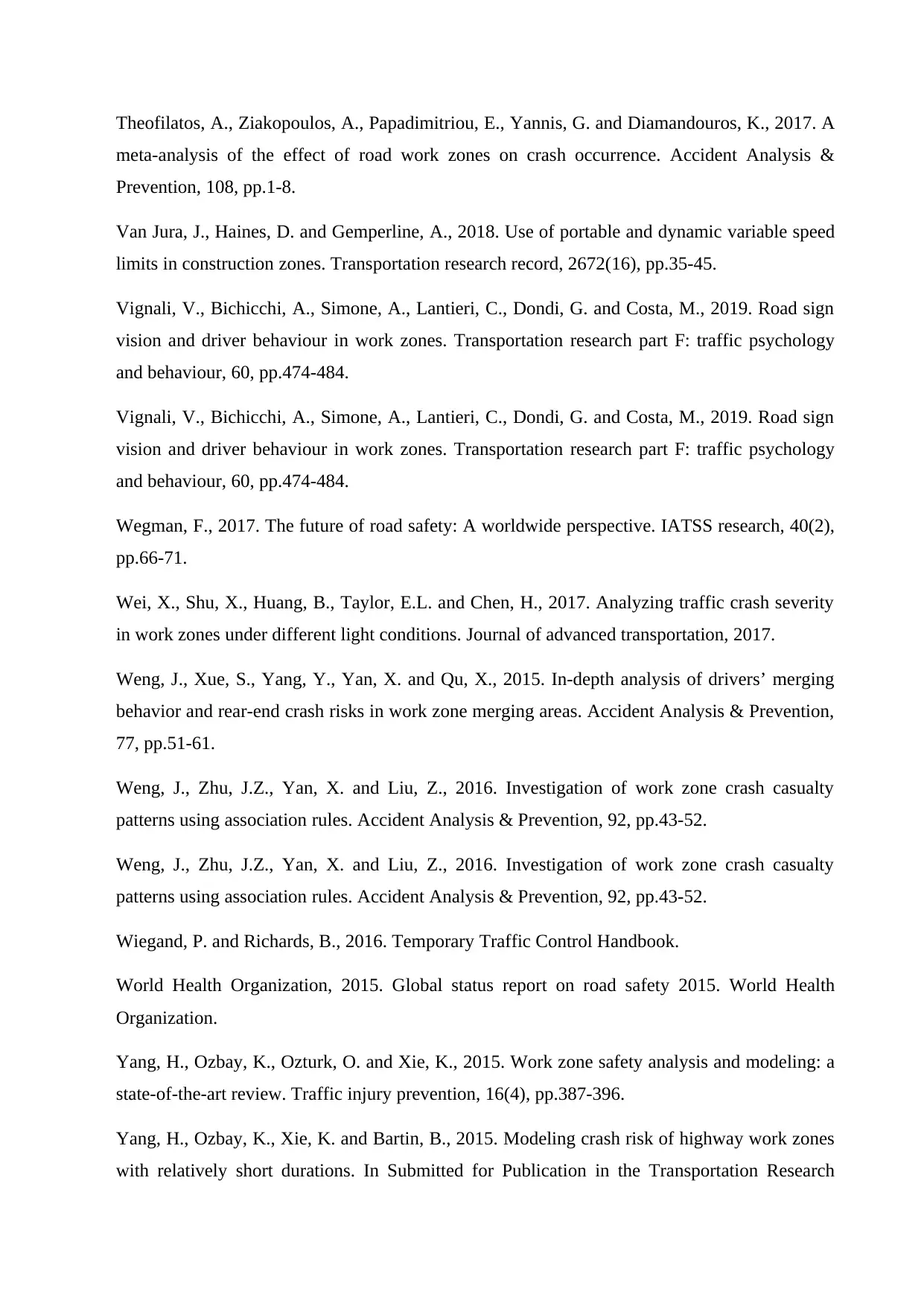
Theofilatos, A., Ziakopoulos, A., Papadimitriou, E., Yannis, G. and Diamandouros, K., 2017. A
meta-analysis of the effect of road work zones on crash occurrence. Accident Analysis &
Prevention, 108, pp.1-8.
Van Jura, J., Haines, D. and Gemperline, A., 2018. Use of portable and dynamic variable speed
limits in construction zones. Transportation research record, 2672(16), pp.35-45.
Vignali, V., Bichicchi, A., Simone, A., Lantieri, C., Dondi, G. and Costa, M., 2019. Road sign
vision and driver behaviour in work zones. Transportation research part F: traffic psychology
and behaviour, 60, pp.474-484.
Vignali, V., Bichicchi, A., Simone, A., Lantieri, C., Dondi, G. and Costa, M., 2019. Road sign
vision and driver behaviour in work zones. Transportation research part F: traffic psychology
and behaviour, 60, pp.474-484.
Wegman, F., 2017. The future of road safety: A worldwide perspective. IATSS research, 40(2),
pp.66-71.
Wei, X., Shu, X., Huang, B., Taylor, E.L. and Chen, H., 2017. Analyzing traffic crash severity
in work zones under different light conditions. Journal of advanced transportation, 2017.
Weng, J., Xue, S., Yang, Y., Yan, X. and Qu, X., 2015. In-depth analysis of drivers’ merging
behavior and rear-end crash risks in work zone merging areas. Accident Analysis & Prevention,
77, pp.51-61.
Weng, J., Zhu, J.Z., Yan, X. and Liu, Z., 2016. Investigation of work zone crash casualty
patterns using association rules. Accident Analysis & Prevention, 92, pp.43-52.
Weng, J., Zhu, J.Z., Yan, X. and Liu, Z., 2016. Investigation of work zone crash casualty
patterns using association rules. Accident Analysis & Prevention, 92, pp.43-52.
Wiegand, P. and Richards, B., 2016. Temporary Traffic Control Handbook.
World Health Organization, 2015. Global status report on road safety 2015. World Health
Organization.
Yang, H., Ozbay, K., Ozturk, O. and Xie, K., 2015. Work zone safety analysis and modeling: a
state-of-the-art review. Traffic injury prevention, 16(4), pp.387-396.
Yang, H., Ozbay, K., Xie, K. and Bartin, B., 2015. Modeling crash risk of highway work zones
with relatively short durations. In Submitted for Publication in the Transportation Research
meta-analysis of the effect of road work zones on crash occurrence. Accident Analysis &
Prevention, 108, pp.1-8.
Van Jura, J., Haines, D. and Gemperline, A., 2018. Use of portable and dynamic variable speed
limits in construction zones. Transportation research record, 2672(16), pp.35-45.
Vignali, V., Bichicchi, A., Simone, A., Lantieri, C., Dondi, G. and Costa, M., 2019. Road sign
vision and driver behaviour in work zones. Transportation research part F: traffic psychology
and behaviour, 60, pp.474-484.
Vignali, V., Bichicchi, A., Simone, A., Lantieri, C., Dondi, G. and Costa, M., 2019. Road sign
vision and driver behaviour in work zones. Transportation research part F: traffic psychology
and behaviour, 60, pp.474-484.
Wegman, F., 2017. The future of road safety: A worldwide perspective. IATSS research, 40(2),
pp.66-71.
Wei, X., Shu, X., Huang, B., Taylor, E.L. and Chen, H., 2017. Analyzing traffic crash severity
in work zones under different light conditions. Journal of advanced transportation, 2017.
Weng, J., Xue, S., Yang, Y., Yan, X. and Qu, X., 2015. In-depth analysis of drivers’ merging
behavior and rear-end crash risks in work zone merging areas. Accident Analysis & Prevention,
77, pp.51-61.
Weng, J., Zhu, J.Z., Yan, X. and Liu, Z., 2016. Investigation of work zone crash casualty
patterns using association rules. Accident Analysis & Prevention, 92, pp.43-52.
Weng, J., Zhu, J.Z., Yan, X. and Liu, Z., 2016. Investigation of work zone crash casualty
patterns using association rules. Accident Analysis & Prevention, 92, pp.43-52.
Wiegand, P. and Richards, B., 2016. Temporary Traffic Control Handbook.
World Health Organization, 2015. Global status report on road safety 2015. World Health
Organization.
Yang, H., Ozbay, K., Ozturk, O. and Xie, K., 2015. Work zone safety analysis and modeling: a
state-of-the-art review. Traffic injury prevention, 16(4), pp.387-396.
Yang, H., Ozbay, K., Xie, K. and Bartin, B., 2015. Modeling crash risk of highway work zones
with relatively short durations. In Submitted for Publication in the Transportation Research
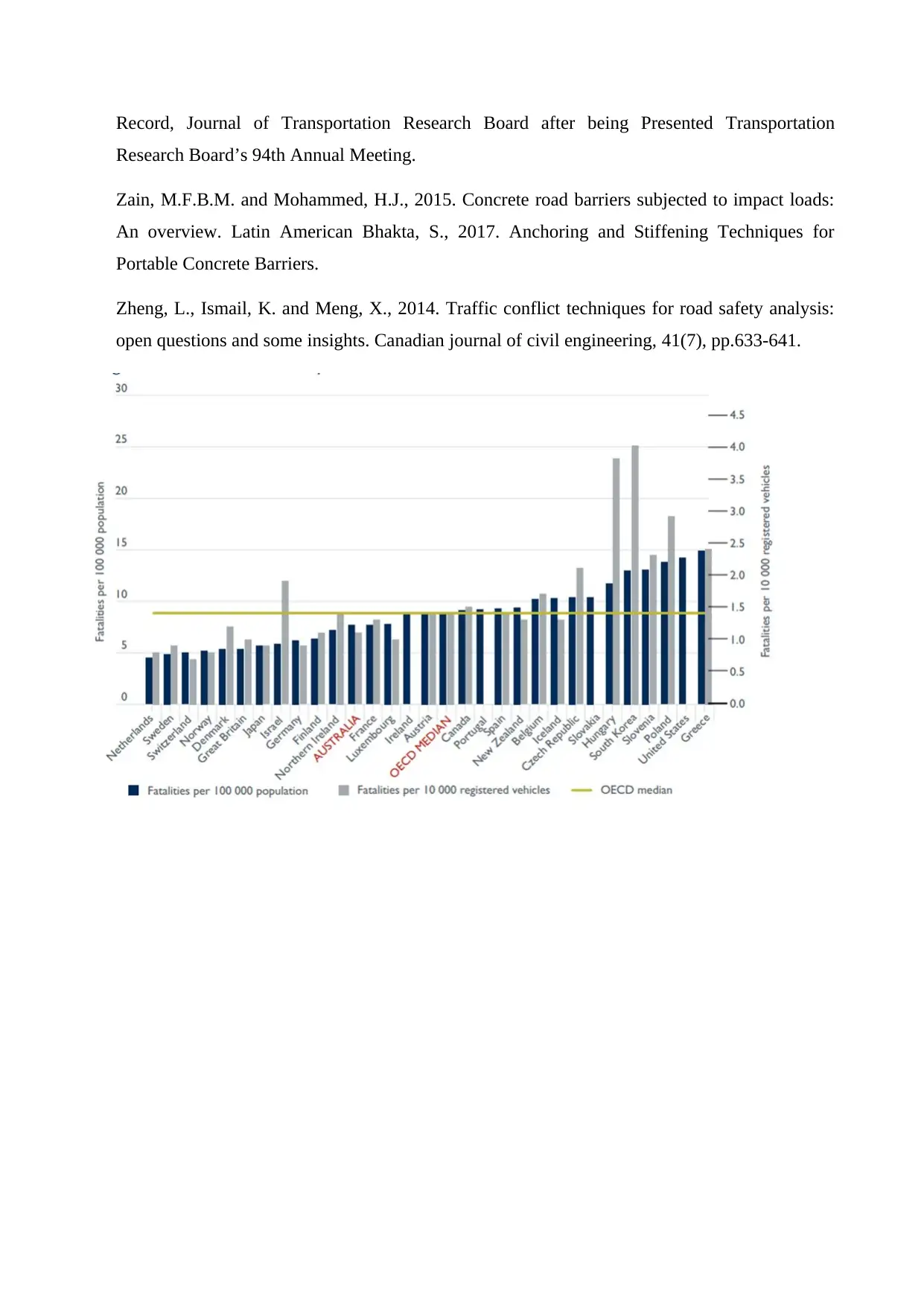
Record, Journal of Transportation Research Board after being Presented Transportation
Research Board’s 94th Annual Meeting.
Zain, M.F.B.M. and Mohammed, H.J., 2015. Concrete road barriers subjected to impact loads:
An overview. Latin American Bhakta, S., 2017. Anchoring and Stiffening Techniques for
Portable Concrete Barriers.
Zheng, L., Ismail, K. and Meng, X., 2014. Traffic conflict techniques for road safety analysis:
open questions and some insights. Canadian journal of civil engineering, 41(7), pp.633-641.
Research Board’s 94th Annual Meeting.
Zain, M.F.B.M. and Mohammed, H.J., 2015. Concrete road barriers subjected to impact loads:
An overview. Latin American Bhakta, S., 2017. Anchoring and Stiffening Techniques for
Portable Concrete Barriers.
Zheng, L., Ismail, K. and Meng, X., 2014. Traffic conflict techniques for road safety analysis:
open questions and some insights. Canadian journal of civil engineering, 41(7), pp.633-641.
Secure Best Marks with AI Grader
Need help grading? Try our AI Grader for instant feedback on your assignments.
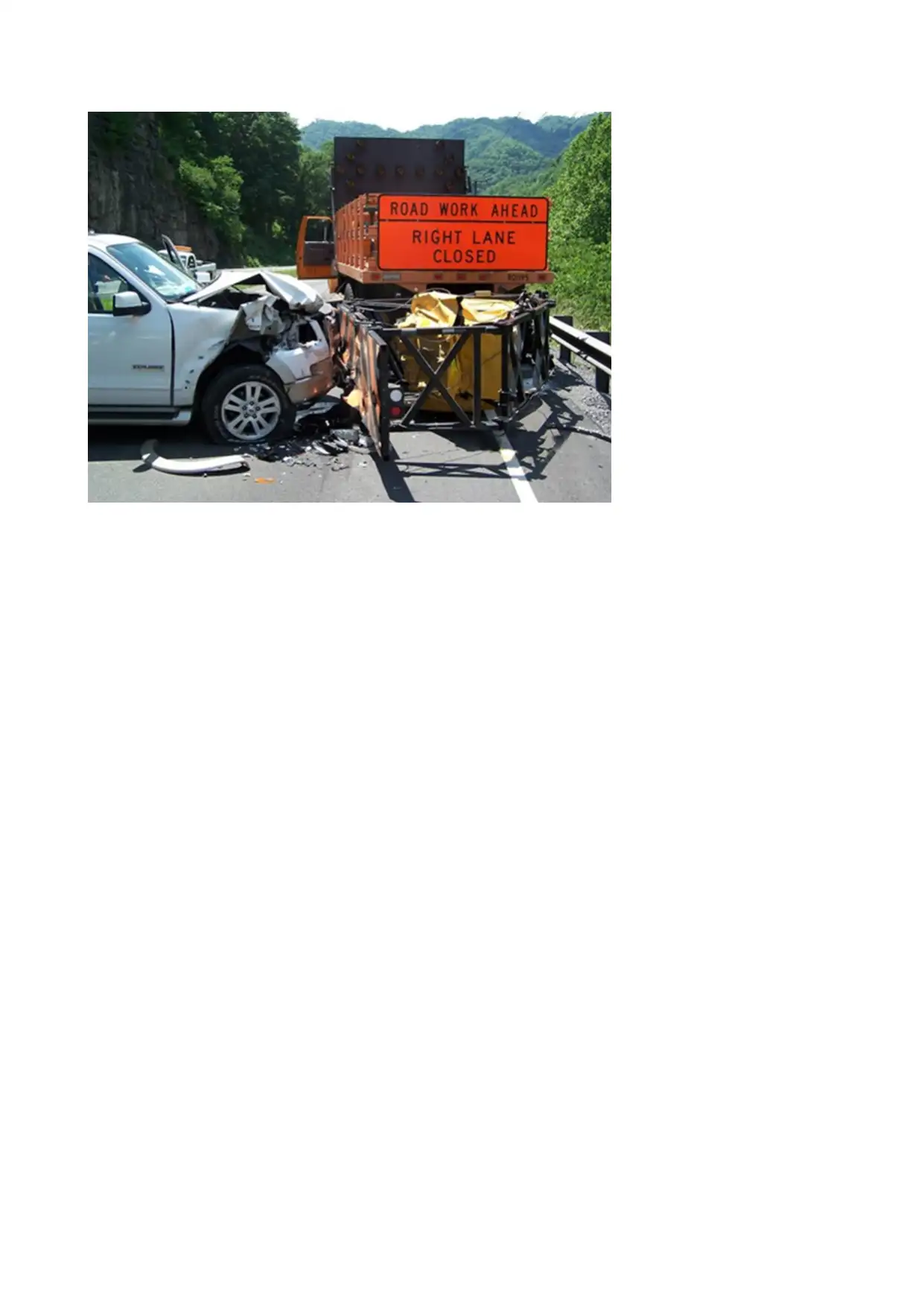
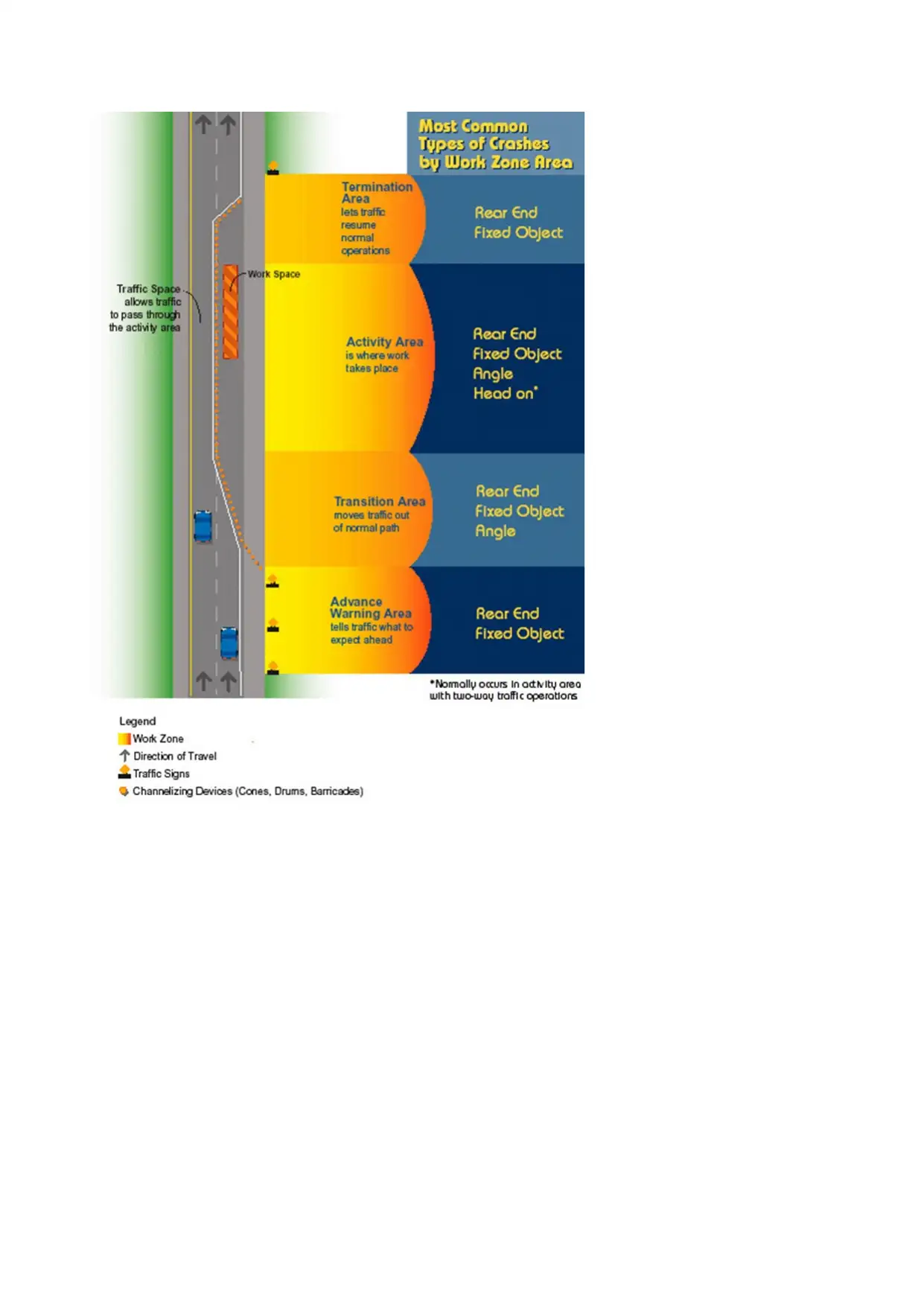
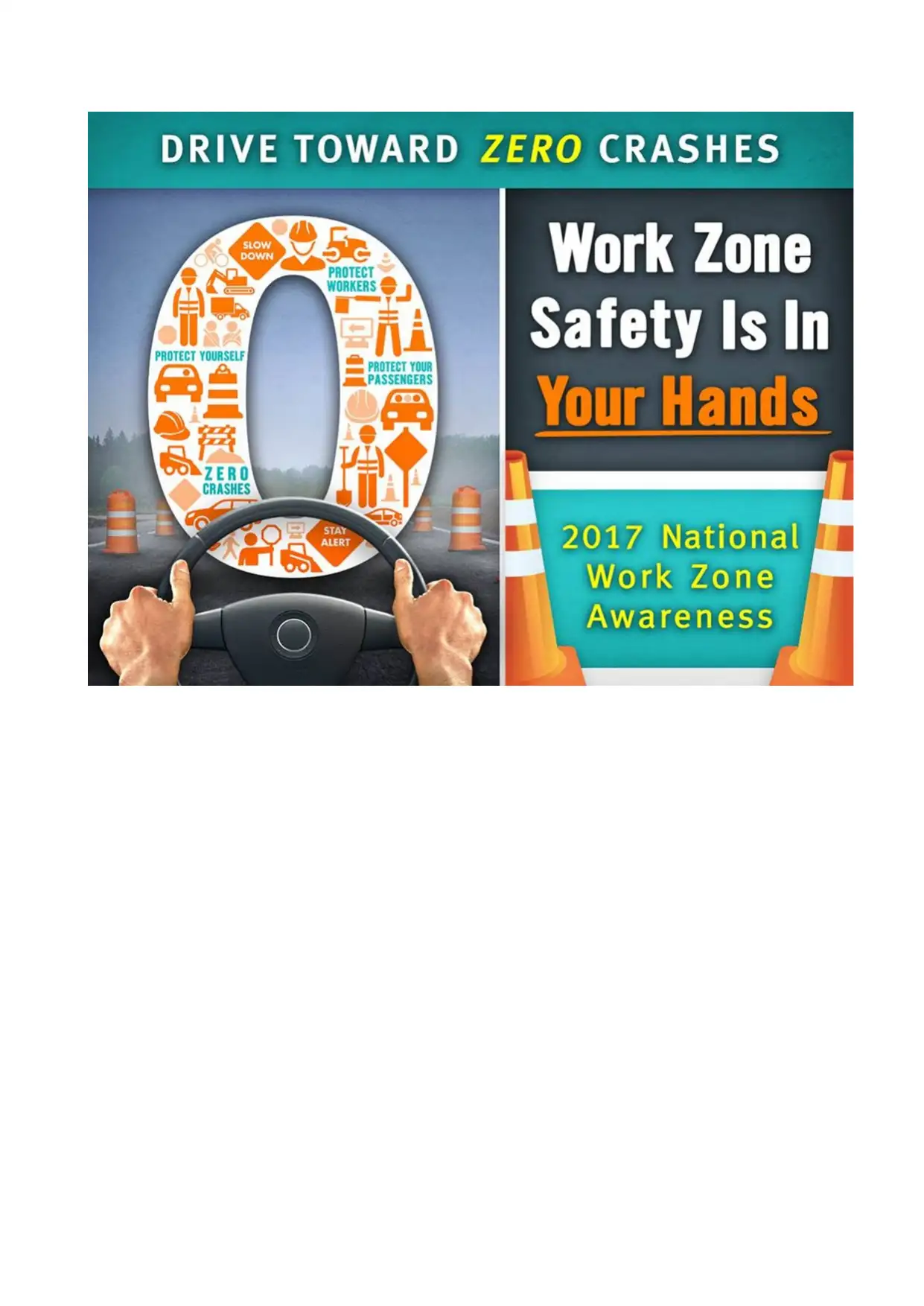
Paraphrase This Document
Need a fresh take? Get an instant paraphrase of this document with our AI Paraphraser
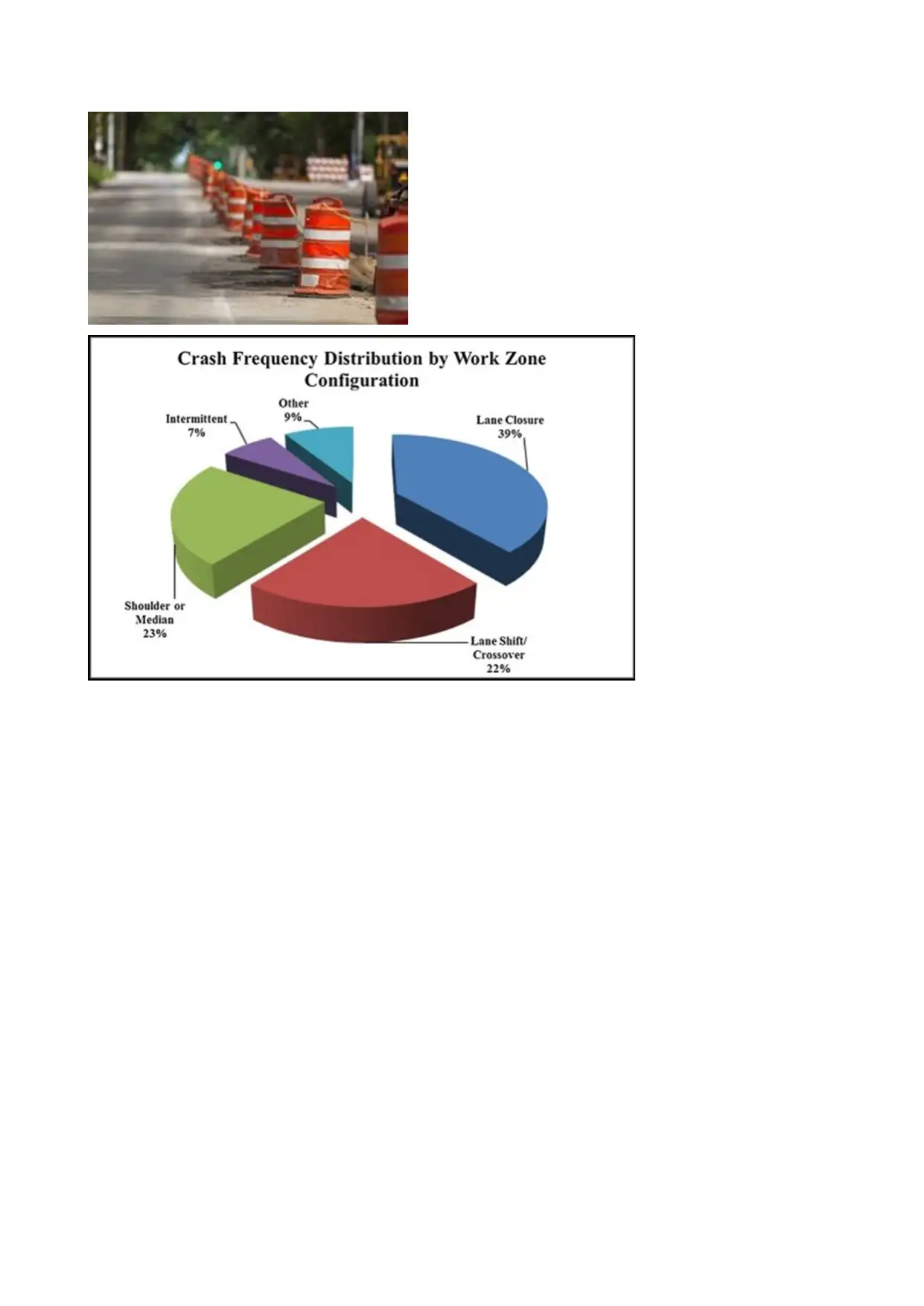
1 out of 50
Your All-in-One AI-Powered Toolkit for Academic Success.
+13062052269
info@desklib.com
Available 24*7 on WhatsApp / Email
![[object Object]](/_next/static/media/star-bottom.7253800d.svg)
Unlock your academic potential
© 2024 | Zucol Services PVT LTD | All rights reserved.
